Analysis of Unilever Balance Sheet and Income Statement
VerifiedAdded on 2023/01/17
|37
|11856
|90
AI Summary
The report discusses the detail analysis of Unilever Balance Sheet and Income Statement from 2008-2010. The purpose of this report is to determine the overall trend in profit and net income; liquidity; credit risk and profitability.
Contribute Materials
Your contribution can guide someone’s learning journey. Share your
documents today.
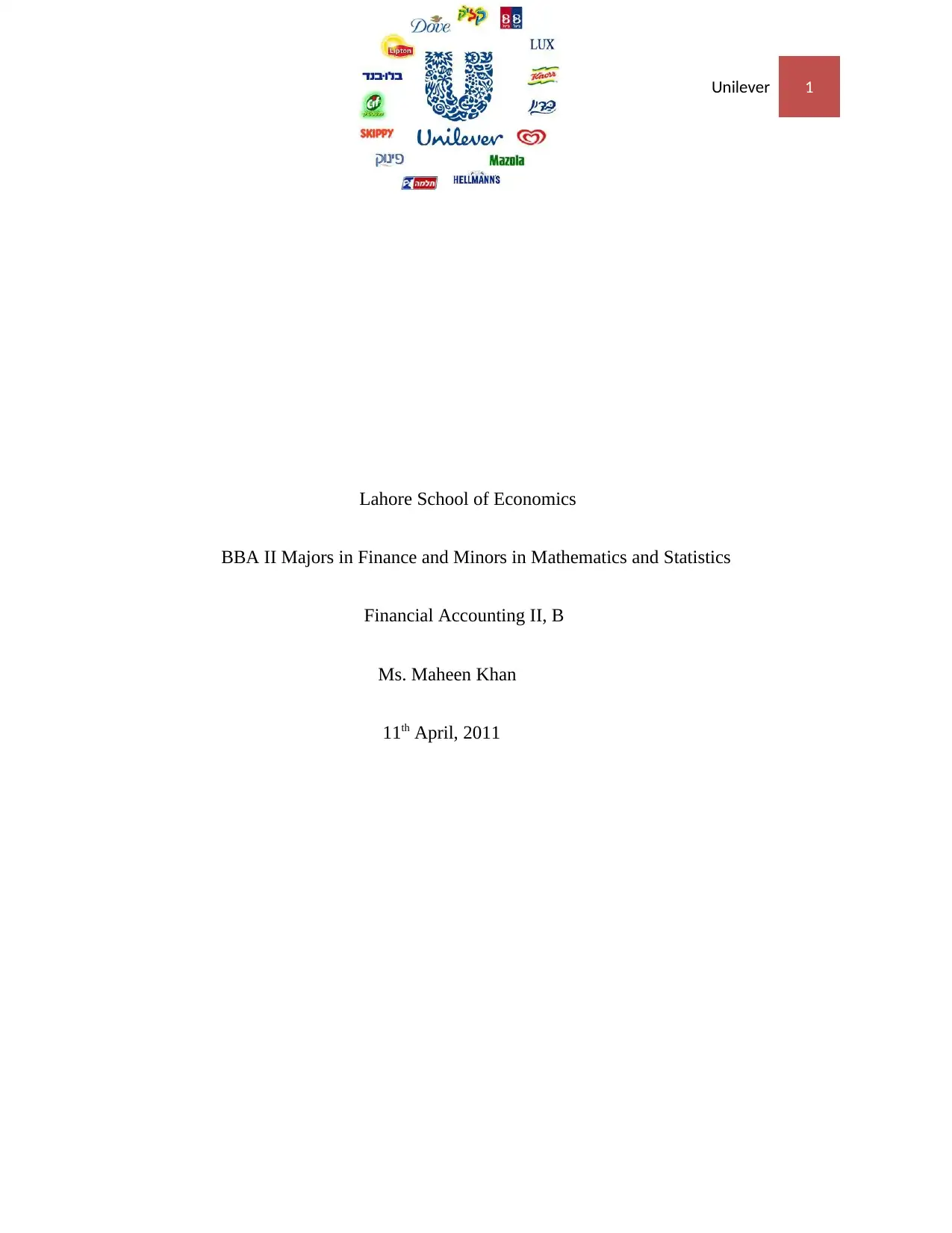
Unilever 1
Lahore School of Economics
BBA II Majors in Finance and Minors in Mathematics and Statistics
Financial Accounting II, B
Ms. Maheen Khan
11th April, 2011
Lahore School of Economics
BBA II Majors in Finance and Minors in Mathematics and Statistics
Financial Accounting II, B
Ms. Maheen Khan
11th April, 2011
Secure Best Marks with AI Grader
Need help grading? Try our AI Grader for instant feedback on your assignments.
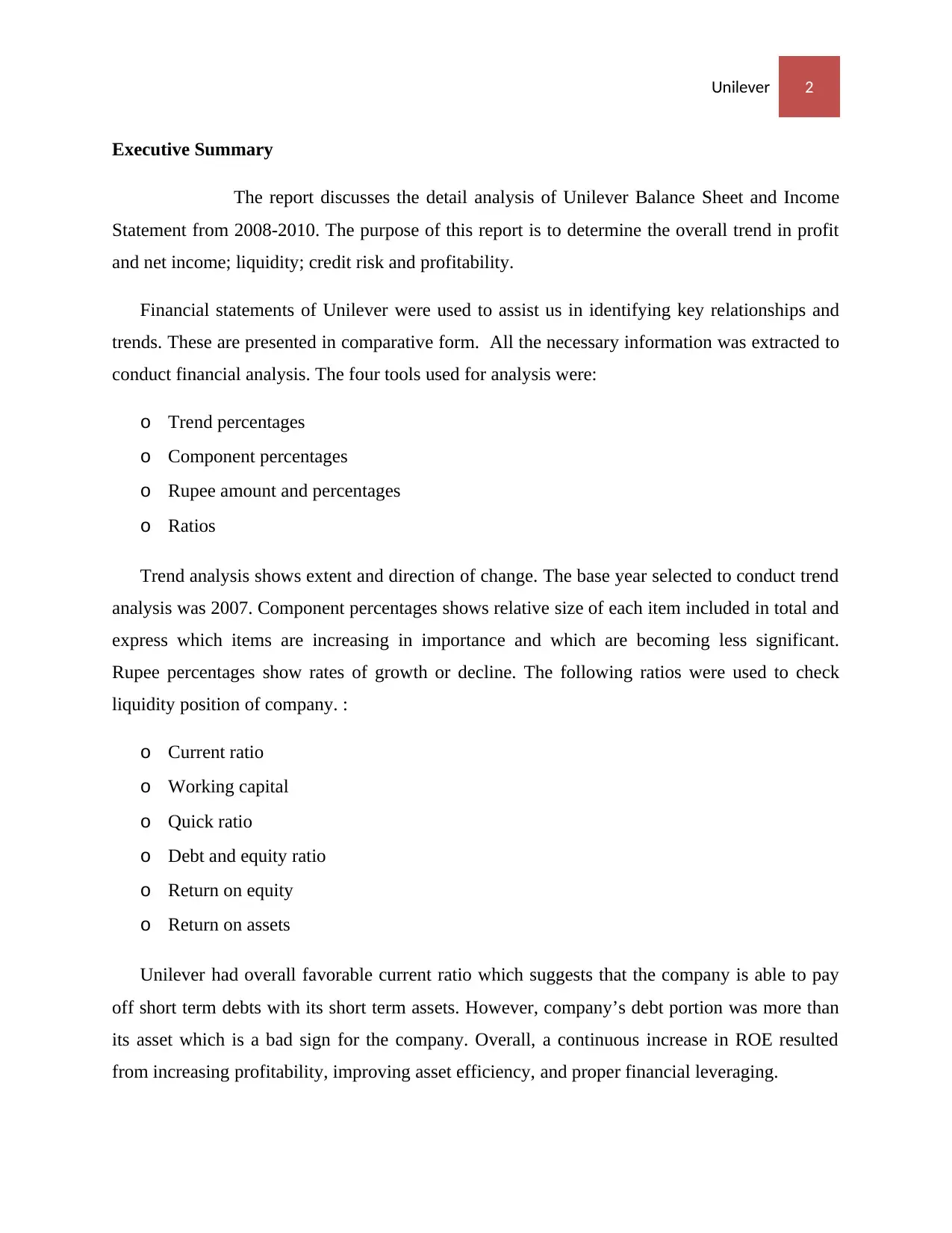
Unilever 2
Executive Summary
The report discusses the detail analysis of Unilever Balance Sheet and Income
Statement from 2008-2010. The purpose of this report is to determine the overall trend in profit
and net income; liquidity; credit risk and profitability.
Financial statements of Unilever were used to assist us in identifying key relationships and
trends. These are presented in comparative form. All the necessary information was extracted to
conduct financial analysis. The four tools used for analysis were:
o Trend percentages
o Component percentages
o Rupee amount and percentages
o Ratios
Trend analysis shows extent and direction of change. The base year selected to conduct trend
analysis was 2007. Component percentages shows relative size of each item included in total and
express which items are increasing in importance and which are becoming less significant.
Rupee percentages show rates of growth or decline. The following ratios were used to check
liquidity position of company. :
o Current ratio
o Working capital
o Quick ratio
o Debt and equity ratio
o Return on equity
o Return on assets
Unilever had overall favorable current ratio which suggests that the company is able to pay
off short term debts with its short term assets. However, company’s debt portion was more than
its asset which is a bad sign for the company. Overall, a continuous increase in ROE resulted
from increasing profitability, improving asset efficiency, and proper financial leveraging.
Executive Summary
The report discusses the detail analysis of Unilever Balance Sheet and Income
Statement from 2008-2010. The purpose of this report is to determine the overall trend in profit
and net income; liquidity; credit risk and profitability.
Financial statements of Unilever were used to assist us in identifying key relationships and
trends. These are presented in comparative form. All the necessary information was extracted to
conduct financial analysis. The four tools used for analysis were:
o Trend percentages
o Component percentages
o Rupee amount and percentages
o Ratios
Trend analysis shows extent and direction of change. The base year selected to conduct trend
analysis was 2007. Component percentages shows relative size of each item included in total and
express which items are increasing in importance and which are becoming less significant.
Rupee percentages show rates of growth or decline. The following ratios were used to check
liquidity position of company. :
o Current ratio
o Working capital
o Quick ratio
o Debt and equity ratio
o Return on equity
o Return on assets
Unilever had overall favorable current ratio which suggests that the company is able to pay
off short term debts with its short term assets. However, company’s debt portion was more than
its asset which is a bad sign for the company. Overall, a continuous increase in ROE resulted
from increasing profitability, improving asset efficiency, and proper financial leveraging.
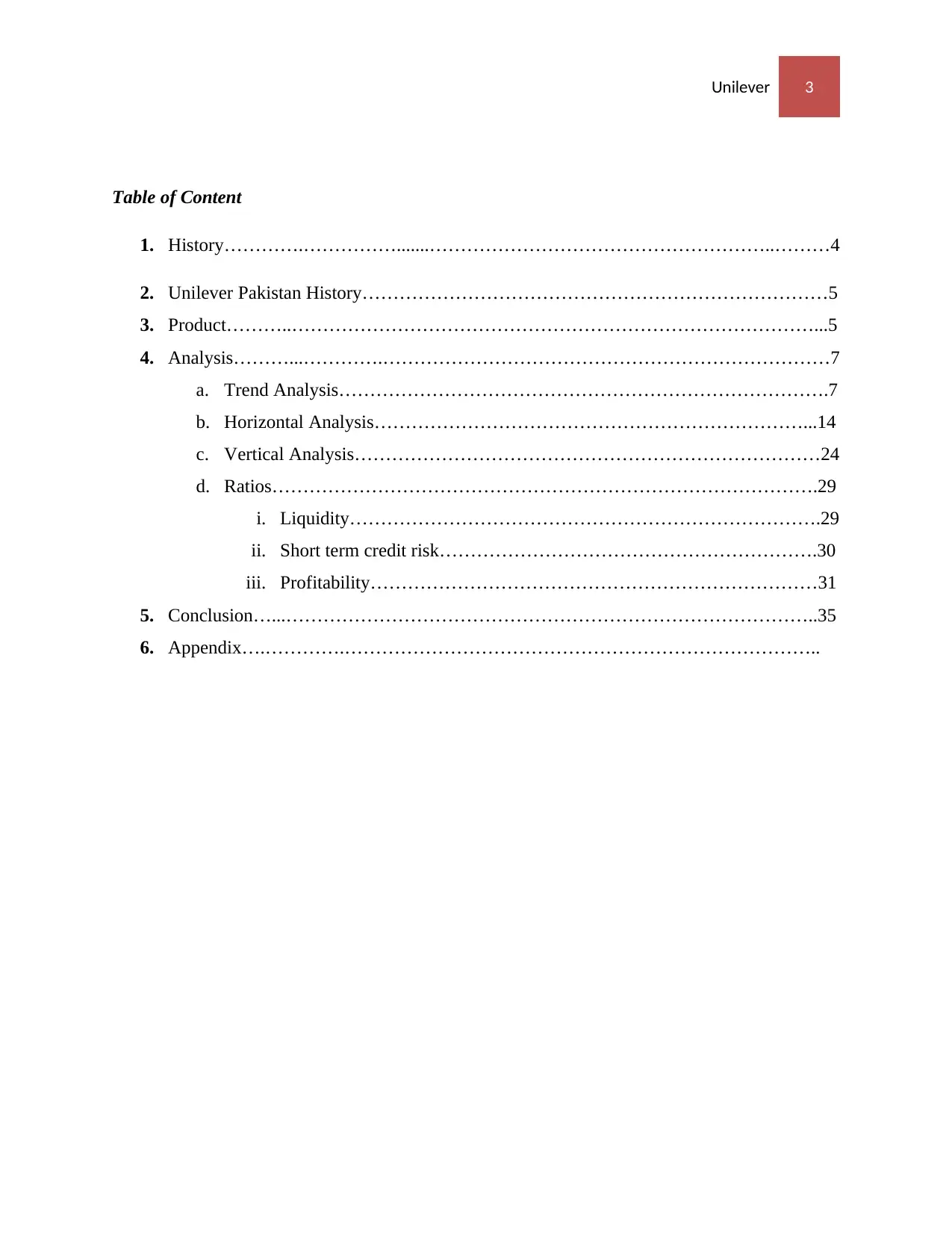
Unilever 3
Table of Content
1. History………….…………….......………………………………………………..………4
2. Unilever Pakistan History…………………………………………………………………5
3. Product………..…………………………………………………………………………...5
4. Analysis………...………….………………………………………………………………7
a. Trend Analysis…………………………………………………………………….7
b. Horizontal Analysis……………………………………………………………...14
c. Vertical Analysis…………………………………………………………………24
d. Ratios…………………………………………………………………………….29
i. Liquidity………………………………………………………………….29
ii. Short term credit risk…………………………………………………….30
iii. Profitability………………………………………………………………31
5. Conclusion…...…………………………………………………………………………..35
6. Appendix….………….…………………………………………………………………..
Table of Content
1. History………….…………….......………………………………………………..………4
2. Unilever Pakistan History…………………………………………………………………5
3. Product………..…………………………………………………………………………...5
4. Analysis………...………….………………………………………………………………7
a. Trend Analysis…………………………………………………………………….7
b. Horizontal Analysis……………………………………………………………...14
c. Vertical Analysis…………………………………………………………………24
d. Ratios…………………………………………………………………………….29
i. Liquidity………………………………………………………………….29
ii. Short term credit risk…………………………………………………….30
iii. Profitability………………………………………………………………31
5. Conclusion…...…………………………………………………………………………..35
6. Appendix….………….…………………………………………………………………..
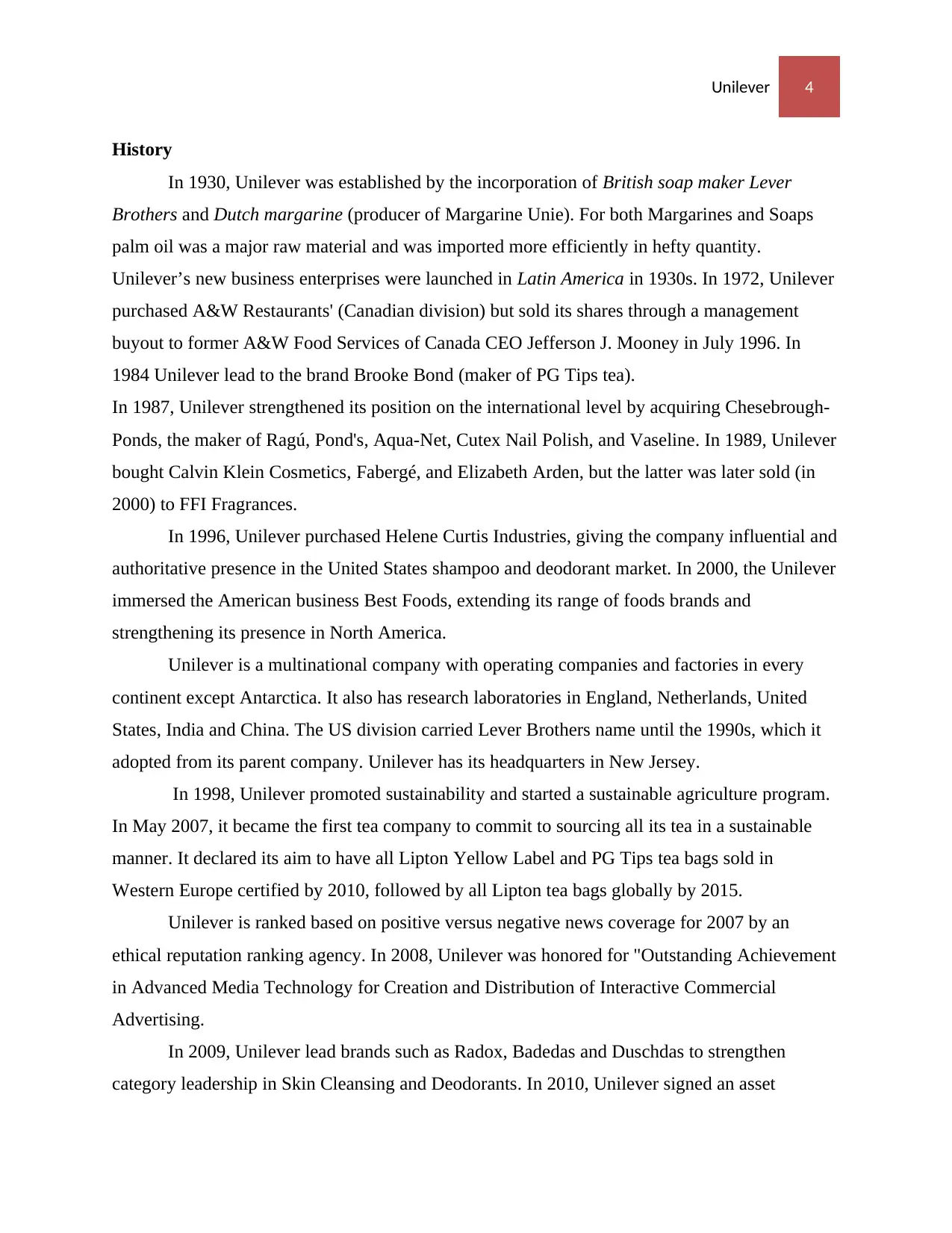
Unilever 4
History
In 1930, Unilever was established by the incorporation of British soap maker Lever
Brothers and Dutch margarine (producer of Margarine Unie). For both Margarines and Soaps
palm oil was a major raw material and was imported more efficiently in hefty quantity.
Unilever’s new business enterprises were launched in Latin America in 1930s. In 1972, Unilever
purchased A&W Restaurants' (Canadian division) but sold its shares through a management
buyout to former A&W Food Services of Canada CEO Jefferson J. Mooney in July 1996. In
1984 Unilever lead to the brand Brooke Bond (maker of PG Tips tea).
In 1987, Unilever strengthened its position on the international level by acquiring Chesebrough-
Ponds, the maker of Ragú, Pond's, Aqua-Net, Cutex Nail Polish, and Vaseline. In 1989, Unilever
bought Calvin Klein Cosmetics, Fabergé, and Elizabeth Arden, but the latter was later sold (in
2000) to FFI Fragrances.
In 1996, Unilever purchased Helene Curtis Industries, giving the company influential and
authoritative presence in the United States shampoo and deodorant market. In 2000, the Unilever
immersed the American business Best Foods, extending its range of foods brands and
strengthening its presence in North America.
Unilever is a multinational company with operating companies and factories in every
continent except Antarctica. It also has research laboratories in England, Netherlands, United
States, India and China. The US division carried Lever Brothers name until the 1990s, which it
adopted from its parent company. Unilever has its headquarters in New Jersey.
In 1998, Unilever promoted sustainability and started a sustainable agriculture program.
In May 2007, it became the first tea company to commit to sourcing all its tea in a sustainable
manner. It declared its aim to have all Lipton Yellow Label and PG Tips tea bags sold in
Western Europe certified by 2010, followed by all Lipton tea bags globally by 2015.
Unilever is ranked based on positive versus negative news coverage for 2007 by an
ethical reputation ranking agency. In 2008, Unilever was honored for "Outstanding Achievement
in Advanced Media Technology for Creation and Distribution of Interactive Commercial
Advertising.
In 2009, Unilever lead brands such as Radox, Badedas and Duschdas to strengthen
category leadership in Skin Cleansing and Deodorants. In 2010, Unilever signed an asset
History
In 1930, Unilever was established by the incorporation of British soap maker Lever
Brothers and Dutch margarine (producer of Margarine Unie). For both Margarines and Soaps
palm oil was a major raw material and was imported more efficiently in hefty quantity.
Unilever’s new business enterprises were launched in Latin America in 1930s. In 1972, Unilever
purchased A&W Restaurants' (Canadian division) but sold its shares through a management
buyout to former A&W Food Services of Canada CEO Jefferson J. Mooney in July 1996. In
1984 Unilever lead to the brand Brooke Bond (maker of PG Tips tea).
In 1987, Unilever strengthened its position on the international level by acquiring Chesebrough-
Ponds, the maker of Ragú, Pond's, Aqua-Net, Cutex Nail Polish, and Vaseline. In 1989, Unilever
bought Calvin Klein Cosmetics, Fabergé, and Elizabeth Arden, but the latter was later sold (in
2000) to FFI Fragrances.
In 1996, Unilever purchased Helene Curtis Industries, giving the company influential and
authoritative presence in the United States shampoo and deodorant market. In 2000, the Unilever
immersed the American business Best Foods, extending its range of foods brands and
strengthening its presence in North America.
Unilever is a multinational company with operating companies and factories in every
continent except Antarctica. It also has research laboratories in England, Netherlands, United
States, India and China. The US division carried Lever Brothers name until the 1990s, which it
adopted from its parent company. Unilever has its headquarters in New Jersey.
In 1998, Unilever promoted sustainability and started a sustainable agriculture program.
In May 2007, it became the first tea company to commit to sourcing all its tea in a sustainable
manner. It declared its aim to have all Lipton Yellow Label and PG Tips tea bags sold in
Western Europe certified by 2010, followed by all Lipton tea bags globally by 2015.
Unilever is ranked based on positive versus negative news coverage for 2007 by an
ethical reputation ranking agency. In 2008, Unilever was honored for "Outstanding Achievement
in Advanced Media Technology for Creation and Distribution of Interactive Commercial
Advertising.
In 2009, Unilever lead brands such as Radox, Badedas and Duschdas to strengthen
category leadership in Skin Cleansing and Deodorants. In 2010, Unilever signed an asset
Secure Best Marks with AI Grader
Need help grading? Try our AI Grader for instant feedback on your assignments.
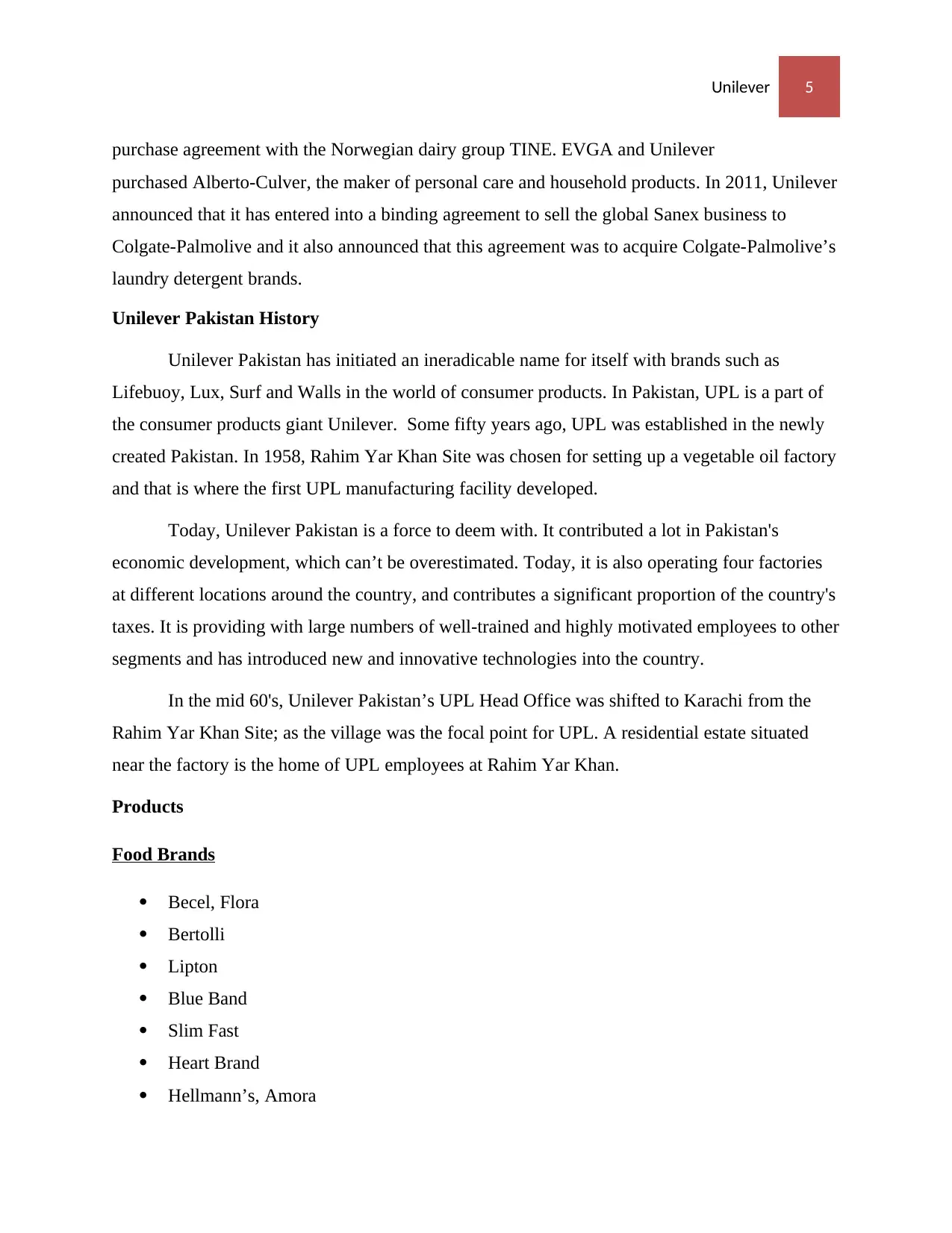
Unilever 5
purchase agreement with the Norwegian dairy group TINE. EVGA and Unilever
purchased Alberto-Culver, the maker of personal care and household products. In 2011, Unilever
announced that it has entered into a binding agreement to sell the global Sanex business to
Colgate-Palmolive and it also announced that this agreement was to acquire Colgate-Palmolive’s
laundry detergent brands.
Unilever Pakistan History
Unilever Pakistan has initiated an ineradicable name for itself with brands such as
Lifebuoy, Lux, Surf and Walls in the world of consumer products. In Pakistan, UPL is a part of
the consumer products giant Unilever. Some fifty years ago, UPL was established in the newly
created Pakistan. In 1958, Rahim Yar Khan Site was chosen for setting up a vegetable oil factory
and that is where the first UPL manufacturing facility developed.
Today, Unilever Pakistan is a force to deem with. It contributed a lot in Pakistan's
economic development, which can’t be overestimated. Today, it is also operating four factories
at different locations around the country, and contributes a significant proportion of the country's
taxes. It is providing with large numbers of well-trained and highly motivated employees to other
segments and has introduced new and innovative technologies into the country.
In the mid 60's, Unilever Pakistan’s UPL Head Office was shifted to Karachi from the
Rahim Yar Khan Site; as the village was the focal point for UPL. A residential estate situated
near the factory is the home of UPL employees at Rahim Yar Khan.
Products
Food Brands
Becel, Flora
Bertolli
Lipton
Blue Band
Slim Fast
Heart Brand
Hellmann’s, Amora
purchase agreement with the Norwegian dairy group TINE. EVGA and Unilever
purchased Alberto-Culver, the maker of personal care and household products. In 2011, Unilever
announced that it has entered into a binding agreement to sell the global Sanex business to
Colgate-Palmolive and it also announced that this agreement was to acquire Colgate-Palmolive’s
laundry detergent brands.
Unilever Pakistan History
Unilever Pakistan has initiated an ineradicable name for itself with brands such as
Lifebuoy, Lux, Surf and Walls in the world of consumer products. In Pakistan, UPL is a part of
the consumer products giant Unilever. Some fifty years ago, UPL was established in the newly
created Pakistan. In 1958, Rahim Yar Khan Site was chosen for setting up a vegetable oil factory
and that is where the first UPL manufacturing facility developed.
Today, Unilever Pakistan is a force to deem with. It contributed a lot in Pakistan's
economic development, which can’t be overestimated. Today, it is also operating four factories
at different locations around the country, and contributes a significant proportion of the country's
taxes. It is providing with large numbers of well-trained and highly motivated employees to other
segments and has introduced new and innovative technologies into the country.
In the mid 60's, Unilever Pakistan’s UPL Head Office was shifted to Karachi from the
Rahim Yar Khan Site; as the village was the focal point for UPL. A residential estate situated
near the factory is the home of UPL employees at Rahim Yar Khan.
Products
Food Brands
Becel, Flora
Bertolli
Lipton
Blue Band
Slim Fast
Heart Brand
Hellmann’s, Amora
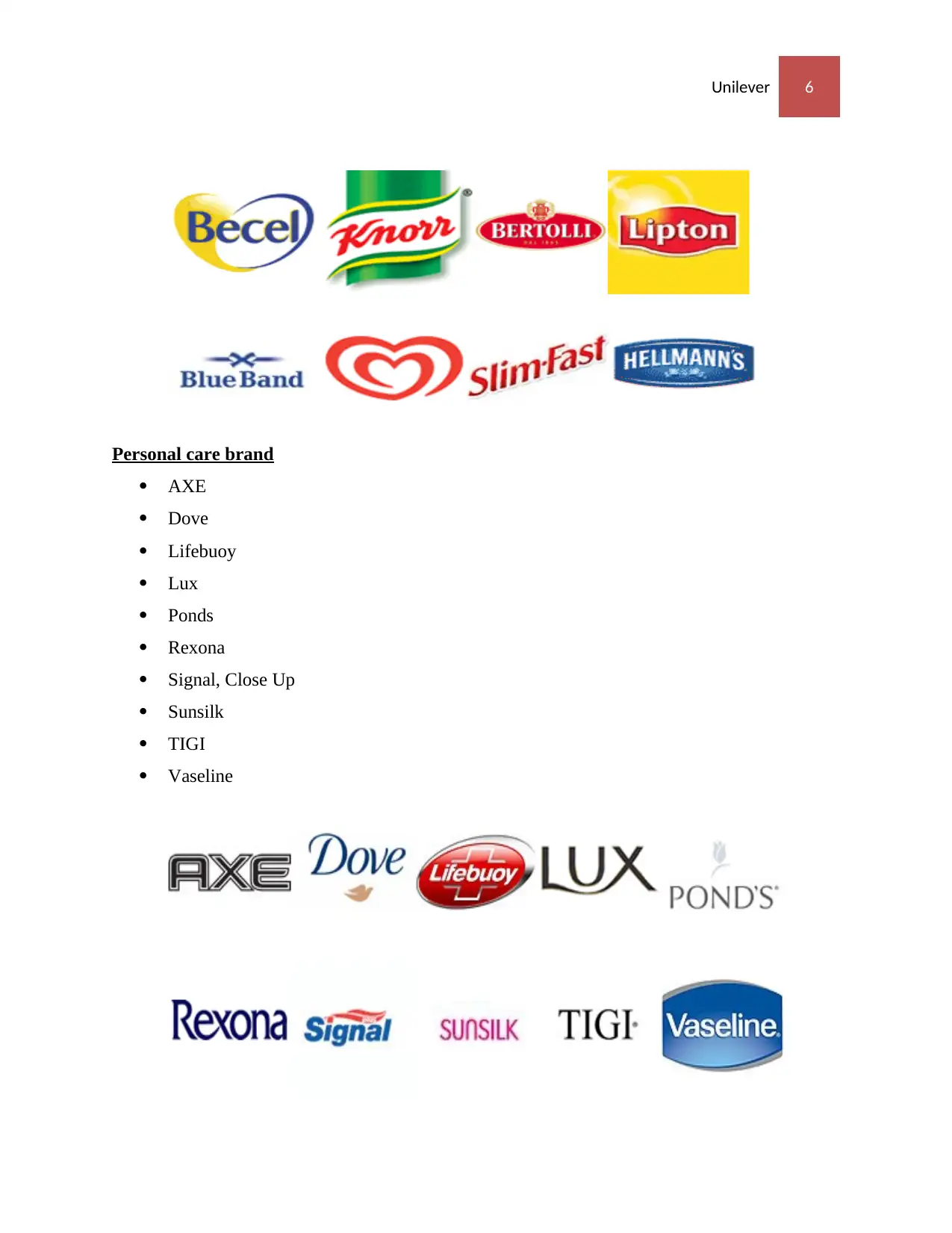
Unilever 6
Personal care brand
AXE
Dove
Lifebuoy
Lux
Ponds
Rexona
Signal, Close Up
Sunsilk
TIGI
Vaseline
Personal care brand
AXE
Dove
Lifebuoy
Lux
Ponds
Rexona
Signal, Close Up
Sunsilk
TIGI
Vaseline
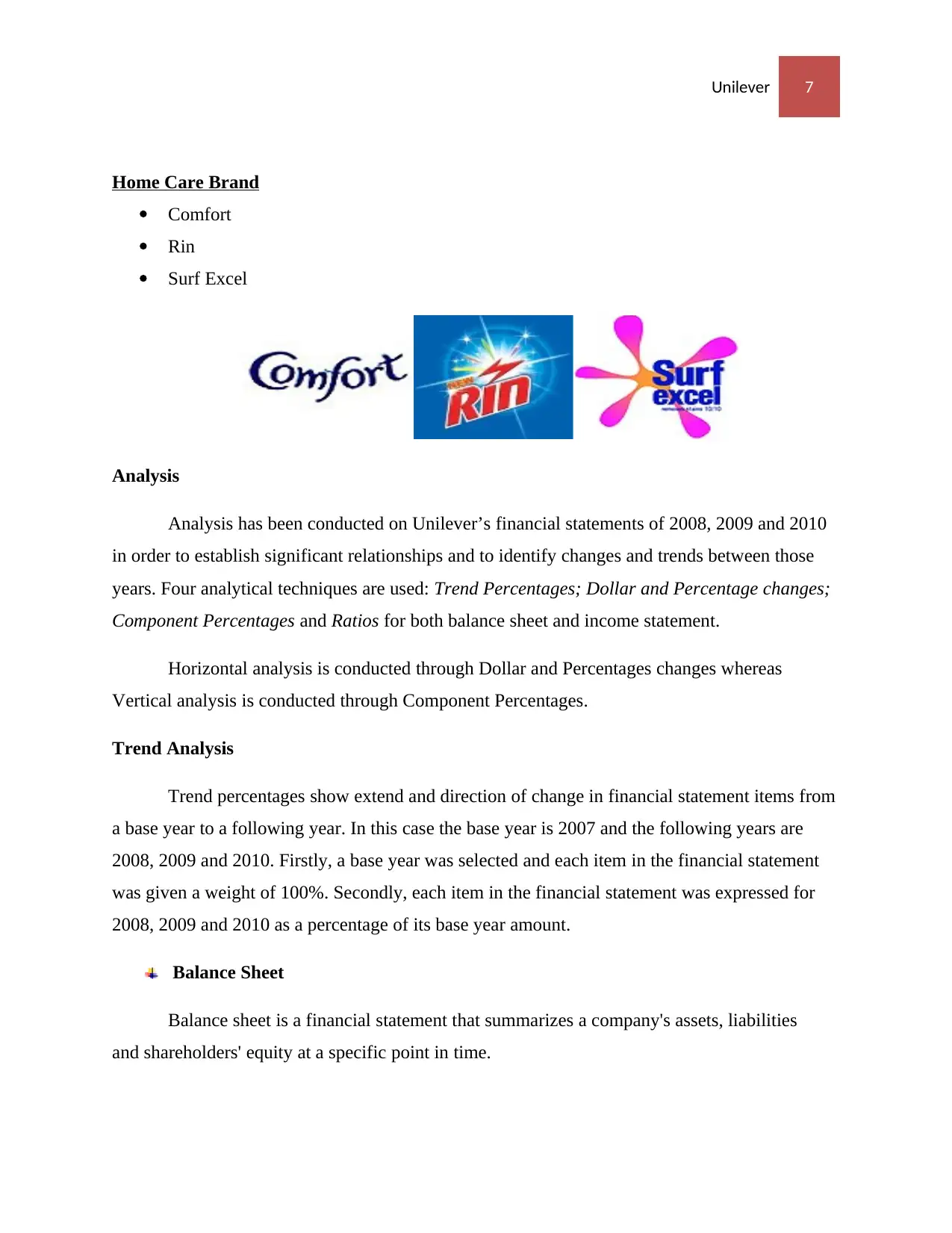
Unilever 7
Home Care Brand
Comfort
Rin
Surf Excel
Analysis
Analysis has been conducted on Unilever’s financial statements of 2008, 2009 and 2010
in order to establish significant relationships and to identify changes and trends between those
years. Four analytical techniques are used: Trend Percentages; Dollar and Percentage changes;
Component Percentages and Ratios for both balance sheet and income statement.
Horizontal analysis is conducted through Dollar and Percentages changes whereas
Vertical analysis is conducted through Component Percentages.
Trend Analysis
Trend percentages show extend and direction of change in financial statement items from
a base year to a following year. In this case the base year is 2007 and the following years are
2008, 2009 and 2010. Firstly, a base year was selected and each item in the financial statement
was given a weight of 100%. Secondly, each item in the financial statement was expressed for
2008, 2009 and 2010 as a percentage of its base year amount.
Balance Sheet
Balance sheet is a financial statement that summarizes a company's assets, liabilities
and shareholders' equity at a specific point in time.
Home Care Brand
Comfort
Rin
Surf Excel
Analysis
Analysis has been conducted on Unilever’s financial statements of 2008, 2009 and 2010
in order to establish significant relationships and to identify changes and trends between those
years. Four analytical techniques are used: Trend Percentages; Dollar and Percentage changes;
Component Percentages and Ratios for both balance sheet and income statement.
Horizontal analysis is conducted through Dollar and Percentages changes whereas
Vertical analysis is conducted through Component Percentages.
Trend Analysis
Trend percentages show extend and direction of change in financial statement items from
a base year to a following year. In this case the base year is 2007 and the following years are
2008, 2009 and 2010. Firstly, a base year was selected and each item in the financial statement
was given a weight of 100%. Secondly, each item in the financial statement was expressed for
2008, 2009 and 2010 as a percentage of its base year amount.
Balance Sheet
Balance sheet is a financial statement that summarizes a company's assets, liabilities
and shareholders' equity at a specific point in time.
Paraphrase This Document
Need a fresh take? Get an instant paraphrase of this document with our AI Paraphraser
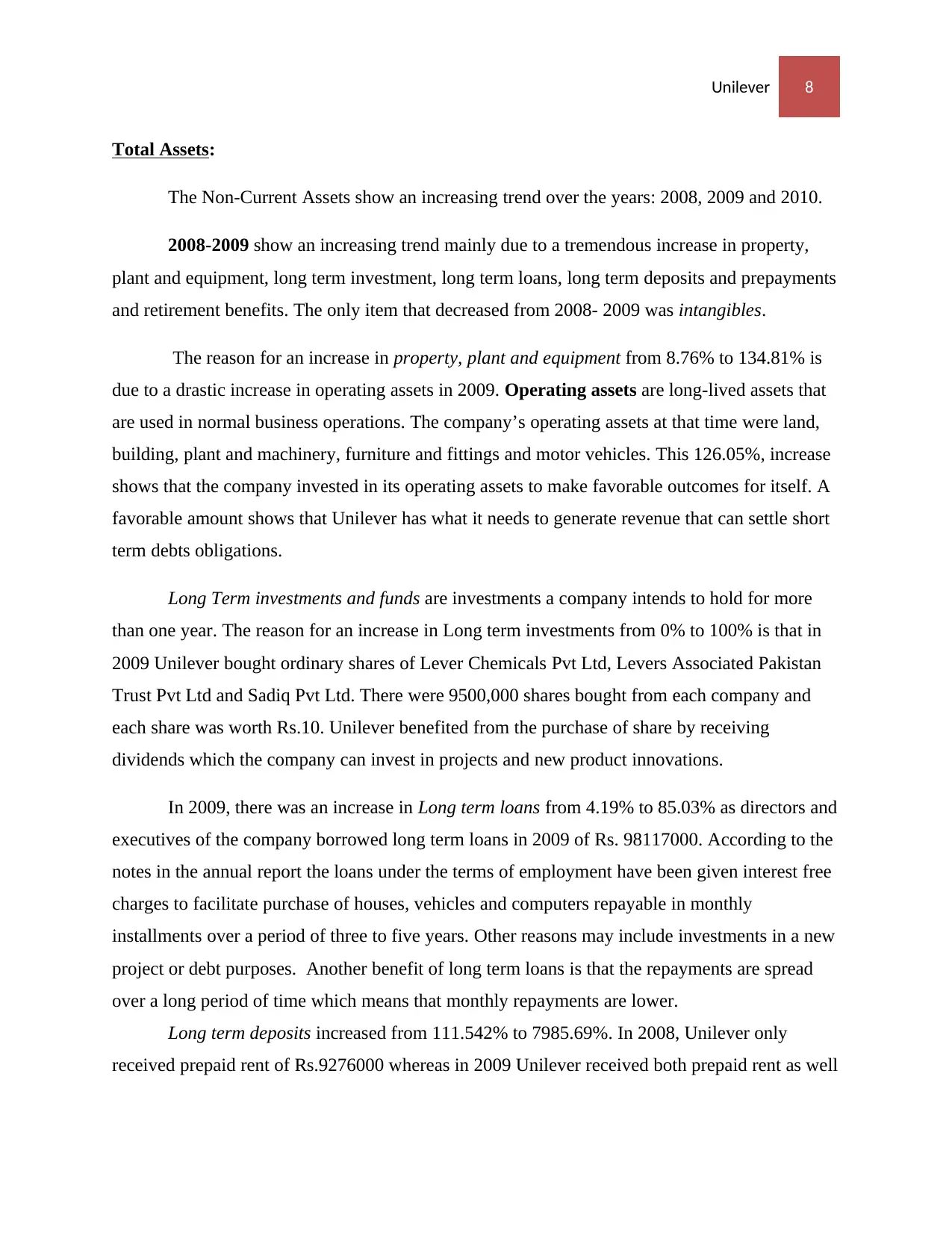
Unilever 8
Total Assets:
The Non-Current Assets show an increasing trend over the years: 2008, 2009 and 2010.
2008-2009 show an increasing trend mainly due to a tremendous increase in property,
plant and equipment, long term investment, long term loans, long term deposits and prepayments
and retirement benefits. The only item that decreased from 2008- 2009 was intangibles.
The reason for an increase in property, plant and equipment from 8.76% to 134.81% is
due to a drastic increase in operating assets in 2009. Operating assets are long-lived assets that
are used in normal business operations. The company’s operating assets at that time were land,
building, plant and machinery, furniture and fittings and motor vehicles. This 126.05%, increase
shows that the company invested in its operating assets to make favorable outcomes for itself. A
favorable amount shows that Unilever has what it needs to generate revenue that can settle short
term debts obligations.
Long Term investments and funds are investments a company intends to hold for more
than one year. The reason for an increase in Long term investments from 0% to 100% is that in
2009 Unilever bought ordinary shares of Lever Chemicals Pvt Ltd, Levers Associated Pakistan
Trust Pvt Ltd and Sadiq Pvt Ltd. There were 9500,000 shares bought from each company and
each share was worth Rs.10. Unilever benefited from the purchase of share by receiving
dividends which the company can invest in projects and new product innovations.
In 2009, there was an increase in Long term loans from 4.19% to 85.03% as directors and
executives of the company borrowed long term loans in 2009 of Rs. 98117000. According to the
notes in the annual report the loans under the terms of employment have been given interest free
charges to facilitate purchase of houses, vehicles and computers repayable in monthly
installments over a period of three to five years. Other reasons may include investments in a new
project or debt purposes. Another benefit of long term loans is that the repayments are spread
over a long period of time which means that monthly repayments are lower.
Long term deposits increased from 111.542% to 7985.69%. In 2008, Unilever only
received prepaid rent of Rs.9276000 whereas in 2009 Unilever received both prepaid rent as well
Total Assets:
The Non-Current Assets show an increasing trend over the years: 2008, 2009 and 2010.
2008-2009 show an increasing trend mainly due to a tremendous increase in property,
plant and equipment, long term investment, long term loans, long term deposits and prepayments
and retirement benefits. The only item that decreased from 2008- 2009 was intangibles.
The reason for an increase in property, plant and equipment from 8.76% to 134.81% is
due to a drastic increase in operating assets in 2009. Operating assets are long-lived assets that
are used in normal business operations. The company’s operating assets at that time were land,
building, plant and machinery, furniture and fittings and motor vehicles. This 126.05%, increase
shows that the company invested in its operating assets to make favorable outcomes for itself. A
favorable amount shows that Unilever has what it needs to generate revenue that can settle short
term debts obligations.
Long Term investments and funds are investments a company intends to hold for more
than one year. The reason for an increase in Long term investments from 0% to 100% is that in
2009 Unilever bought ordinary shares of Lever Chemicals Pvt Ltd, Levers Associated Pakistan
Trust Pvt Ltd and Sadiq Pvt Ltd. There were 9500,000 shares bought from each company and
each share was worth Rs.10. Unilever benefited from the purchase of share by receiving
dividends which the company can invest in projects and new product innovations.
In 2009, there was an increase in Long term loans from 4.19% to 85.03% as directors and
executives of the company borrowed long term loans in 2009 of Rs. 98117000. According to the
notes in the annual report the loans under the terms of employment have been given interest free
charges to facilitate purchase of houses, vehicles and computers repayable in monthly
installments over a period of three to five years. Other reasons may include investments in a new
project or debt purposes. Another benefit of long term loans is that the repayments are spread
over a long period of time which means that monthly repayments are lower.
Long term deposits increased from 111.542% to 7985.69%. In 2008, Unilever only
received prepaid rent of Rs.9276000 whereas in 2009 Unilever received both prepaid rent as well
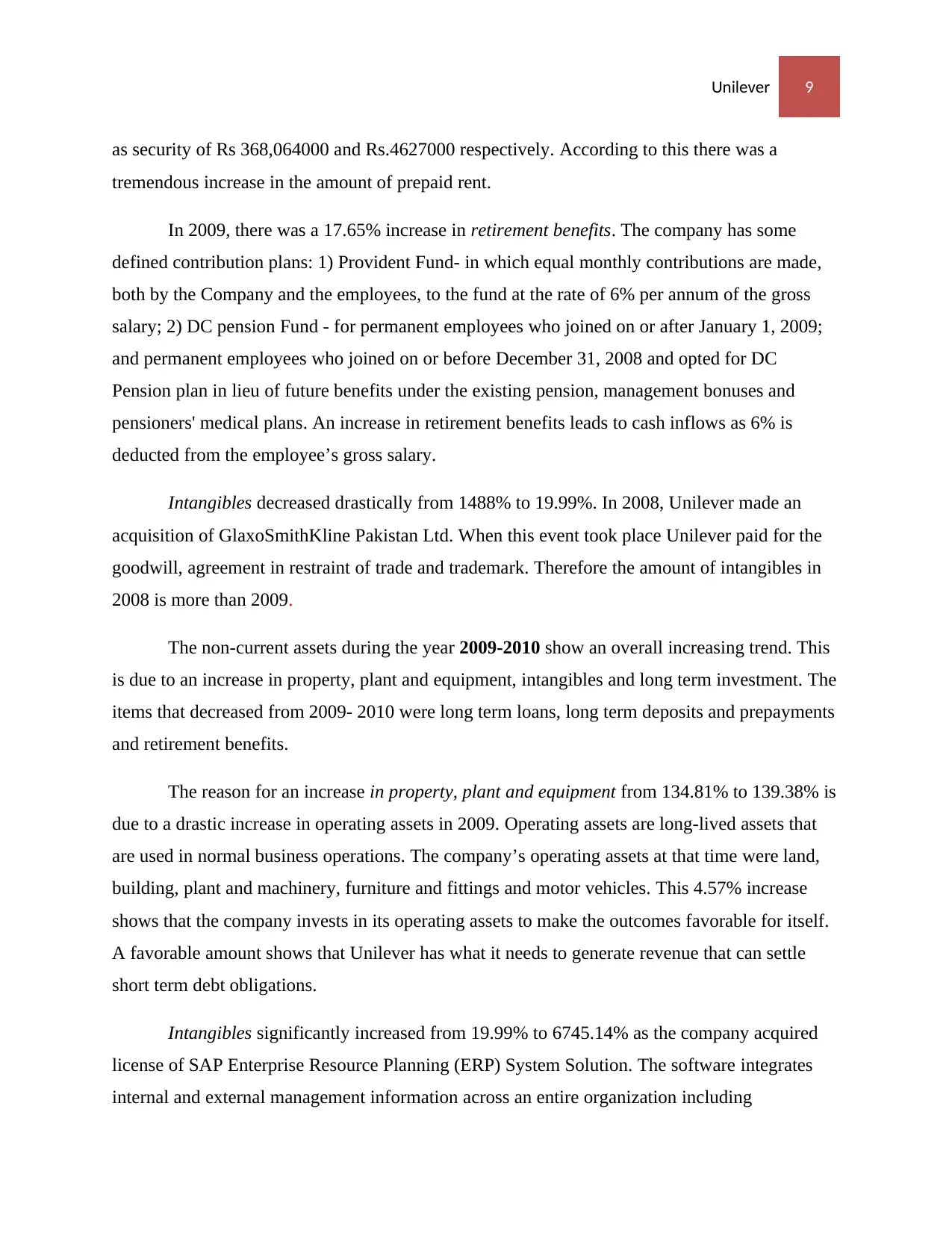
Unilever 9
as security of Rs 368,064000 and Rs.4627000 respectively. According to this there was a
tremendous increase in the amount of prepaid rent.
In 2009, there was a 17.65% increase in retirement benefits. The company has some
defined contribution plans: 1) Provident Fund- in which equal monthly contributions are made,
both by the Company and the employees, to the fund at the rate of 6% per annum of the gross
salary; 2) DC pension Fund - for permanent employees who joined on or after January 1, 2009;
and permanent employees who joined on or before December 31, 2008 and opted for DC
Pension plan in lieu of future benefits under the existing pension, management bonuses and
pensioners' medical plans. An increase in retirement benefits leads to cash inflows as 6% is
deducted from the employee’s gross salary.
Intangibles decreased drastically from 1488% to 19.99%. In 2008, Unilever made an
acquisition of GlaxoSmithKline Pakistan Ltd. When this event took place Unilever paid for the
goodwill, agreement in restraint of trade and trademark. Therefore the amount of intangibles in
2008 is more than 2009.
The non-current assets during the year 2009-2010 show an overall increasing trend. This
is due to an increase in property, plant and equipment, intangibles and long term investment. The
items that decreased from 2009- 2010 were long term loans, long term deposits and prepayments
and retirement benefits.
The reason for an increase in property, plant and equipment from 134.81% to 139.38% is
due to a drastic increase in operating assets in 2009. Operating assets are long-lived assets that
are used in normal business operations. The company’s operating assets at that time were land,
building, plant and machinery, furniture and fittings and motor vehicles. This 4.57% increase
shows that the company invests in its operating assets to make the outcomes favorable for itself.
A favorable amount shows that Unilever has what it needs to generate revenue that can settle
short term debt obligations.
Intangibles significantly increased from 19.99% to 6745.14% as the company acquired
license of SAP Enterprise Resource Planning (ERP) System Solution. The software integrates
internal and external management information across an entire organization including
as security of Rs 368,064000 and Rs.4627000 respectively. According to this there was a
tremendous increase in the amount of prepaid rent.
In 2009, there was a 17.65% increase in retirement benefits. The company has some
defined contribution plans: 1) Provident Fund- in which equal monthly contributions are made,
both by the Company and the employees, to the fund at the rate of 6% per annum of the gross
salary; 2) DC pension Fund - for permanent employees who joined on or after January 1, 2009;
and permanent employees who joined on or before December 31, 2008 and opted for DC
Pension plan in lieu of future benefits under the existing pension, management bonuses and
pensioners' medical plans. An increase in retirement benefits leads to cash inflows as 6% is
deducted from the employee’s gross salary.
Intangibles decreased drastically from 1488% to 19.99%. In 2008, Unilever made an
acquisition of GlaxoSmithKline Pakistan Ltd. When this event took place Unilever paid for the
goodwill, agreement in restraint of trade and trademark. Therefore the amount of intangibles in
2008 is more than 2009.
The non-current assets during the year 2009-2010 show an overall increasing trend. This
is due to an increase in property, plant and equipment, intangibles and long term investment. The
items that decreased from 2009- 2010 were long term loans, long term deposits and prepayments
and retirement benefits.
The reason for an increase in property, plant and equipment from 134.81% to 139.38% is
due to a drastic increase in operating assets in 2009. Operating assets are long-lived assets that
are used in normal business operations. The company’s operating assets at that time were land,
building, plant and machinery, furniture and fittings and motor vehicles. This 4.57% increase
shows that the company invests in its operating assets to make the outcomes favorable for itself.
A favorable amount shows that Unilever has what it needs to generate revenue that can settle
short term debt obligations.
Intangibles significantly increased from 19.99% to 6745.14% as the company acquired
license of SAP Enterprise Resource Planning (ERP) System Solution. The software integrates
internal and external management information across an entire organization including
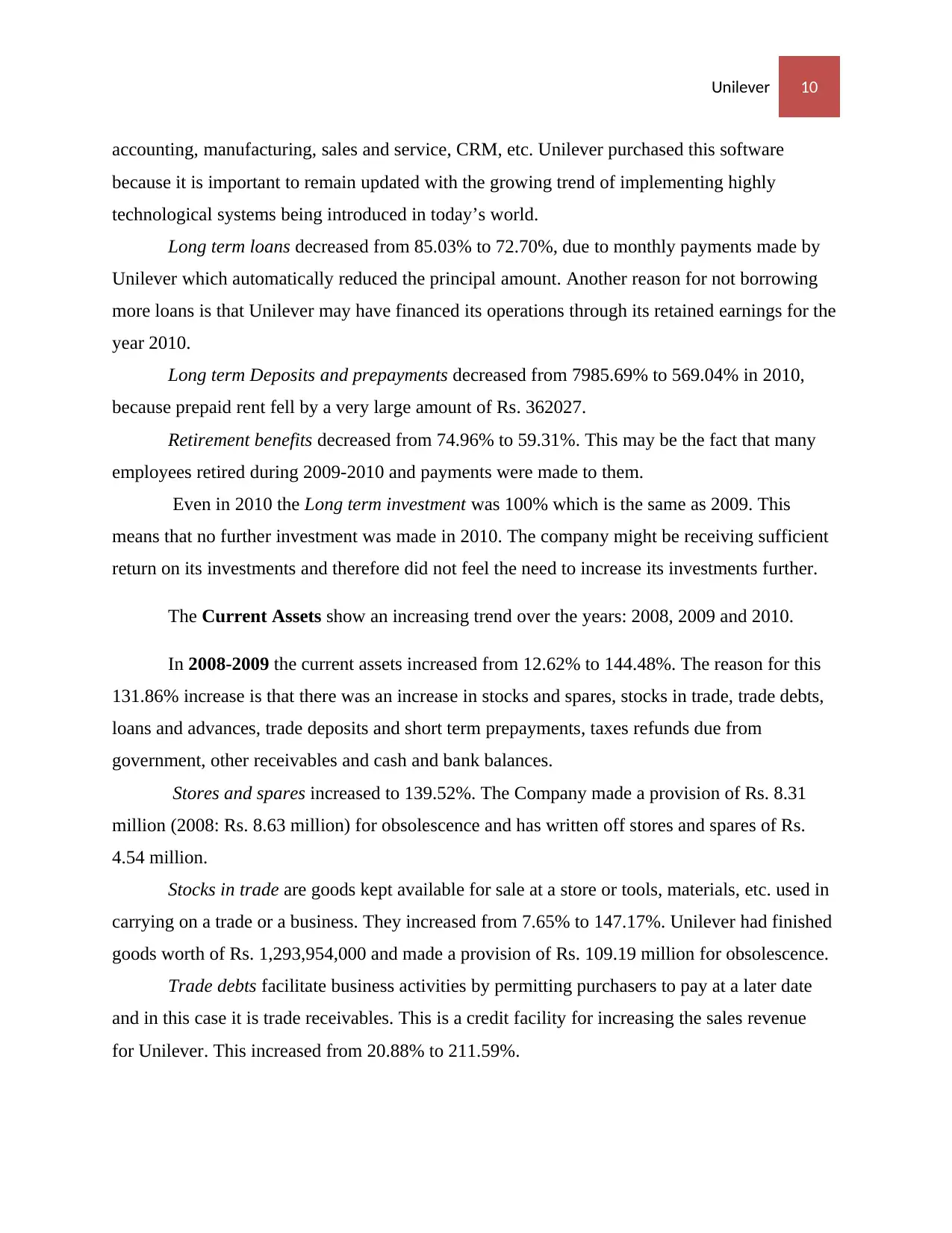
Unilever 10
accounting, manufacturing, sales and service, CRM, etc. Unilever purchased this software
because it is important to remain updated with the growing trend of implementing highly
technological systems being introduced in today’s world.
Long term loans decreased from 85.03% to 72.70%, due to monthly payments made by
Unilever which automatically reduced the principal amount. Another reason for not borrowing
more loans is that Unilever may have financed its operations through its retained earnings for the
year 2010.
Long term Deposits and prepayments decreased from 7985.69% to 569.04% in 2010,
because prepaid rent fell by a very large amount of Rs. 362027.
Retirement benefits decreased from 74.96% to 59.31%. This may be the fact that many
employees retired during 2009-2010 and payments were made to them.
Even in 2010 the Long term investment was 100% which is the same as 2009. This
means that no further investment was made in 2010. The company might be receiving sufficient
return on its investments and therefore did not feel the need to increase its investments further.
The Current Assets show an increasing trend over the years: 2008, 2009 and 2010.
In 2008-2009 the current assets increased from 12.62% to 144.48%. The reason for this
131.86% increase is that there was an increase in stocks and spares, stocks in trade, trade debts,
loans and advances, trade deposits and short term prepayments, taxes refunds due from
government, other receivables and cash and bank balances.
Stores and spares increased to 139.52%. The Company made a provision of Rs. 8.31
million (2008: Rs. 8.63 million) for obsolescence and has written off stores and spares of Rs.
4.54 million.
Stocks in trade are goods kept available for sale at a store or tools, materials, etc. used in
carrying on a trade or a business. They increased from 7.65% to 147.17%. Unilever had finished
goods worth of Rs. 1,293,954,000 and made a provision of Rs. 109.19 million for obsolescence.
Trade debts facilitate business activities by permitting purchasers to pay at a later date
and in this case it is trade receivables. This is a credit facility for increasing the sales revenue
for Unilever. This increased from 20.88% to 211.59%.
accounting, manufacturing, sales and service, CRM, etc. Unilever purchased this software
because it is important to remain updated with the growing trend of implementing highly
technological systems being introduced in today’s world.
Long term loans decreased from 85.03% to 72.70%, due to monthly payments made by
Unilever which automatically reduced the principal amount. Another reason for not borrowing
more loans is that Unilever may have financed its operations through its retained earnings for the
year 2010.
Long term Deposits and prepayments decreased from 7985.69% to 569.04% in 2010,
because prepaid rent fell by a very large amount of Rs. 362027.
Retirement benefits decreased from 74.96% to 59.31%. This may be the fact that many
employees retired during 2009-2010 and payments were made to them.
Even in 2010 the Long term investment was 100% which is the same as 2009. This
means that no further investment was made in 2010. The company might be receiving sufficient
return on its investments and therefore did not feel the need to increase its investments further.
The Current Assets show an increasing trend over the years: 2008, 2009 and 2010.
In 2008-2009 the current assets increased from 12.62% to 144.48%. The reason for this
131.86% increase is that there was an increase in stocks and spares, stocks in trade, trade debts,
loans and advances, trade deposits and short term prepayments, taxes refunds due from
government, other receivables and cash and bank balances.
Stores and spares increased to 139.52%. The Company made a provision of Rs. 8.31
million (2008: Rs. 8.63 million) for obsolescence and has written off stores and spares of Rs.
4.54 million.
Stocks in trade are goods kept available for sale at a store or tools, materials, etc. used in
carrying on a trade or a business. They increased from 7.65% to 147.17%. Unilever had finished
goods worth of Rs. 1,293,954,000 and made a provision of Rs. 109.19 million for obsolescence.
Trade debts facilitate business activities by permitting purchasers to pay at a later date
and in this case it is trade receivables. This is a credit facility for increasing the sales revenue
for Unilever. This increased from 20.88% to 211.59%.
Secure Best Marks with AI Grader
Need help grading? Try our AI Grader for instant feedback on your assignments.
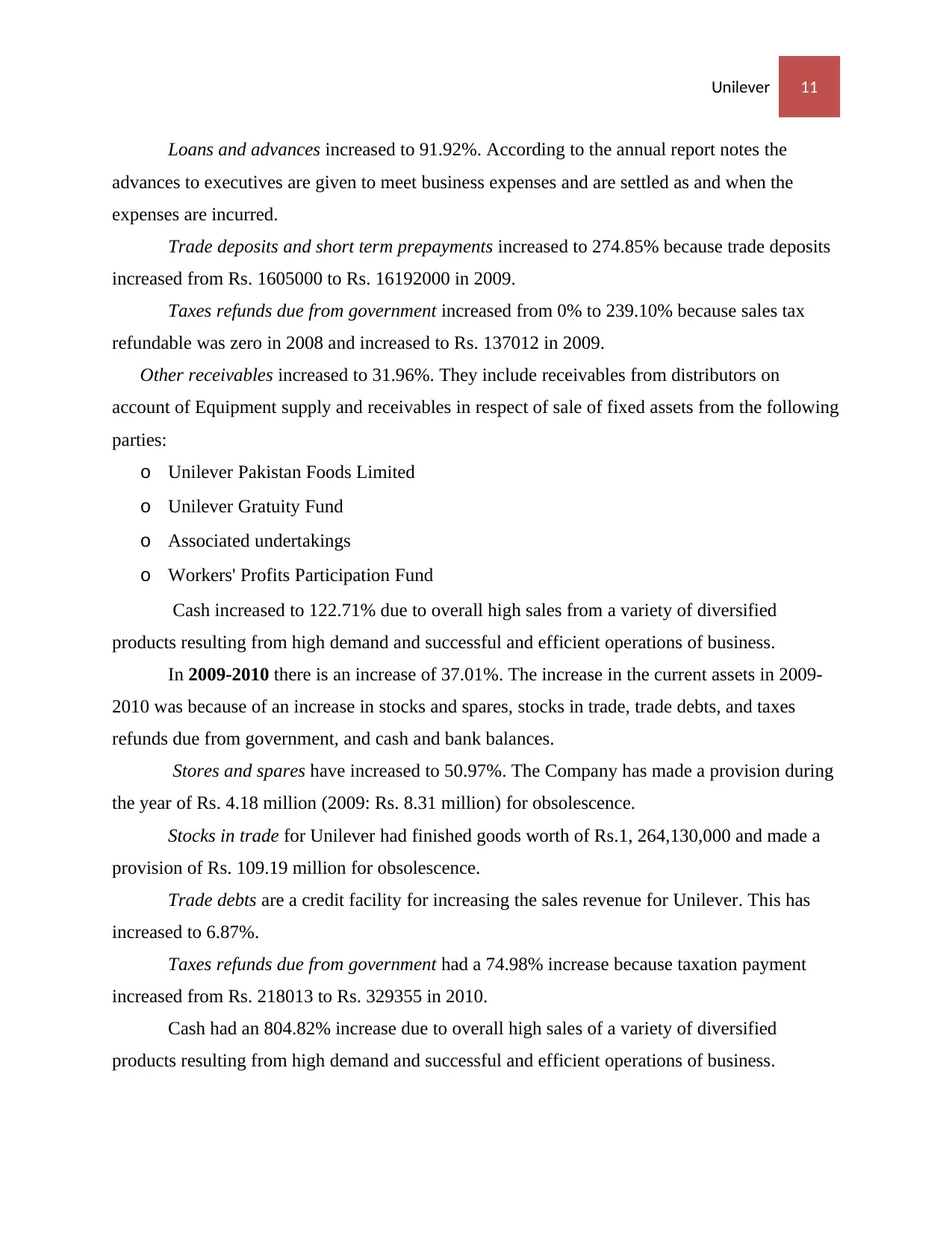
Unilever 11
Loans and advances increased to 91.92%. According to the annual report notes the
advances to executives are given to meet business expenses and are settled as and when the
expenses are incurred.
Trade deposits and short term prepayments increased to 274.85% because trade deposits
increased from Rs. 1605000 to Rs. 16192000 in 2009.
Taxes refunds due from government increased from 0% to 239.10% because sales tax
refundable was zero in 2008 and increased to Rs. 137012 in 2009.
Other receivables increased to 31.96%. They include receivables from distributors on
account of Equipment supply and receivables in respect of sale of fixed assets from the following
parties:
o Unilever Pakistan Foods Limited
o Unilever Gratuity Fund
o Associated undertakings
o Workers' Profits Participation Fund
Cash increased to 122.71% due to overall high sales from a variety of diversified
products resulting from high demand and successful and efficient operations of business.
In 2009-2010 there is an increase of 37.01%. The increase in the current assets in 2009-
2010 was because of an increase in stocks and spares, stocks in trade, trade debts, and taxes
refunds due from government, and cash and bank balances.
Stores and spares have increased to 50.97%. The Company has made a provision during
the year of Rs. 4.18 million (2009: Rs. 8.31 million) for obsolescence.
Stocks in trade for Unilever had finished goods worth of Rs.1, 264,130,000 and made a
provision of Rs. 109.19 million for obsolescence.
Trade debts are a credit facility for increasing the sales revenue for Unilever. This has
increased to 6.87%.
Taxes refunds due from government had a 74.98% increase because taxation payment
increased from Rs. 218013 to Rs. 329355 in 2010.
Cash had an 804.82% increase due to overall high sales of a variety of diversified
products resulting from high demand and successful and efficient operations of business.
Loans and advances increased to 91.92%. According to the annual report notes the
advances to executives are given to meet business expenses and are settled as and when the
expenses are incurred.
Trade deposits and short term prepayments increased to 274.85% because trade deposits
increased from Rs. 1605000 to Rs. 16192000 in 2009.
Taxes refunds due from government increased from 0% to 239.10% because sales tax
refundable was zero in 2008 and increased to Rs. 137012 in 2009.
Other receivables increased to 31.96%. They include receivables from distributors on
account of Equipment supply and receivables in respect of sale of fixed assets from the following
parties:
o Unilever Pakistan Foods Limited
o Unilever Gratuity Fund
o Associated undertakings
o Workers' Profits Participation Fund
Cash increased to 122.71% due to overall high sales from a variety of diversified
products resulting from high demand and successful and efficient operations of business.
In 2009-2010 there is an increase of 37.01%. The increase in the current assets in 2009-
2010 was because of an increase in stocks and spares, stocks in trade, trade debts, and taxes
refunds due from government, and cash and bank balances.
Stores and spares have increased to 50.97%. The Company has made a provision during
the year of Rs. 4.18 million (2009: Rs. 8.31 million) for obsolescence.
Stocks in trade for Unilever had finished goods worth of Rs.1, 264,130,000 and made a
provision of Rs. 109.19 million for obsolescence.
Trade debts are a credit facility for increasing the sales revenue for Unilever. This has
increased to 6.87%.
Taxes refunds due from government had a 74.98% increase because taxation payment
increased from Rs. 218013 to Rs. 329355 in 2010.
Cash had an 804.82% increase due to overall high sales of a variety of diversified
products resulting from high demand and successful and efficient operations of business.
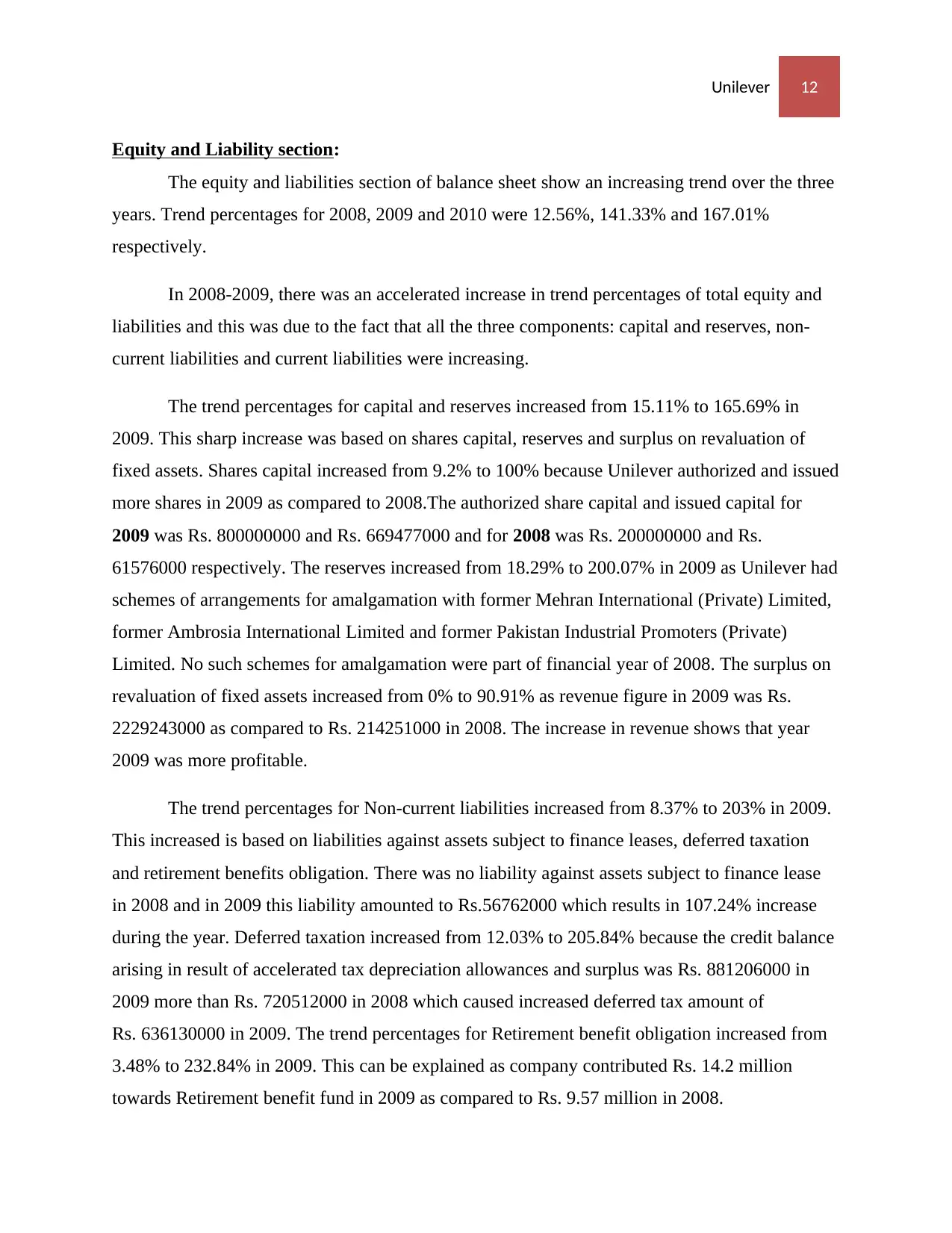
Unilever 12
Equity and Liability section:
The equity and liabilities section of balance sheet show an increasing trend over the three
years. Trend percentages for 2008, 2009 and 2010 were 12.56%, 141.33% and 167.01%
respectively.
In 2008-2009, there was an accelerated increase in trend percentages of total equity and
liabilities and this was due to the fact that all the three components: capital and reserves, non-
current liabilities and current liabilities were increasing.
The trend percentages for capital and reserves increased from 15.11% to 165.69% in
2009. This sharp increase was based on shares capital, reserves and surplus on revaluation of
fixed assets. Shares capital increased from 9.2% to 100% because Unilever authorized and issued
more shares in 2009 as compared to 2008.The authorized share capital and issued capital for
2009 was Rs. 800000000 and Rs. 669477000 and for 2008 was Rs. 200000000 and Rs.
61576000 respectively. The reserves increased from 18.29% to 200.07% in 2009 as Unilever had
schemes of arrangements for amalgamation with former Mehran International (Private) Limited,
former Ambrosia International Limited and former Pakistan Industrial Promoters (Private)
Limited. No such schemes for amalgamation were part of financial year of 2008. The surplus on
revaluation of fixed assets increased from 0% to 90.91% as revenue figure in 2009 was Rs.
2229243000 as compared to Rs. 214251000 in 2008. The increase in revenue shows that year
2009 was more profitable.
The trend percentages for Non-current liabilities increased from 8.37% to 203% in 2009.
This increased is based on liabilities against assets subject to finance leases, deferred taxation
and retirement benefits obligation. There was no liability against assets subject to finance lease
in 2008 and in 2009 this liability amounted to Rs.56762000 which results in 107.24% increase
during the year. Deferred taxation increased from 12.03% to 205.84% because the credit balance
arising in result of accelerated tax depreciation allowances and surplus was Rs. 881206000 in
2009 more than Rs. 720512000 in 2008 which caused increased deferred tax amount of
Rs. 636130000 in 2009. The trend percentages for Retirement benefit obligation increased from
3.48% to 232.84% in 2009. This can be explained as company contributed Rs. 14.2 million
towards Retirement benefit fund in 2009 as compared to Rs. 9.57 million in 2008.
Equity and Liability section:
The equity and liabilities section of balance sheet show an increasing trend over the three
years. Trend percentages for 2008, 2009 and 2010 were 12.56%, 141.33% and 167.01%
respectively.
In 2008-2009, there was an accelerated increase in trend percentages of total equity and
liabilities and this was due to the fact that all the three components: capital and reserves, non-
current liabilities and current liabilities were increasing.
The trend percentages for capital and reserves increased from 15.11% to 165.69% in
2009. This sharp increase was based on shares capital, reserves and surplus on revaluation of
fixed assets. Shares capital increased from 9.2% to 100% because Unilever authorized and issued
more shares in 2009 as compared to 2008.The authorized share capital and issued capital for
2009 was Rs. 800000000 and Rs. 669477000 and for 2008 was Rs. 200000000 and Rs.
61576000 respectively. The reserves increased from 18.29% to 200.07% in 2009 as Unilever had
schemes of arrangements for amalgamation with former Mehran International (Private) Limited,
former Ambrosia International Limited and former Pakistan Industrial Promoters (Private)
Limited. No such schemes for amalgamation were part of financial year of 2008. The surplus on
revaluation of fixed assets increased from 0% to 90.91% as revenue figure in 2009 was Rs.
2229243000 as compared to Rs. 214251000 in 2008. The increase in revenue shows that year
2009 was more profitable.
The trend percentages for Non-current liabilities increased from 8.37% to 203% in 2009.
This increased is based on liabilities against assets subject to finance leases, deferred taxation
and retirement benefits obligation. There was no liability against assets subject to finance lease
in 2008 and in 2009 this liability amounted to Rs.56762000 which results in 107.24% increase
during the year. Deferred taxation increased from 12.03% to 205.84% because the credit balance
arising in result of accelerated tax depreciation allowances and surplus was Rs. 881206000 in
2009 more than Rs. 720512000 in 2008 which caused increased deferred tax amount of
Rs. 636130000 in 2009. The trend percentages for Retirement benefit obligation increased from
3.48% to 232.84% in 2009. This can be explained as company contributed Rs. 14.2 million
towards Retirement benefit fund in 2009 as compared to Rs. 9.57 million in 2008.
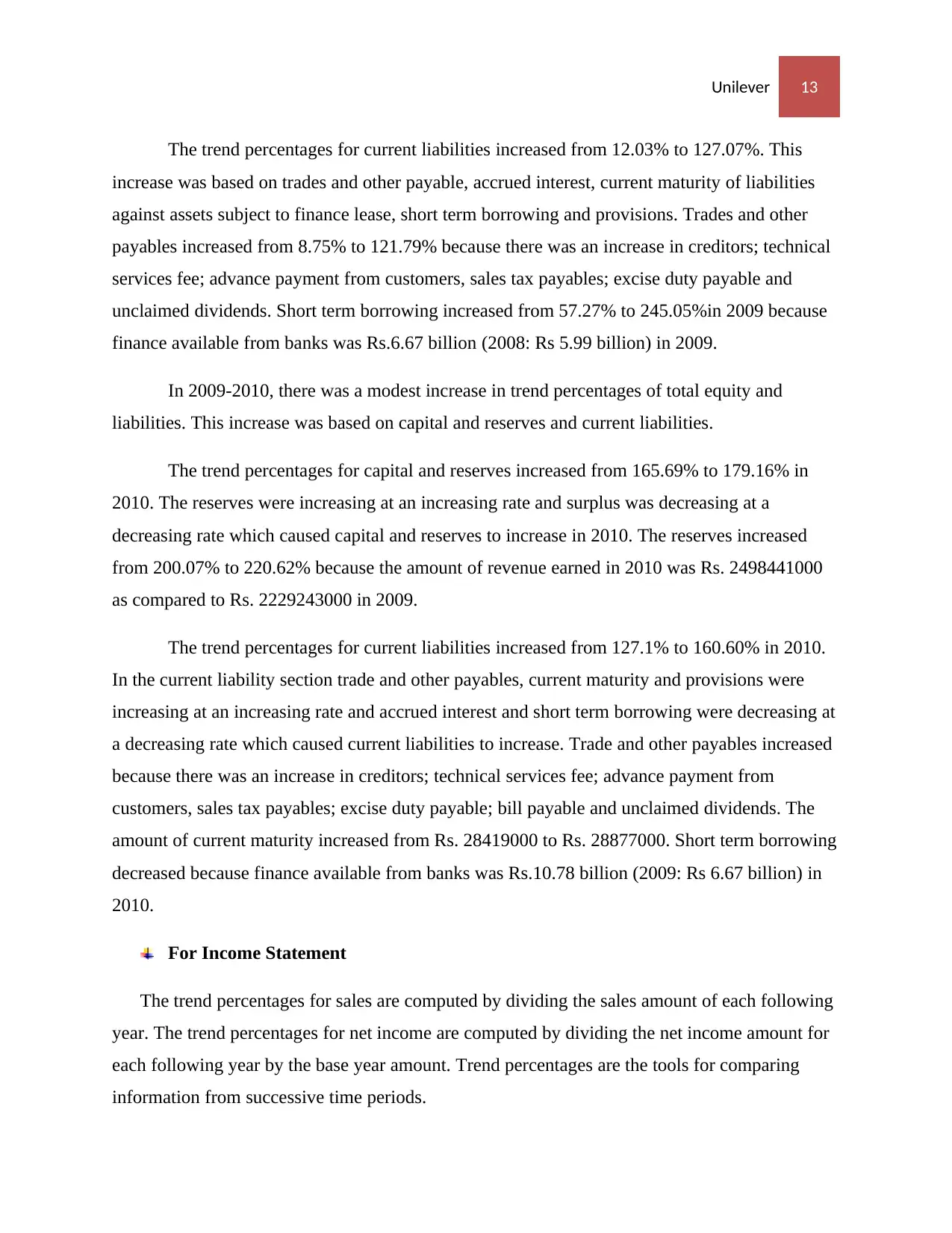
Unilever 13
The trend percentages for current liabilities increased from 12.03% to 127.07%. This
increase was based on trades and other payable, accrued interest, current maturity of liabilities
against assets subject to finance lease, short term borrowing and provisions. Trades and other
payables increased from 8.75% to 121.79% because there was an increase in creditors; technical
services fee; advance payment from customers, sales tax payables; excise duty payable and
unclaimed dividends. Short term borrowing increased from 57.27% to 245.05%in 2009 because
finance available from banks was Rs.6.67 billion (2008: Rs 5.99 billion) in 2009.
In 2009-2010, there was a modest increase in trend percentages of total equity and
liabilities. This increase was based on capital and reserves and current liabilities.
The trend percentages for capital and reserves increased from 165.69% to 179.16% in
2010. The reserves were increasing at an increasing rate and surplus was decreasing at a
decreasing rate which caused capital and reserves to increase in 2010. The reserves increased
from 200.07% to 220.62% because the amount of revenue earned in 2010 was Rs. 2498441000
as compared to Rs. 2229243000 in 2009.
The trend percentages for current liabilities increased from 127.1% to 160.60% in 2010.
In the current liability section trade and other payables, current maturity and provisions were
increasing at an increasing rate and accrued interest and short term borrowing were decreasing at
a decreasing rate which caused current liabilities to increase. Trade and other payables increased
because there was an increase in creditors; technical services fee; advance payment from
customers, sales tax payables; excise duty payable; bill payable and unclaimed dividends. The
amount of current maturity increased from Rs. 28419000 to Rs. 28877000. Short term borrowing
decreased because finance available from banks was Rs.10.78 billion (2009: Rs 6.67 billion) in
2010.
For Income Statement
The trend percentages for sales are computed by dividing the sales amount of each following
year. The trend percentages for net income are computed by dividing the net income amount for
each following year by the base year amount. Trend percentages are the tools for comparing
information from successive time periods.
The trend percentages for current liabilities increased from 12.03% to 127.07%. This
increase was based on trades and other payable, accrued interest, current maturity of liabilities
against assets subject to finance lease, short term borrowing and provisions. Trades and other
payables increased from 8.75% to 121.79% because there was an increase in creditors; technical
services fee; advance payment from customers, sales tax payables; excise duty payable and
unclaimed dividends. Short term borrowing increased from 57.27% to 245.05%in 2009 because
finance available from banks was Rs.6.67 billion (2008: Rs 5.99 billion) in 2009.
In 2009-2010, there was a modest increase in trend percentages of total equity and
liabilities. This increase was based on capital and reserves and current liabilities.
The trend percentages for capital and reserves increased from 165.69% to 179.16% in
2010. The reserves were increasing at an increasing rate and surplus was decreasing at a
decreasing rate which caused capital and reserves to increase in 2010. The reserves increased
from 200.07% to 220.62% because the amount of revenue earned in 2010 was Rs. 2498441000
as compared to Rs. 2229243000 in 2009.
The trend percentages for current liabilities increased from 127.1% to 160.60% in 2010.
In the current liability section trade and other payables, current maturity and provisions were
increasing at an increasing rate and accrued interest and short term borrowing were decreasing at
a decreasing rate which caused current liabilities to increase. Trade and other payables increased
because there was an increase in creditors; technical services fee; advance payment from
customers, sales tax payables; excise duty payable; bill payable and unclaimed dividends. The
amount of current maturity increased from Rs. 28419000 to Rs. 28877000. Short term borrowing
decreased because finance available from banks was Rs.10.78 billion (2009: Rs 6.67 billion) in
2010.
For Income Statement
The trend percentages for sales are computed by dividing the sales amount of each following
year. The trend percentages for net income are computed by dividing the net income amount for
each following year by the base year amount. Trend percentages are the tools for comparing
information from successive time periods.
Paraphrase This Document
Need a fresh take? Get an instant paraphrase of this document with our AI Paraphraser

Unilever 14
In 2008, the sales increased by 13.21%, CGS by 13.51%, gross profit by 12.74%, distribution
cost by 10.68%, administrative expense by 4.51%, other operating expenses by 18.79%, other
operating income by 10.98%, restructuring cost by 0%, financing cost by 20.36% and taxation by
21.58%, whereas the net income of 2008 is increased by 20.66%.
In 2009, the sales increased by 163.67%, CGS by 174.42%, gross profit by 146.81%,
distribution cost by 142.99%, administrative expense by 102.27%, other operating expenses by
159.83%, other operating income by 100.91%, restructuring cost by 0%, financing cost by
391.65% and taxation by 173.33%, whereas the net income of 2009 is increased by 181.10%.
In 2010, the sales increased by 191.46%, CGS by 211.21%, gross profit by 160.49%,
distribution cost by 159.99%, administrative expense by 121.07%, other operating expenses by
165.94%, other operating income by 65.14%, restructuring cost by 24.18%, financing cost by
173.60% and taxation by 178.94%, whereas the net income of 2010 is increased by 193.98%.
(The reasons why there is an increase in expenses, cost and gross profit is already explained in
vertical and horizontal analysis of income statement).
By glancing at these trend percentages of three years (2008-2011), we can conclude that
these percentages indicate a modest growth in sales in the early years and have accelerating
growth in 2009 and 2010. Whereas all the components like CGS, gross profit, distribution cost,
administrative expenses, other operating expenses, other operating income, financing cost and
taxation are also accelerating in 2009 and 2010, which show that as sales are increasing the
expenses which are occurring with it are also increasing. If we look at a trend percentages we
also come to know that net income also shows an increasing growth trend with the exception of
the year 2008, when net income declined despite a solid increase in sales. The problem was
overcome in 2010 with a sharp rise in net income. Overall the trend percentages give a picture of
a profitable, growing enterprise.
Horizontal Analysis
Horizontal analysis is used to evaluate rates of growth (decline) for company. The
percentage was computed by dividing the amount of the dollar change between 2007-2008,
2008-2009 and 2009-2010 by the amount for the base years.
In 2008, the sales increased by 13.21%, CGS by 13.51%, gross profit by 12.74%, distribution
cost by 10.68%, administrative expense by 4.51%, other operating expenses by 18.79%, other
operating income by 10.98%, restructuring cost by 0%, financing cost by 20.36% and taxation by
21.58%, whereas the net income of 2008 is increased by 20.66%.
In 2009, the sales increased by 163.67%, CGS by 174.42%, gross profit by 146.81%,
distribution cost by 142.99%, administrative expense by 102.27%, other operating expenses by
159.83%, other operating income by 100.91%, restructuring cost by 0%, financing cost by
391.65% and taxation by 173.33%, whereas the net income of 2009 is increased by 181.10%.
In 2010, the sales increased by 191.46%, CGS by 211.21%, gross profit by 160.49%,
distribution cost by 159.99%, administrative expense by 121.07%, other operating expenses by
165.94%, other operating income by 65.14%, restructuring cost by 24.18%, financing cost by
173.60% and taxation by 178.94%, whereas the net income of 2010 is increased by 193.98%.
(The reasons why there is an increase in expenses, cost and gross profit is already explained in
vertical and horizontal analysis of income statement).
By glancing at these trend percentages of three years (2008-2011), we can conclude that
these percentages indicate a modest growth in sales in the early years and have accelerating
growth in 2009 and 2010. Whereas all the components like CGS, gross profit, distribution cost,
administrative expenses, other operating expenses, other operating income, financing cost and
taxation are also accelerating in 2009 and 2010, which show that as sales are increasing the
expenses which are occurring with it are also increasing. If we look at a trend percentages we
also come to know that net income also shows an increasing growth trend with the exception of
the year 2008, when net income declined despite a solid increase in sales. The problem was
overcome in 2010 with a sharp rise in net income. Overall the trend percentages give a picture of
a profitable, growing enterprise.
Horizontal Analysis
Horizontal analysis is used to evaluate rates of growth (decline) for company. The
percentage was computed by dividing the amount of the dollar change between 2007-2008,
2008-2009 and 2009-2010 by the amount for the base years.
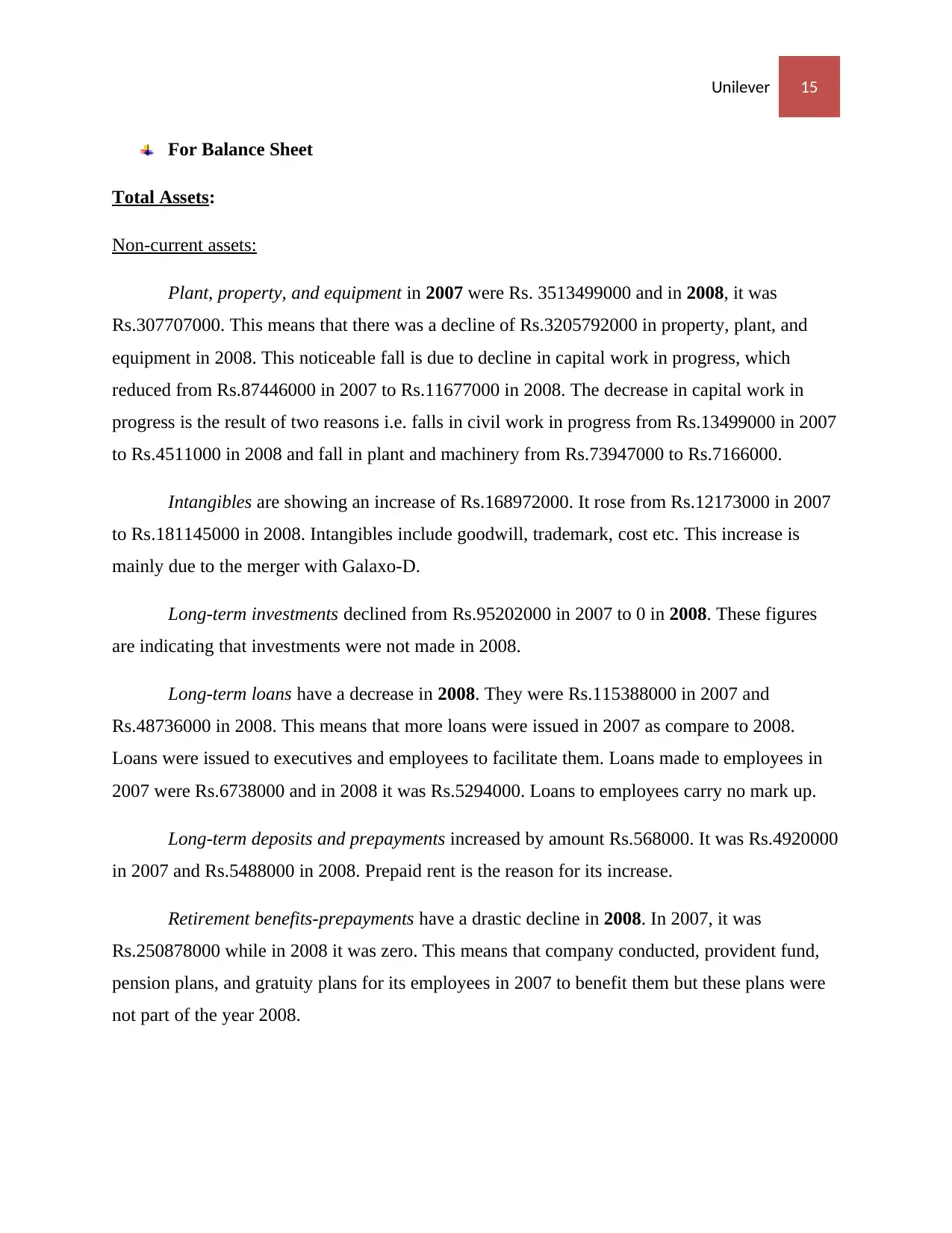
Unilever 15
For Balance Sheet
Total Assets:
Non-current assets:
Plant, property, and equipment in 2007 were Rs. 3513499000 and in 2008, it was
Rs.307707000. This means that there was a decline of Rs.3205792000 in property, plant, and
equipment in 2008. This noticeable fall is due to decline in capital work in progress, which
reduced from Rs.87446000 in 2007 to Rs.11677000 in 2008. The decrease in capital work in
progress is the result of two reasons i.e. falls in civil work in progress from Rs.13499000 in 2007
to Rs.4511000 in 2008 and fall in plant and machinery from Rs.73947000 to Rs.7166000.
Intangibles are showing an increase of Rs.168972000. It rose from Rs.12173000 in 2007
to Rs.181145000 in 2008. Intangibles include goodwill, trademark, cost etc. This increase is
mainly due to the merger with Galaxo-D.
Long-term investments declined from Rs.95202000 in 2007 to 0 in 2008. These figures
are indicating that investments were not made in 2008.
Long-term loans have a decrease in 2008. They were Rs.115388000 in 2007 and
Rs.48736000 in 2008. This means that more loans were issued in 2007 as compare to 2008.
Loans were issued to executives and employees to facilitate them. Loans made to employees in
2007 were Rs.6738000 and in 2008 it was Rs.5294000. Loans to employees carry no mark up.
Long-term deposits and prepayments increased by amount Rs.568000. It was Rs.4920000
in 2007 and Rs.5488000 in 2008. Prepaid rent is the reason for its increase.
Retirement benefits-prepayments have a drastic decline in 2008. In 2007, it was
Rs.250878000 while in 2008 it was zero. This means that company conducted, provident fund,
pension plans, and gratuity plans for its employees in 2007 to benefit them but these plans were
not part of the year 2008.
For Balance Sheet
Total Assets:
Non-current assets:
Plant, property, and equipment in 2007 were Rs. 3513499000 and in 2008, it was
Rs.307707000. This means that there was a decline of Rs.3205792000 in property, plant, and
equipment in 2008. This noticeable fall is due to decline in capital work in progress, which
reduced from Rs.87446000 in 2007 to Rs.11677000 in 2008. The decrease in capital work in
progress is the result of two reasons i.e. falls in civil work in progress from Rs.13499000 in 2007
to Rs.4511000 in 2008 and fall in plant and machinery from Rs.73947000 to Rs.7166000.
Intangibles are showing an increase of Rs.168972000. It rose from Rs.12173000 in 2007
to Rs.181145000 in 2008. Intangibles include goodwill, trademark, cost etc. This increase is
mainly due to the merger with Galaxo-D.
Long-term investments declined from Rs.95202000 in 2007 to 0 in 2008. These figures
are indicating that investments were not made in 2008.
Long-term loans have a decrease in 2008. They were Rs.115388000 in 2007 and
Rs.48736000 in 2008. This means that more loans were issued in 2007 as compare to 2008.
Loans were issued to executives and employees to facilitate them. Loans made to employees in
2007 were Rs.6738000 and in 2008 it was Rs.5294000. Loans to employees carry no mark up.
Long-term deposits and prepayments increased by amount Rs.568000. It was Rs.4920000
in 2007 and Rs.5488000 in 2008. Prepaid rent is the reason for its increase.
Retirement benefits-prepayments have a drastic decline in 2008. In 2007, it was
Rs.250878000 while in 2008 it was zero. This means that company conducted, provident fund,
pension plans, and gratuity plans for its employees in 2007 to benefit them but these plans were
not part of the year 2008.
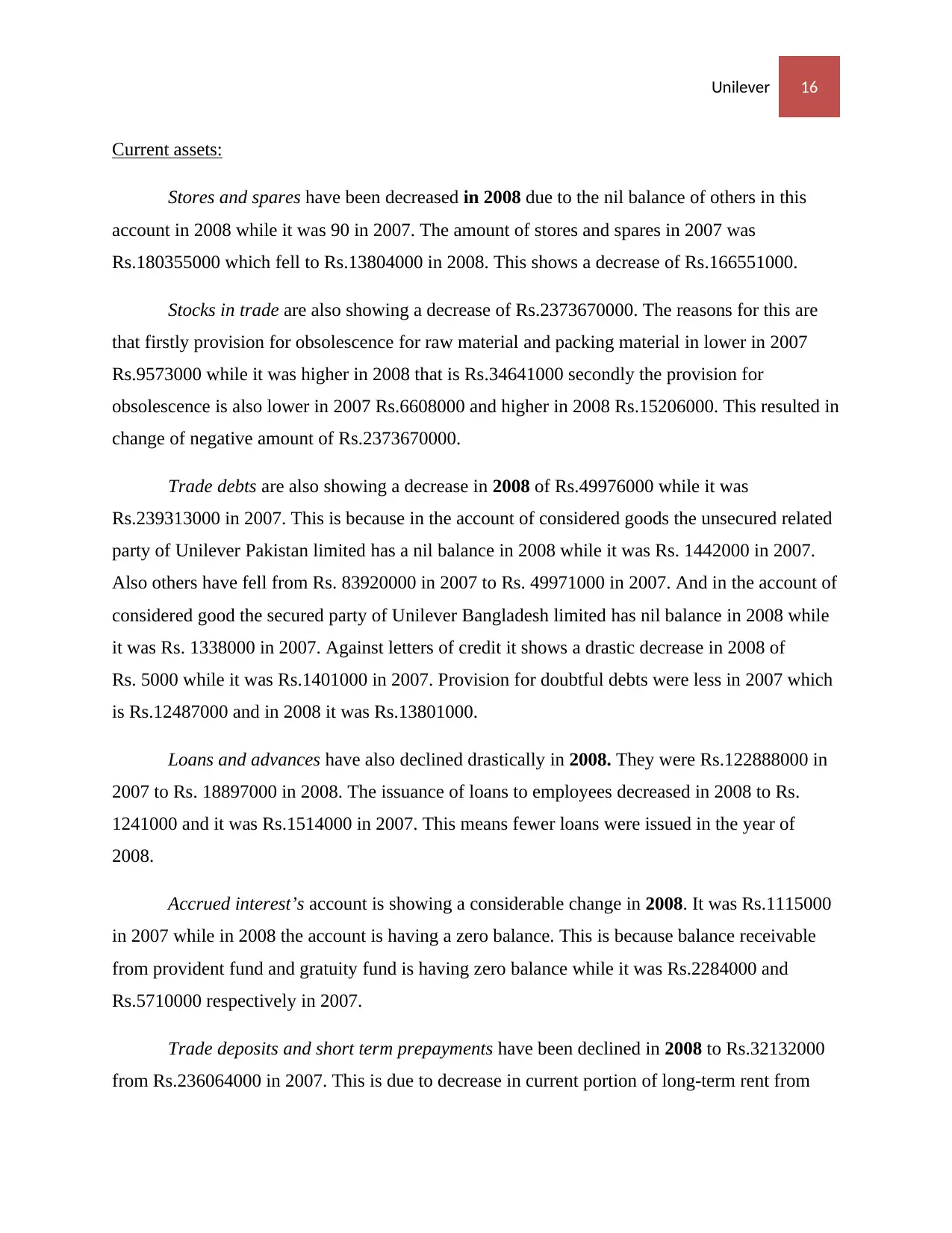
Unilever 16
Current assets:
Stores and spares have been decreased in 2008 due to the nil balance of others in this
account in 2008 while it was 90 in 2007. The amount of stores and spares in 2007 was
Rs.180355000 which fell to Rs.13804000 in 2008. This shows a decrease of Rs.166551000.
Stocks in trade are also showing a decrease of Rs.2373670000. The reasons for this are
that firstly provision for obsolescence for raw material and packing material in lower in 2007
Rs.9573000 while it was higher in 2008 that is Rs.34641000 secondly the provision for
obsolescence is also lower in 2007 Rs.6608000 and higher in 2008 Rs.15206000. This resulted in
change of negative amount of Rs.2373670000.
Trade debts are also showing a decrease in 2008 of Rs.49976000 while it was
Rs.239313000 in 2007. This is because in the account of considered goods the unsecured related
party of Unilever Pakistan limited has a nil balance in 2008 while it was Rs. 1442000 in 2007.
Also others have fell from Rs. 83920000 in 2007 to Rs. 49971000 in 2007. And in the account of
considered good the secured party of Unilever Bangladesh limited has nil balance in 2008 while
it was Rs. 1338000 in 2007. Against letters of credit it shows a drastic decrease in 2008 of
Rs. 5000 while it was Rs.1401000 in 2007. Provision for doubtful debts were less in 2007 which
is Rs.12487000 and in 2008 it was Rs.13801000.
Loans and advances have also declined drastically in 2008. They were Rs.122888000 in
2007 to Rs. 18897000 in 2008. The issuance of loans to employees decreased in 2008 to Rs.
1241000 and it was Rs.1514000 in 2007. This means fewer loans were issued in the year of
2008.
Accrued interest’s account is showing a considerable change in 2008. It was Rs.1115000
in 2007 while in 2008 the account is having a zero balance. This is because balance receivable
from provident fund and gratuity fund is having zero balance while it was Rs.2284000 and
Rs.5710000 respectively in 2007.
Trade deposits and short term prepayments have been declined in 2008 to Rs.32132000
from Rs.236064000 in 2007. This is due to decrease in current portion of long-term rent from
Current assets:
Stores and spares have been decreased in 2008 due to the nil balance of others in this
account in 2008 while it was 90 in 2007. The amount of stores and spares in 2007 was
Rs.180355000 which fell to Rs.13804000 in 2008. This shows a decrease of Rs.166551000.
Stocks in trade are also showing a decrease of Rs.2373670000. The reasons for this are
that firstly provision for obsolescence for raw material and packing material in lower in 2007
Rs.9573000 while it was higher in 2008 that is Rs.34641000 secondly the provision for
obsolescence is also lower in 2007 Rs.6608000 and higher in 2008 Rs.15206000. This resulted in
change of negative amount of Rs.2373670000.
Trade debts are also showing a decrease in 2008 of Rs.49976000 while it was
Rs.239313000 in 2007. This is because in the account of considered goods the unsecured related
party of Unilever Pakistan limited has a nil balance in 2008 while it was Rs. 1442000 in 2007.
Also others have fell from Rs. 83920000 in 2007 to Rs. 49971000 in 2007. And in the account of
considered good the secured party of Unilever Bangladesh limited has nil balance in 2008 while
it was Rs. 1338000 in 2007. Against letters of credit it shows a drastic decrease in 2008 of
Rs. 5000 while it was Rs.1401000 in 2007. Provision for doubtful debts were less in 2007 which
is Rs.12487000 and in 2008 it was Rs.13801000.
Loans and advances have also declined drastically in 2008. They were Rs.122888000 in
2007 to Rs. 18897000 in 2008. The issuance of loans to employees decreased in 2008 to Rs.
1241000 and it was Rs.1514000 in 2007. This means fewer loans were issued in the year of
2008.
Accrued interest’s account is showing a considerable change in 2008. It was Rs.1115000
in 2007 while in 2008 the account is having a zero balance. This is because balance receivable
from provident fund and gratuity fund is having zero balance while it was Rs.2284000 and
Rs.5710000 respectively in 2007.
Trade deposits and short term prepayments have been declined in 2008 to Rs.32132000
from Rs.236064000 in 2007. This is due to decrease in current portion of long-term rent from
Secure Best Marks with AI Grader
Need help grading? Try our AI Grader for instant feedback on your assignments.

Unilever 17
Rs.3945000 in 2007 to Rs. 3788000 in 2008 and a fall in trade deposits in 2008 of Rs.1605000
from Rs.3790000 in 2007.
Other receivables account is showing a fall of Rs. 246620000. The amount was
Rs.249139000 in 2007 while it was Rs.2519000 in 2008. This drastic decline is due to four
reasons. Firstly, Rafhan best foods provident fund has a nil balance in 2008 while it was
Rs.2098000 in 2007. Secondly, Rafhan best foods pension fund has fallen from Rs.638000 in
2007 to Rs.156000 in 2008. Thirdly, Rafhan best foods gratuity fund also has a Rs. 2352000
balance in 2008 while it was Rs.2312000 in 2007 and fourthly workers profit participation fund
was Rs.101000 in 2007 and in 2008 it was Rs. 11000.
Taxes refunds due to government have a drastic decrease from Rs148496 in 2007 to zero
to in 2008.
Taxation is showing an increase in 2008 of Rs.36693000 from zero in 2007 and sales tax
refundable is the same in both years with zero balance.
Cash and bank balances have a fall in 2008 of Rs.180660000. It was Rs.188682000 in
2007 and in 2008 it was Rs.8022000. This change is due to the decrease in savings account of
Rs.840000 in 2008 while it was Rs.12469000 in 2007.
Non-current assets:
Property, plant and equipment have been increased drastically in 2009. It was
Rs.307707000 in 2008 while in 2009 it grows to Rs.4736619000. This increment is caused by
increase in operating assets. Operating assets were Rs.3998216000 in 2008 and in 2009 they
were Rs.4563048000.
Intangibles are showing decrease in 2009. They were Rs.181145000 in 2008 and in 2009
they fell to Rs.2433000. This is due to net carrying value basis which were 7303 in 2008 and in
2009 they decline to Rs.2433000. Gross carrying value basis also showed the same figures for
both years.
Rs.3945000 in 2007 to Rs. 3788000 in 2008 and a fall in trade deposits in 2008 of Rs.1605000
from Rs.3790000 in 2007.
Other receivables account is showing a fall of Rs. 246620000. The amount was
Rs.249139000 in 2007 while it was Rs.2519000 in 2008. This drastic decline is due to four
reasons. Firstly, Rafhan best foods provident fund has a nil balance in 2008 while it was
Rs.2098000 in 2007. Secondly, Rafhan best foods pension fund has fallen from Rs.638000 in
2007 to Rs.156000 in 2008. Thirdly, Rafhan best foods gratuity fund also has a Rs. 2352000
balance in 2008 while it was Rs.2312000 in 2007 and fourthly workers profit participation fund
was Rs.101000 in 2007 and in 2008 it was Rs. 11000.
Taxes refunds due to government have a drastic decrease from Rs148496 in 2007 to zero
to in 2008.
Taxation is showing an increase in 2008 of Rs.36693000 from zero in 2007 and sales tax
refundable is the same in both years with zero balance.
Cash and bank balances have a fall in 2008 of Rs.180660000. It was Rs.188682000 in
2007 and in 2008 it was Rs.8022000. This change is due to the decrease in savings account of
Rs.840000 in 2008 while it was Rs.12469000 in 2007.
Non-current assets:
Property, plant and equipment have been increased drastically in 2009. It was
Rs.307707000 in 2008 while in 2009 it grows to Rs.4736619000. This increment is caused by
increase in operating assets. Operating assets were Rs.3998216000 in 2008 and in 2009 they
were Rs.4563048000.
Intangibles are showing decrease in 2009. They were Rs.181145000 in 2008 and in 2009
they fell to Rs.2433000. This is due to net carrying value basis which were 7303 in 2008 and in
2009 they decline to Rs.2433000. Gross carrying value basis also showed the same figures for
both years.
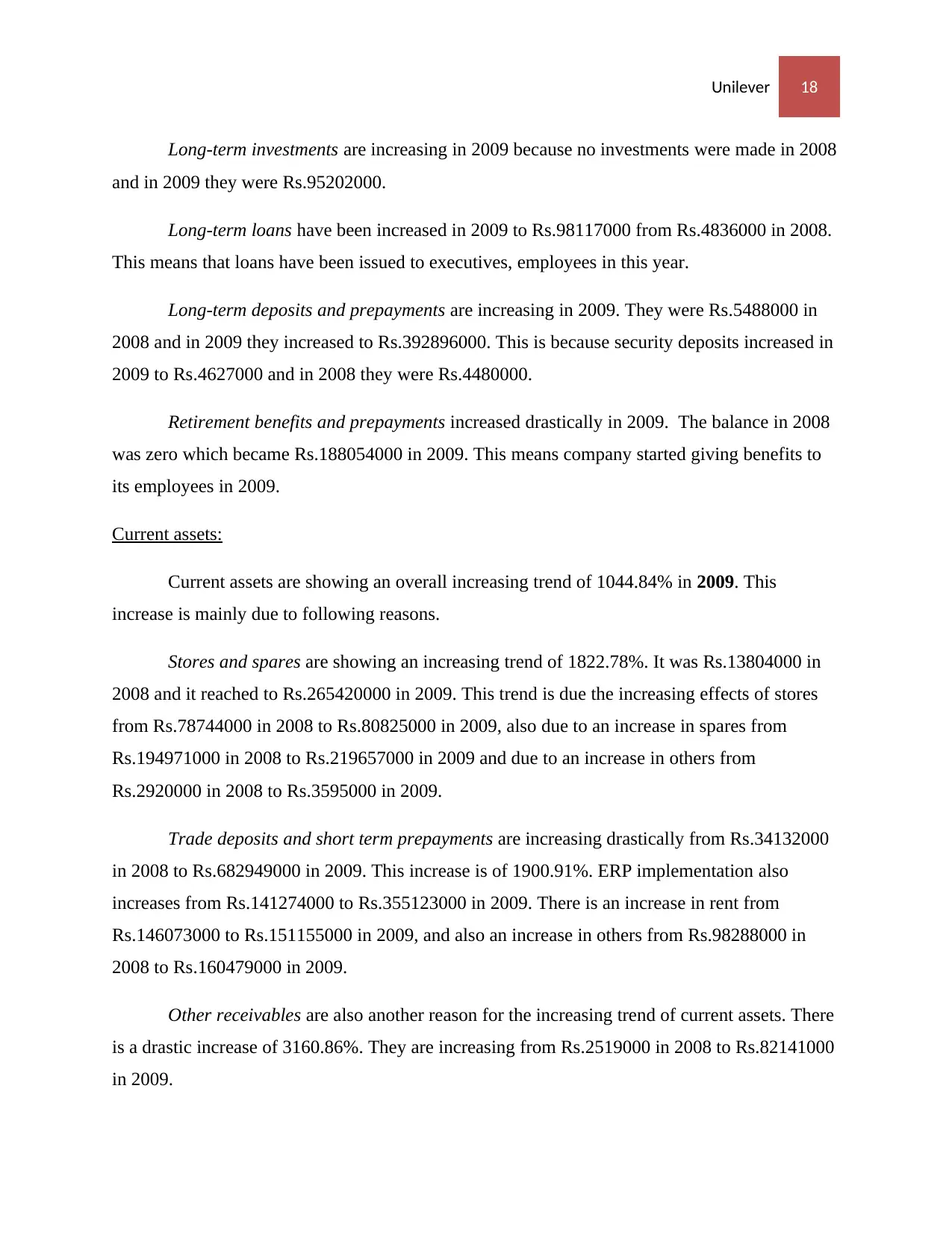
Unilever 18
Long-term investments are increasing in 2009 because no investments were made in 2008
and in 2009 they were Rs.95202000.
Long-term loans have been increased in 2009 to Rs.98117000 from Rs.4836000 in 2008.
This means that loans have been issued to executives, employees in this year.
Long-term deposits and prepayments are increasing in 2009. They were Rs.5488000 in
2008 and in 2009 they increased to Rs.392896000. This is because security deposits increased in
2009 to Rs.4627000 and in 2008 they were Rs.4480000.
Retirement benefits and prepayments increased drastically in 2009. The balance in 2008
was zero which became Rs.188054000 in 2009. This means company started giving benefits to
its employees in 2009.
Current assets:
Current assets are showing an overall increasing trend of 1044.84% in 2009. This
increase is mainly due to following reasons.
Stores and spares are showing an increasing trend of 1822.78%. It was Rs.13804000 in
2008 and it reached to Rs.265420000 in 2009. This trend is due the increasing effects of stores
from Rs.78744000 in 2008 to Rs.80825000 in 2009, also due to an increase in spares from
Rs.194971000 in 2008 to Rs.219657000 in 2009 and due to an increase in others from
Rs.2920000 in 2008 to Rs.3595000 in 2009.
Trade deposits and short term prepayments are increasing drastically from Rs.34132000
in 2008 to Rs.682949000 in 2009. This increase is of 1900.91%. ERP implementation also
increases from Rs.141274000 to Rs.355123000 in 2009. There is an increase in rent from
Rs.146073000 to Rs.151155000 in 2009, and also an increase in others from Rs.98288000 in
2008 to Rs.160479000 in 2009.
Other receivables are also another reason for the increasing trend of current assets. There
is a drastic increase of 3160.86%. They are increasing from Rs.2519000 in 2008 to Rs.82141000
in 2009.
Long-term investments are increasing in 2009 because no investments were made in 2008
and in 2009 they were Rs.95202000.
Long-term loans have been increased in 2009 to Rs.98117000 from Rs.4836000 in 2008.
This means that loans have been issued to executives, employees in this year.
Long-term deposits and prepayments are increasing in 2009. They were Rs.5488000 in
2008 and in 2009 they increased to Rs.392896000. This is because security deposits increased in
2009 to Rs.4627000 and in 2008 they were Rs.4480000.
Retirement benefits and prepayments increased drastically in 2009. The balance in 2008
was zero which became Rs.188054000 in 2009. This means company started giving benefits to
its employees in 2009.
Current assets:
Current assets are showing an overall increasing trend of 1044.84% in 2009. This
increase is mainly due to following reasons.
Stores and spares are showing an increasing trend of 1822.78%. It was Rs.13804000 in
2008 and it reached to Rs.265420000 in 2009. This trend is due the increasing effects of stores
from Rs.78744000 in 2008 to Rs.80825000 in 2009, also due to an increase in spares from
Rs.194971000 in 2008 to Rs.219657000 in 2009 and due to an increase in others from
Rs.2920000 in 2008 to Rs.3595000 in 2009.
Trade deposits and short term prepayments are increasing drastically from Rs.34132000
in 2008 to Rs.682949000 in 2009. This increase is of 1900.91%. ERP implementation also
increases from Rs.141274000 to Rs.355123000 in 2009. There is an increase in rent from
Rs.146073000 to Rs.151155000 in 2009, and also an increase in others from Rs.98288000 in
2008 to Rs.160479000 in 2009.
Other receivables are also another reason for the increasing trend of current assets. There
is a drastic increase of 3160.86%. They are increasing from Rs.2519000 in 2008 to Rs.82141000
in 2009.
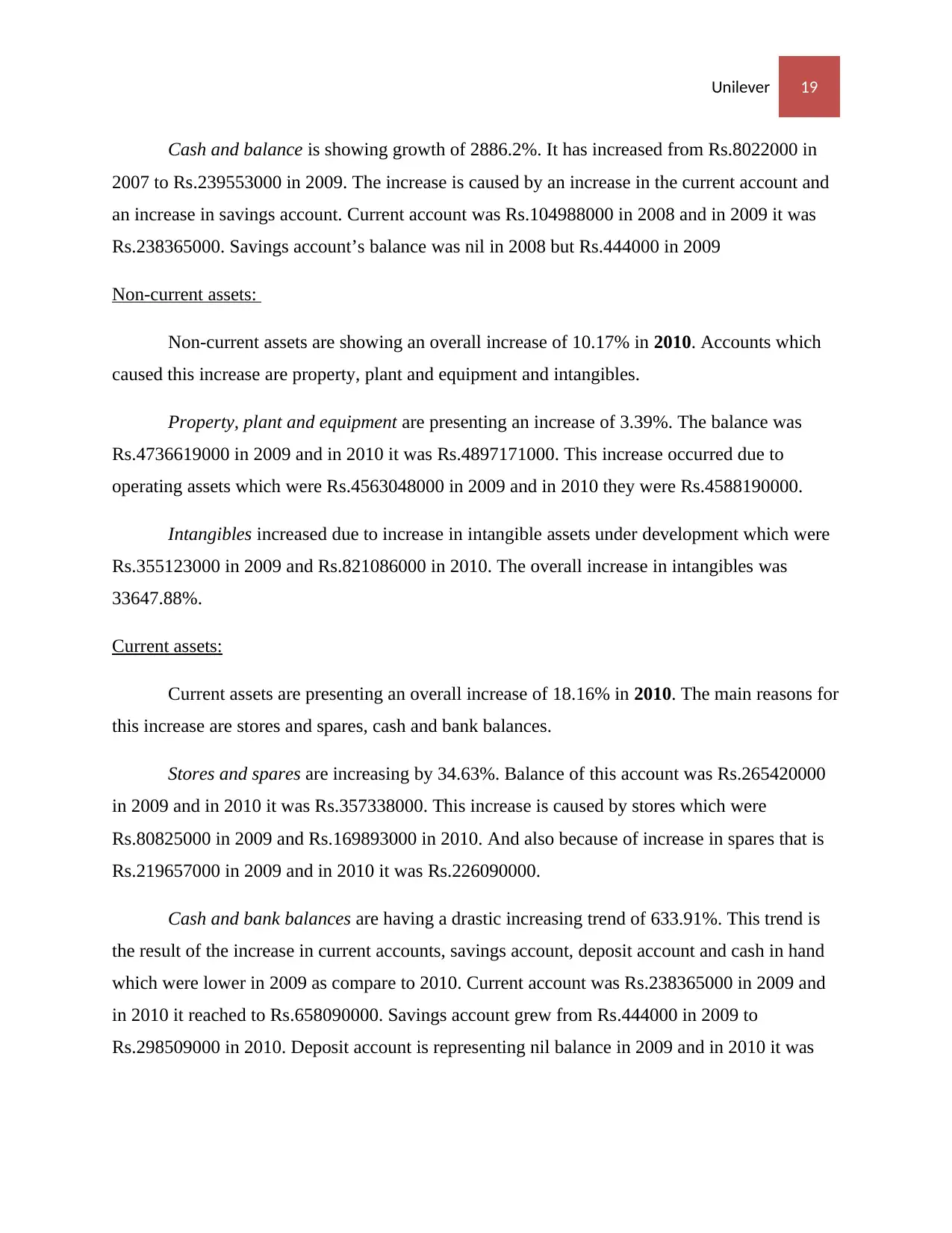
Unilever 19
Cash and balance is showing growth of 2886.2%. It has increased from Rs.8022000 in
2007 to Rs.239553000 in 2009. The increase is caused by an increase in the current account and
an increase in savings account. Current account was Rs.104988000 in 2008 and in 2009 it was
Rs.238365000. Savings account’s balance was nil in 2008 but Rs.444000 in 2009
Non-current assets:
Non-current assets are showing an overall increase of 10.17% in 2010. Accounts which
caused this increase are property, plant and equipment and intangibles.
Property, plant and equipment are presenting an increase of 3.39%. The balance was
Rs.4736619000 in 2009 and in 2010 it was Rs.4897171000. This increase occurred due to
operating assets which were Rs.4563048000 in 2009 and in 2010 they were Rs.4588190000.
Intangibles increased due to increase in intangible assets under development which were
Rs.355123000 in 2009 and Rs.821086000 in 2010. The overall increase in intangibles was
33647.88%.
Current assets:
Current assets are presenting an overall increase of 18.16% in 2010. The main reasons for
this increase are stores and spares, cash and bank balances.
Stores and spares are increasing by 34.63%. Balance of this account was Rs.265420000
in 2009 and in 2010 it was Rs.357338000. This increase is caused by stores which were
Rs.80825000 in 2009 and Rs.169893000 in 2010. And also because of increase in spares that is
Rs.219657000 in 2009 and in 2010 it was Rs.226090000.
Cash and bank balances are having a drastic increasing trend of 633.91%. This trend is
the result of the increase in current accounts, savings account, deposit account and cash in hand
which were lower in 2009 as compare to 2010. Current account was Rs.238365000 in 2009 and
in 2010 it reached to Rs.658090000. Savings account grew from Rs.444000 in 2009 to
Rs.298509000 in 2010. Deposit account is representing nil balance in 2009 and in 2010 it was
Cash and balance is showing growth of 2886.2%. It has increased from Rs.8022000 in
2007 to Rs.239553000 in 2009. The increase is caused by an increase in the current account and
an increase in savings account. Current account was Rs.104988000 in 2008 and in 2009 it was
Rs.238365000. Savings account’s balance was nil in 2008 but Rs.444000 in 2009
Non-current assets:
Non-current assets are showing an overall increase of 10.17% in 2010. Accounts which
caused this increase are property, plant and equipment and intangibles.
Property, plant and equipment are presenting an increase of 3.39%. The balance was
Rs.4736619000 in 2009 and in 2010 it was Rs.4897171000. This increase occurred due to
operating assets which were Rs.4563048000 in 2009 and in 2010 they were Rs.4588190000.
Intangibles increased due to increase in intangible assets under development which were
Rs.355123000 in 2009 and Rs.821086000 in 2010. The overall increase in intangibles was
33647.88%.
Current assets:
Current assets are presenting an overall increase of 18.16% in 2010. The main reasons for
this increase are stores and spares, cash and bank balances.
Stores and spares are increasing by 34.63%. Balance of this account was Rs.265420000
in 2009 and in 2010 it was Rs.357338000. This increase is caused by stores which were
Rs.80825000 in 2009 and Rs.169893000 in 2010. And also because of increase in spares that is
Rs.219657000 in 2009 and in 2010 it was Rs.226090000.
Cash and bank balances are having a drastic increasing trend of 633.91%. This trend is
the result of the increase in current accounts, savings account, deposit account and cash in hand
which were lower in 2009 as compare to 2010. Current account was Rs.238365000 in 2009 and
in 2010 it reached to Rs.658090000. Savings account grew from Rs.444000 in 2009 to
Rs.298509000 in 2010. Deposit account is representing nil balance in 2009 and in 2010 it was
Paraphrase This Document
Need a fresh take? Get an instant paraphrase of this document with our AI Paraphraser
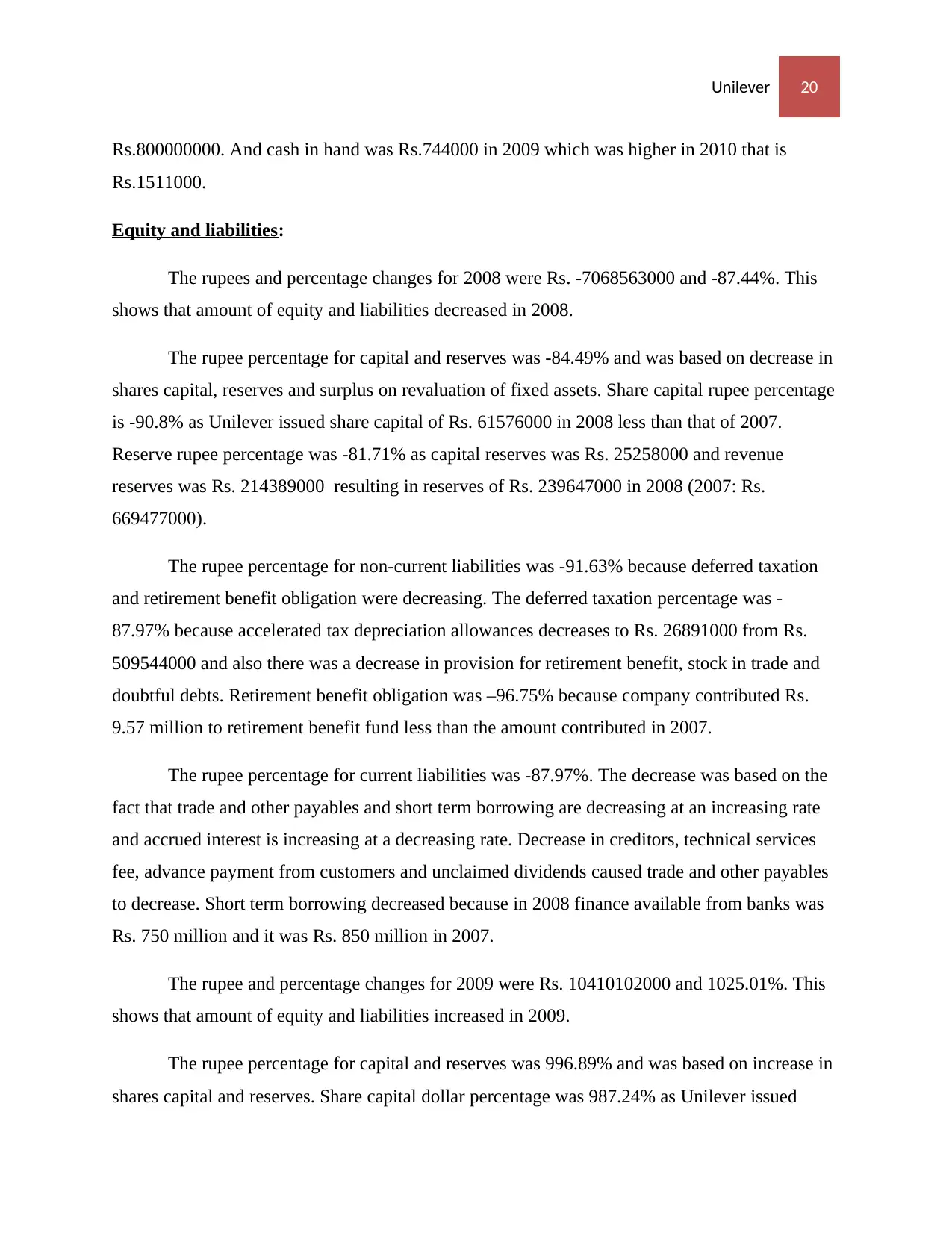
Unilever 20
Rs.800000000. And cash in hand was Rs.744000 in 2009 which was higher in 2010 that is
Rs.1511000.
Equity and liabilities:
The rupees and percentage changes for 2008 were Rs. -7068563000 and -87.44%. This
shows that amount of equity and liabilities decreased in 2008.
The rupee percentage for capital and reserves was -84.49% and was based on decrease in
shares capital, reserves and surplus on revaluation of fixed assets. Share capital rupee percentage
is -90.8% as Unilever issued share capital of Rs. 61576000 in 2008 less than that of 2007.
Reserve rupee percentage was -81.71% as capital reserves was Rs. 25258000 and revenue
reserves was Rs. 214389000 resulting in reserves of Rs. 239647000 in 2008 (2007: Rs.
669477000).
The rupee percentage for non-current liabilities was -91.63% because deferred taxation
and retirement benefit obligation were decreasing. The deferred taxation percentage was -
87.97% because accelerated tax depreciation allowances decreases to Rs. 26891000 from Rs.
509544000 and also there was a decrease in provision for retirement benefit, stock in trade and
doubtful debts. Retirement benefit obligation was –96.75% because company contributed Rs.
9.57 million to retirement benefit fund less than the amount contributed in 2007.
The rupee percentage for current liabilities was -87.97%. The decrease was based on the
fact that trade and other payables and short term borrowing are decreasing at an increasing rate
and accrued interest is increasing at a decreasing rate. Decrease in creditors, technical services
fee, advance payment from customers and unclaimed dividends caused trade and other payables
to decrease. Short term borrowing decreased because in 2008 finance available from banks was
Rs. 750 million and it was Rs. 850 million in 2007.
The rupee and percentage changes for 2009 were Rs. 10410102000 and 1025.01%. This
shows that amount of equity and liabilities increased in 2009.
The rupee percentage for capital and reserves was 996.89% and was based on increase in
shares capital and reserves. Share capital dollar percentage was 987.24% as Unilever issued
Rs.800000000. And cash in hand was Rs.744000 in 2009 which was higher in 2010 that is
Rs.1511000.
Equity and liabilities:
The rupees and percentage changes for 2008 were Rs. -7068563000 and -87.44%. This
shows that amount of equity and liabilities decreased in 2008.
The rupee percentage for capital and reserves was -84.49% and was based on decrease in
shares capital, reserves and surplus on revaluation of fixed assets. Share capital rupee percentage
is -90.8% as Unilever issued share capital of Rs. 61576000 in 2008 less than that of 2007.
Reserve rupee percentage was -81.71% as capital reserves was Rs. 25258000 and revenue
reserves was Rs. 214389000 resulting in reserves of Rs. 239647000 in 2008 (2007: Rs.
669477000).
The rupee percentage for non-current liabilities was -91.63% because deferred taxation
and retirement benefit obligation were decreasing. The deferred taxation percentage was -
87.97% because accelerated tax depreciation allowances decreases to Rs. 26891000 from Rs.
509544000 and also there was a decrease in provision for retirement benefit, stock in trade and
doubtful debts. Retirement benefit obligation was –96.75% because company contributed Rs.
9.57 million to retirement benefit fund less than the amount contributed in 2007.
The rupee percentage for current liabilities was -87.97%. The decrease was based on the
fact that trade and other payables and short term borrowing are decreasing at an increasing rate
and accrued interest is increasing at a decreasing rate. Decrease in creditors, technical services
fee, advance payment from customers and unclaimed dividends caused trade and other payables
to decrease. Short term borrowing decreased because in 2008 finance available from banks was
Rs. 750 million and it was Rs. 850 million in 2007.
The rupee and percentage changes for 2009 were Rs. 10410102000 and 1025.01%. This
shows that amount of equity and liabilities increased in 2009.
The rupee percentage for capital and reserves was 996.89% and was based on increase in
shares capital and reserves. Share capital dollar percentage was 987.24% as Unilever issued
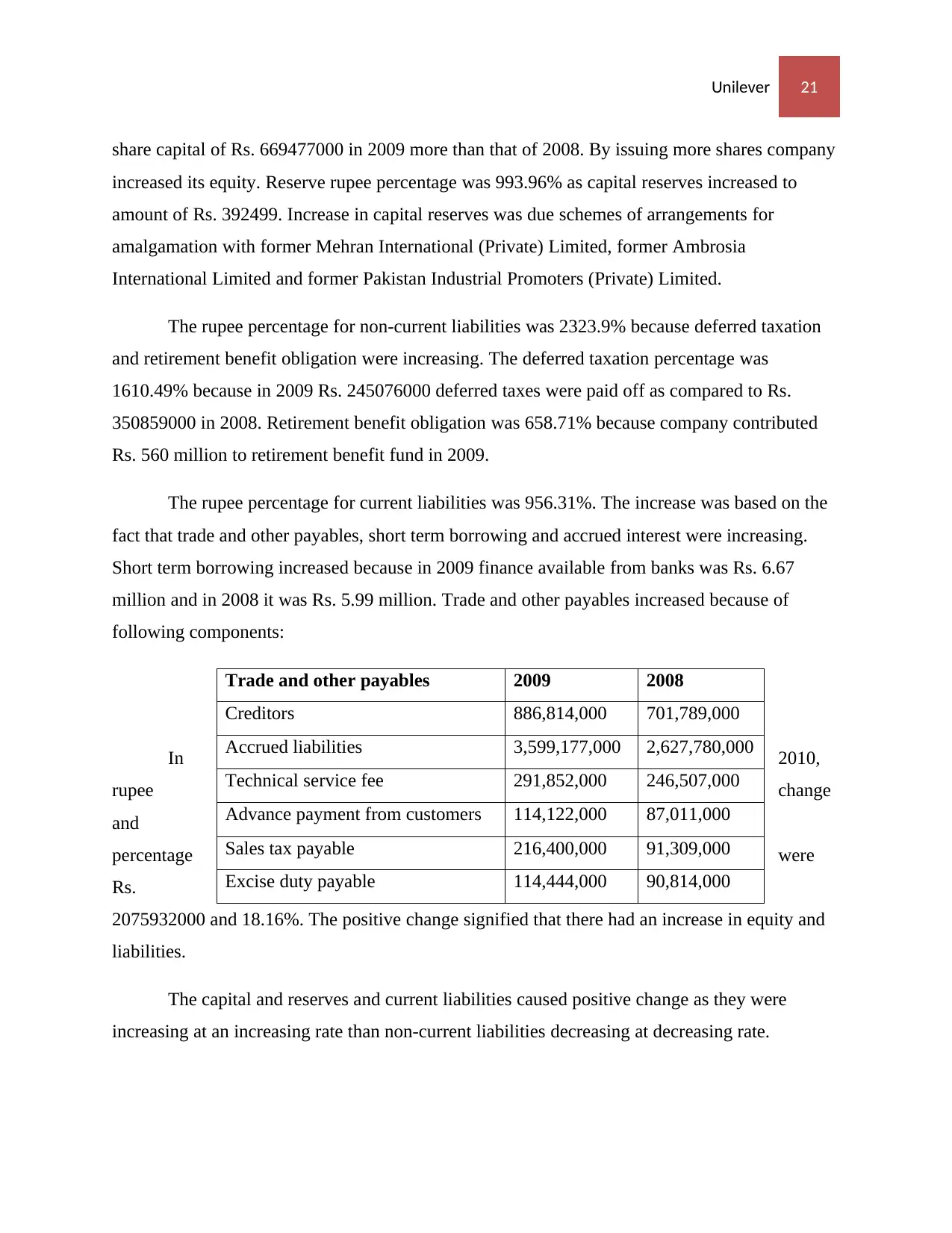
Unilever 21
share capital of Rs. 669477000 in 2009 more than that of 2008. By issuing more shares company
increased its equity. Reserve rupee percentage was 993.96% as capital reserves increased to
amount of Rs. 392499. Increase in capital reserves was due schemes of arrangements for
amalgamation with former Mehran International (Private) Limited, former Ambrosia
International Limited and former Pakistan Industrial Promoters (Private) Limited.
The rupee percentage for non-current liabilities was 2323.9% because deferred taxation
and retirement benefit obligation were increasing. The deferred taxation percentage was
1610.49% because in 2009 Rs. 245076000 deferred taxes were paid off as compared to Rs.
350859000 in 2008. Retirement benefit obligation was 658.71% because company contributed
Rs. 560 million to retirement benefit fund in 2009.
The rupee percentage for current liabilities was 956.31%. The increase was based on the
fact that trade and other payables, short term borrowing and accrued interest were increasing.
Short term borrowing increased because in 2009 finance available from banks was Rs. 6.67
million and in 2008 it was Rs. 5.99 million. Trade and other payables increased because of
following components:
In 2010,
rupee change
and
percentage were
Rs.
2075932000 and 18.16%. The positive change signified that there had an increase in equity and
liabilities.
The capital and reserves and current liabilities caused positive change as they were
increasing at an increasing rate than non-current liabilities decreasing at decreasing rate.
Trade and other payables 2009 2008
Creditors 886,814,000 701,789,000
Accrued liabilities 3,599,177,000 2,627,780,000
Technical service fee 291,852,000 246,507,000
Advance payment from customers 114,122,000 87,011,000
Sales tax payable 216,400,000 91,309,000
Excise duty payable 114,444,000 90,814,000
share capital of Rs. 669477000 in 2009 more than that of 2008. By issuing more shares company
increased its equity. Reserve rupee percentage was 993.96% as capital reserves increased to
amount of Rs. 392499. Increase in capital reserves was due schemes of arrangements for
amalgamation with former Mehran International (Private) Limited, former Ambrosia
International Limited and former Pakistan Industrial Promoters (Private) Limited.
The rupee percentage for non-current liabilities was 2323.9% because deferred taxation
and retirement benefit obligation were increasing. The deferred taxation percentage was
1610.49% because in 2009 Rs. 245076000 deferred taxes were paid off as compared to Rs.
350859000 in 2008. Retirement benefit obligation was 658.71% because company contributed
Rs. 560 million to retirement benefit fund in 2009.
The rupee percentage for current liabilities was 956.31%. The increase was based on the
fact that trade and other payables, short term borrowing and accrued interest were increasing.
Short term borrowing increased because in 2009 finance available from banks was Rs. 6.67
million and in 2008 it was Rs. 5.99 million. Trade and other payables increased because of
following components:
In 2010,
rupee change
and
percentage were
Rs.
2075932000 and 18.16%. The positive change signified that there had an increase in equity and
liabilities.
The capital and reserves and current liabilities caused positive change as they were
increasing at an increasing rate than non-current liabilities decreasing at decreasing rate.
Trade and other payables 2009 2008
Creditors 886,814,000 701,789,000
Accrued liabilities 3,599,177,000 2,627,780,000
Technical service fee 291,852,000 246,507,000
Advance payment from customers 114,122,000 87,011,000
Sales tax payable 216,400,000 91,309,000
Excise duty payable 114,444,000 90,814,000
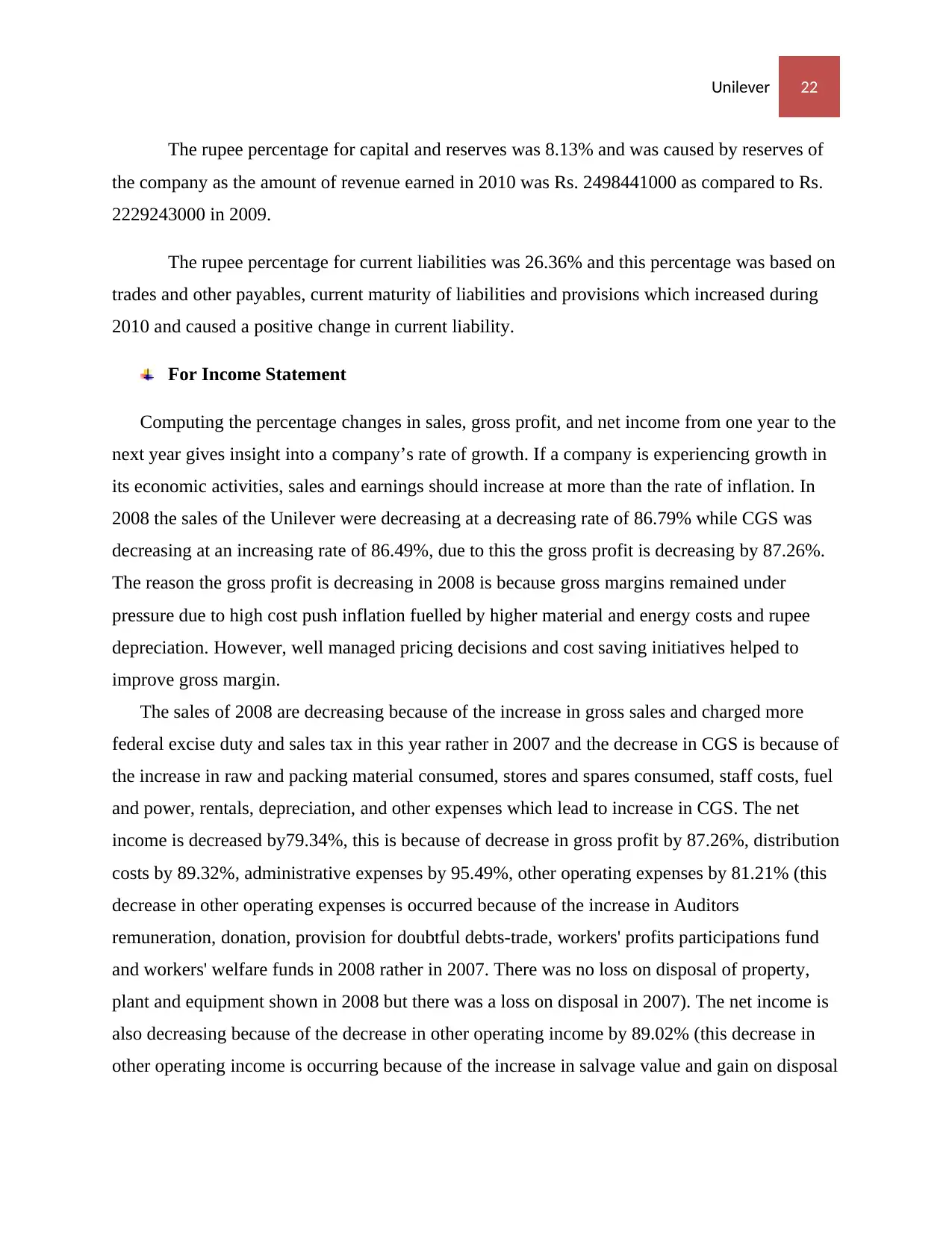
Unilever 22
The rupee percentage for capital and reserves was 8.13% and was caused by reserves of
the company as the amount of revenue earned in 2010 was Rs. 2498441000 as compared to Rs.
2229243000 in 2009.
The rupee percentage for current liabilities was 26.36% and this percentage was based on
trades and other payables, current maturity of liabilities and provisions which increased during
2010 and caused a positive change in current liability.
For Income Statement
Computing the percentage changes in sales, gross profit, and net income from one year to the
next year gives insight into a company’s rate of growth. If a company is experiencing growth in
its economic activities, sales and earnings should increase at more than the rate of inflation. In
2008 the sales of the Unilever were decreasing at a decreasing rate of 86.79% while CGS was
decreasing at an increasing rate of 86.49%, due to this the gross profit is decreasing by 87.26%.
The reason the gross profit is decreasing in 2008 is because gross margins remained under
pressure due to high cost push inflation fuelled by higher material and energy costs and rupee
depreciation. However, well managed pricing decisions and cost saving initiatives helped to
improve gross margin.
The sales of 2008 are decreasing because of the increase in gross sales and charged more
federal excise duty and sales tax in this year rather in 2007 and the decrease in CGS is because of
the increase in raw and packing material consumed, stores and spares consumed, staff costs, fuel
and power, rentals, depreciation, and other expenses which lead to increase in CGS. The net
income is decreased by79.34%, this is because of decrease in gross profit by 87.26%, distribution
costs by 89.32%, administrative expenses by 95.49%, other operating expenses by 81.21% (this
decrease in other operating expenses is occurred because of the increase in Auditors
remuneration, donation, provision for doubtful debts-trade, workers' profits participations fund
and workers' welfare funds in 2008 rather in 2007. There was no loss on disposal of property,
plant and equipment shown in 2008 but there was a loss on disposal in 2007). The net income is
also decreasing because of the decrease in other operating income by 89.02% (this decrease in
other operating income is occurring because of the increase in salvage value and gain on disposal
The rupee percentage for capital and reserves was 8.13% and was caused by reserves of
the company as the amount of revenue earned in 2010 was Rs. 2498441000 as compared to Rs.
2229243000 in 2009.
The rupee percentage for current liabilities was 26.36% and this percentage was based on
trades and other payables, current maturity of liabilities and provisions which increased during
2010 and caused a positive change in current liability.
For Income Statement
Computing the percentage changes in sales, gross profit, and net income from one year to the
next year gives insight into a company’s rate of growth. If a company is experiencing growth in
its economic activities, sales and earnings should increase at more than the rate of inflation. In
2008 the sales of the Unilever were decreasing at a decreasing rate of 86.79% while CGS was
decreasing at an increasing rate of 86.49%, due to this the gross profit is decreasing by 87.26%.
The reason the gross profit is decreasing in 2008 is because gross margins remained under
pressure due to high cost push inflation fuelled by higher material and energy costs and rupee
depreciation. However, well managed pricing decisions and cost saving initiatives helped to
improve gross margin.
The sales of 2008 are decreasing because of the increase in gross sales and charged more
federal excise duty and sales tax in this year rather in 2007 and the decrease in CGS is because of
the increase in raw and packing material consumed, stores and spares consumed, staff costs, fuel
and power, rentals, depreciation, and other expenses which lead to increase in CGS. The net
income is decreased by79.34%, this is because of decrease in gross profit by 87.26%, distribution
costs by 89.32%, administrative expenses by 95.49%, other operating expenses by 81.21% (this
decrease in other operating expenses is occurred because of the increase in Auditors
remuneration, donation, provision for doubtful debts-trade, workers' profits participations fund
and workers' welfare funds in 2008 rather in 2007. There was no loss on disposal of property,
plant and equipment shown in 2008 but there was a loss on disposal in 2007). The net income is
also decreasing because of the decrease in other operating income by 89.02% (this decrease in
other operating income is occurring because of the increase in salvage value and gain on disposal
Secure Best Marks with AI Grader
Need help grading? Try our AI Grader for instant feedback on your assignments.
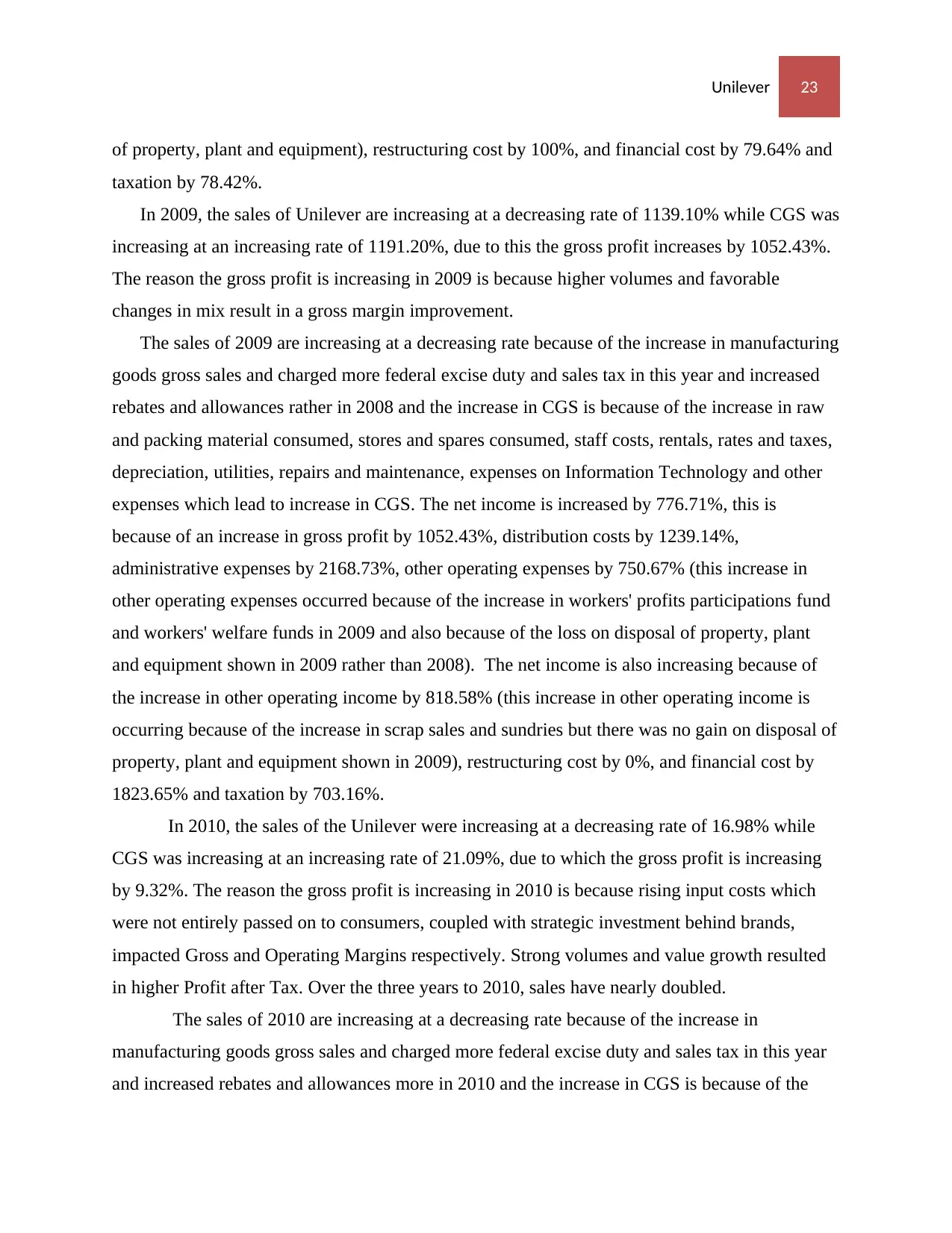
Unilever 23
of property, plant and equipment), restructuring cost by 100%, and financial cost by 79.64% and
taxation by 78.42%.
In 2009, the sales of Unilever are increasing at a decreasing rate of 1139.10% while CGS was
increasing at an increasing rate of 1191.20%, due to this the gross profit increases by 1052.43%.
The reason the gross profit is increasing in 2009 is because higher volumes and favorable
changes in mix result in a gross margin improvement.
The sales of 2009 are increasing at a decreasing rate because of the increase in manufacturing
goods gross sales and charged more federal excise duty and sales tax in this year and increased
rebates and allowances rather in 2008 and the increase in CGS is because of the increase in raw
and packing material consumed, stores and spares consumed, staff costs, rentals, rates and taxes,
depreciation, utilities, repairs and maintenance, expenses on Information Technology and other
expenses which lead to increase in CGS. The net income is increased by 776.71%, this is
because of an increase in gross profit by 1052.43%, distribution costs by 1239.14%,
administrative expenses by 2168.73%, other operating expenses by 750.67% (this increase in
other operating expenses occurred because of the increase in workers' profits participations fund
and workers' welfare funds in 2009 and also because of the loss on disposal of property, plant
and equipment shown in 2009 rather than 2008). The net income is also increasing because of
the increase in other operating income by 818.58% (this increase in other operating income is
occurring because of the increase in scrap sales and sundries but there was no gain on disposal of
property, plant and equipment shown in 2009), restructuring cost by 0%, and financial cost by
1823.65% and taxation by 703.16%.
In 2010, the sales of the Unilever were increasing at a decreasing rate of 16.98% while
CGS was increasing at an increasing rate of 21.09%, due to which the gross profit is increasing
by 9.32%. The reason the gross profit is increasing in 2010 is because rising input costs which
were not entirely passed on to consumers, coupled with strategic investment behind brands,
impacted Gross and Operating Margins respectively. Strong volumes and value growth resulted
in higher Profit after Tax. Over the three years to 2010, sales have nearly doubled.
The sales of 2010 are increasing at a decreasing rate because of the increase in
manufacturing goods gross sales and charged more federal excise duty and sales tax in this year
and increased rebates and allowances more in 2010 and the increase in CGS is because of the
of property, plant and equipment), restructuring cost by 100%, and financial cost by 79.64% and
taxation by 78.42%.
In 2009, the sales of Unilever are increasing at a decreasing rate of 1139.10% while CGS was
increasing at an increasing rate of 1191.20%, due to this the gross profit increases by 1052.43%.
The reason the gross profit is increasing in 2009 is because higher volumes and favorable
changes in mix result in a gross margin improvement.
The sales of 2009 are increasing at a decreasing rate because of the increase in manufacturing
goods gross sales and charged more federal excise duty and sales tax in this year and increased
rebates and allowances rather in 2008 and the increase in CGS is because of the increase in raw
and packing material consumed, stores and spares consumed, staff costs, rentals, rates and taxes,
depreciation, utilities, repairs and maintenance, expenses on Information Technology and other
expenses which lead to increase in CGS. The net income is increased by 776.71%, this is
because of an increase in gross profit by 1052.43%, distribution costs by 1239.14%,
administrative expenses by 2168.73%, other operating expenses by 750.67% (this increase in
other operating expenses occurred because of the increase in workers' profits participations fund
and workers' welfare funds in 2009 and also because of the loss on disposal of property, plant
and equipment shown in 2009 rather than 2008). The net income is also increasing because of
the increase in other operating income by 818.58% (this increase in other operating income is
occurring because of the increase in scrap sales and sundries but there was no gain on disposal of
property, plant and equipment shown in 2009), restructuring cost by 0%, and financial cost by
1823.65% and taxation by 703.16%.
In 2010, the sales of the Unilever were increasing at a decreasing rate of 16.98% while
CGS was increasing at an increasing rate of 21.09%, due to which the gross profit is increasing
by 9.32%. The reason the gross profit is increasing in 2010 is because rising input costs which
were not entirely passed on to consumers, coupled with strategic investment behind brands,
impacted Gross and Operating Margins respectively. Strong volumes and value growth resulted
in higher Profit after Tax. Over the three years to 2010, sales have nearly doubled.
The sales of 2010 are increasing at a decreasing rate because of the increase in
manufacturing goods gross sales and charged more federal excise duty and sales tax in this year
and increased rebates and allowances more in 2010 and the increase in CGS is because of the
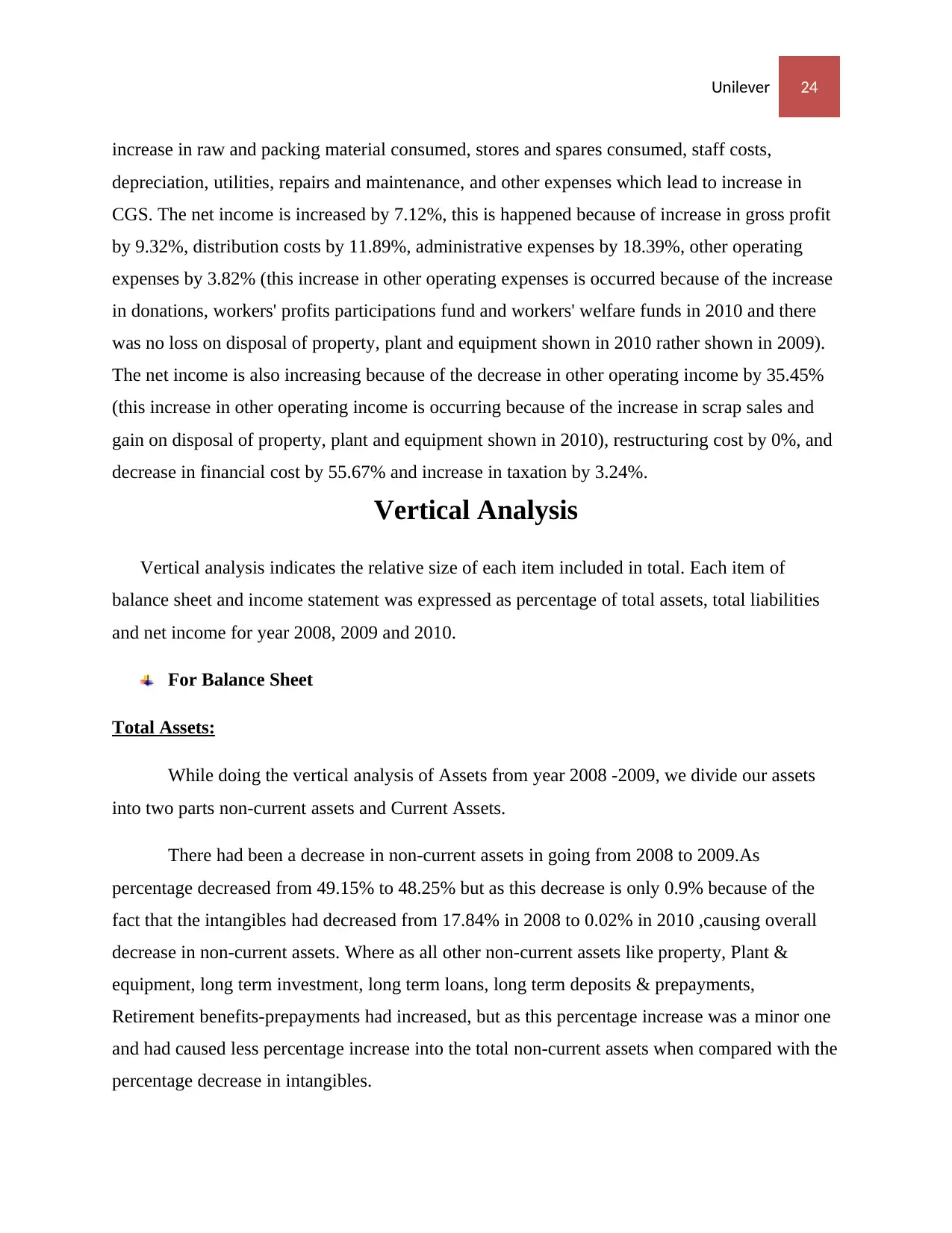
Unilever 24
increase in raw and packing material consumed, stores and spares consumed, staff costs,
depreciation, utilities, repairs and maintenance, and other expenses which lead to increase in
CGS. The net income is increased by 7.12%, this is happened because of increase in gross profit
by 9.32%, distribution costs by 11.89%, administrative expenses by 18.39%, other operating
expenses by 3.82% (this increase in other operating expenses is occurred because of the increase
in donations, workers' profits participations fund and workers' welfare funds in 2010 and there
was no loss on disposal of property, plant and equipment shown in 2010 rather shown in 2009).
The net income is also increasing because of the decrease in other operating income by 35.45%
(this increase in other operating income is occurring because of the increase in scrap sales and
gain on disposal of property, plant and equipment shown in 2010), restructuring cost by 0%, and
decrease in financial cost by 55.67% and increase in taxation by 3.24%.
Vertical Analysis
Vertical analysis indicates the relative size of each item included in total. Each item of
balance sheet and income statement was expressed as percentage of total assets, total liabilities
and net income for year 2008, 2009 and 2010.
For Balance Sheet
Total Assets:
While doing the vertical analysis of Assets from year 2008 -2009, we divide our assets
into two parts non-current assets and Current Assets.
There had been a decrease in non-current assets in going from 2008 to 2009.As
percentage decreased from 49.15% to 48.25% but as this decrease is only 0.9% because of the
fact that the intangibles had decreased from 17.84% in 2008 to 0.02% in 2010 ,causing overall
decrease in non-current assets. Where as all other non-current assets like property, Plant &
equipment, long term investment, long term loans, long term deposits & prepayments,
Retirement benefits-prepayments had increased, but as this percentage increase was a minor one
and had caused less percentage increase into the total non-current assets when compared with the
percentage decrease in intangibles.
increase in raw and packing material consumed, stores and spares consumed, staff costs,
depreciation, utilities, repairs and maintenance, and other expenses which lead to increase in
CGS. The net income is increased by 7.12%, this is happened because of increase in gross profit
by 9.32%, distribution costs by 11.89%, administrative expenses by 18.39%, other operating
expenses by 3.82% (this increase in other operating expenses is occurred because of the increase
in donations, workers' profits participations fund and workers' welfare funds in 2010 and there
was no loss on disposal of property, plant and equipment shown in 2010 rather shown in 2009).
The net income is also increasing because of the decrease in other operating income by 35.45%
(this increase in other operating income is occurring because of the increase in scrap sales and
gain on disposal of property, plant and equipment shown in 2010), restructuring cost by 0%, and
decrease in financial cost by 55.67% and increase in taxation by 3.24%.
Vertical Analysis
Vertical analysis indicates the relative size of each item included in total. Each item of
balance sheet and income statement was expressed as percentage of total assets, total liabilities
and net income for year 2008, 2009 and 2010.
For Balance Sheet
Total Assets:
While doing the vertical analysis of Assets from year 2008 -2009, we divide our assets
into two parts non-current assets and Current Assets.
There had been a decrease in non-current assets in going from 2008 to 2009.As
percentage decreased from 49.15% to 48.25% but as this decrease is only 0.9% because of the
fact that the intangibles had decreased from 17.84% in 2008 to 0.02% in 2010 ,causing overall
decrease in non-current assets. Where as all other non-current assets like property, Plant &
equipment, long term investment, long term loans, long term deposits & prepayments,
Retirement benefits-prepayments had increased, but as this percentage increase was a minor one
and had caused less percentage increase into the total non-current assets when compared with the
percentage decrease in intangibles.
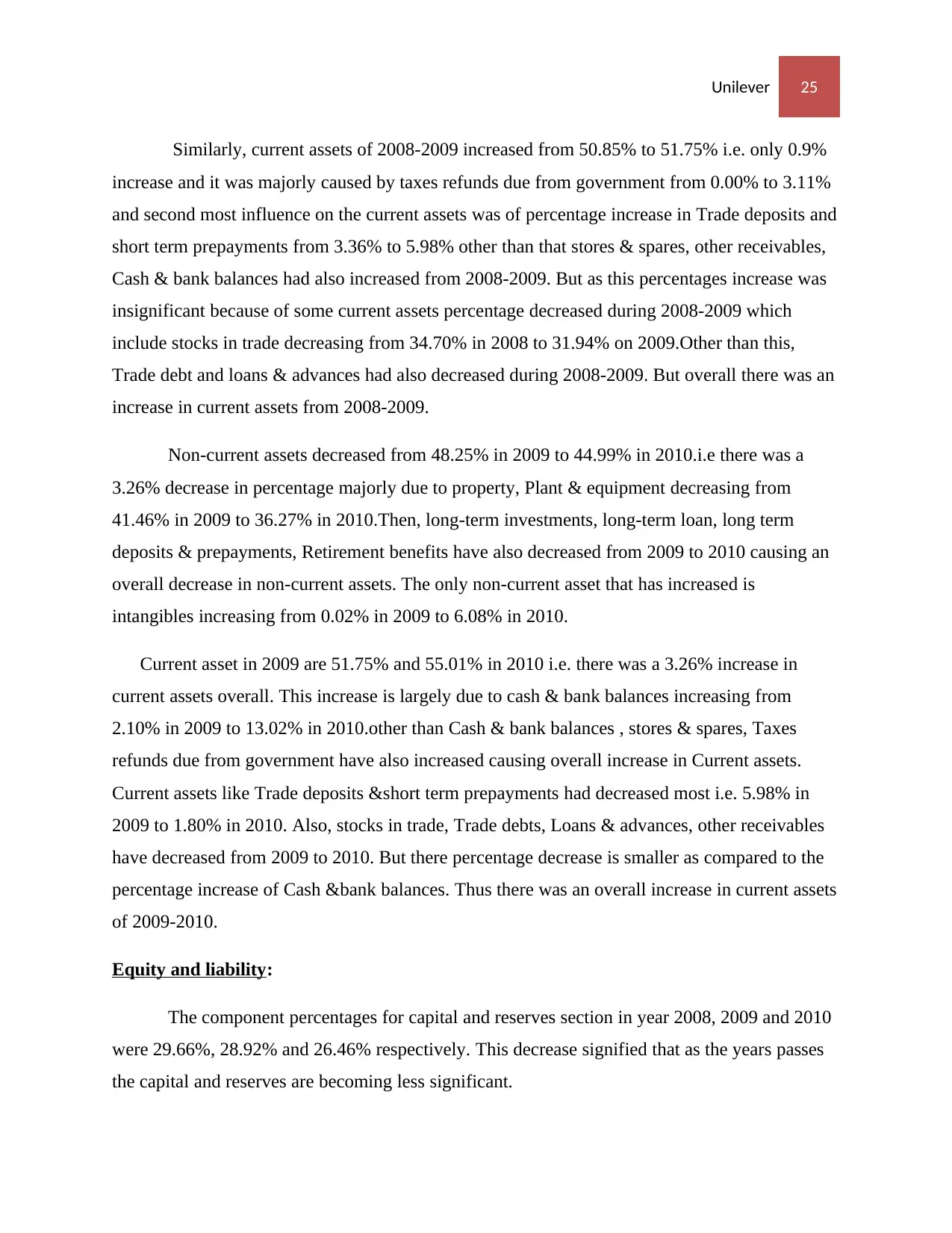
Unilever 25
Similarly, current assets of 2008-2009 increased from 50.85% to 51.75% i.e. only 0.9%
increase and it was majorly caused by taxes refunds due from government from 0.00% to 3.11%
and second most influence on the current assets was of percentage increase in Trade deposits and
short term prepayments from 3.36% to 5.98% other than that stores & spares, other receivables,
Cash & bank balances had also increased from 2008-2009. But as this percentages increase was
insignificant because of some current assets percentage decreased during 2008-2009 which
include stocks in trade decreasing from 34.70% in 2008 to 31.94% on 2009.Other than this,
Trade debt and loans & advances had also decreased during 2008-2009. But overall there was an
increase in current assets from 2008-2009.
Non-current assets decreased from 48.25% in 2009 to 44.99% in 2010.i.e there was a
3.26% decrease in percentage majorly due to property, Plant & equipment decreasing from
41.46% in 2009 to 36.27% in 2010.Then, long-term investments, long-term loan, long term
deposits & prepayments, Retirement benefits have also decreased from 2009 to 2010 causing an
overall decrease in non-current assets. The only non-current asset that has increased is
intangibles increasing from 0.02% in 2009 to 6.08% in 2010.
Current asset in 2009 are 51.75% and 55.01% in 2010 i.e. there was a 3.26% increase in
current assets overall. This increase is largely due to cash & bank balances increasing from
2.10% in 2009 to 13.02% in 2010.other than Cash & bank balances , stores & spares, Taxes
refunds due from government have also increased causing overall increase in Current assets.
Current assets like Trade deposits &short term prepayments had decreased most i.e. 5.98% in
2009 to 1.80% in 2010. Also, stocks in trade, Trade debts, Loans & advances, other receivables
have decreased from 2009 to 2010. But there percentage decrease is smaller as compared to the
percentage increase of Cash &bank balances. Thus there was an overall increase in current assets
of 2009-2010.
Equity and liability:
The component percentages for capital and reserves section in year 2008, 2009 and 2010
were 29.66%, 28.92% and 26.46% respectively. This decrease signified that as the years passes
the capital and reserves are becoming less significant.
Similarly, current assets of 2008-2009 increased from 50.85% to 51.75% i.e. only 0.9%
increase and it was majorly caused by taxes refunds due from government from 0.00% to 3.11%
and second most influence on the current assets was of percentage increase in Trade deposits and
short term prepayments from 3.36% to 5.98% other than that stores & spares, other receivables,
Cash & bank balances had also increased from 2008-2009. But as this percentages increase was
insignificant because of some current assets percentage decreased during 2008-2009 which
include stocks in trade decreasing from 34.70% in 2008 to 31.94% on 2009.Other than this,
Trade debt and loans & advances had also decreased during 2008-2009. But overall there was an
increase in current assets from 2008-2009.
Non-current assets decreased from 48.25% in 2009 to 44.99% in 2010.i.e there was a
3.26% decrease in percentage majorly due to property, Plant & equipment decreasing from
41.46% in 2009 to 36.27% in 2010.Then, long-term investments, long-term loan, long term
deposits & prepayments, Retirement benefits have also decreased from 2009 to 2010 causing an
overall decrease in non-current assets. The only non-current asset that has increased is
intangibles increasing from 0.02% in 2009 to 6.08% in 2010.
Current asset in 2009 are 51.75% and 55.01% in 2010 i.e. there was a 3.26% increase in
current assets overall. This increase is largely due to cash & bank balances increasing from
2.10% in 2009 to 13.02% in 2010.other than Cash & bank balances , stores & spares, Taxes
refunds due from government have also increased causing overall increase in Current assets.
Current assets like Trade deposits &short term prepayments had decreased most i.e. 5.98% in
2009 to 1.80% in 2010. Also, stocks in trade, Trade debts, Loans & advances, other receivables
have decreased from 2009 to 2010. But there percentage decrease is smaller as compared to the
percentage increase of Cash &bank balances. Thus there was an overall increase in current assets
of 2009-2010.
Equity and liability:
The component percentages for capital and reserves section in year 2008, 2009 and 2010
were 29.66%, 28.92% and 26.46% respectively. This decrease signified that as the years passes
the capital and reserves are becoming less significant.
Paraphrase This Document
Need a fresh take? Get an instant paraphrase of this document with our AI Paraphraser
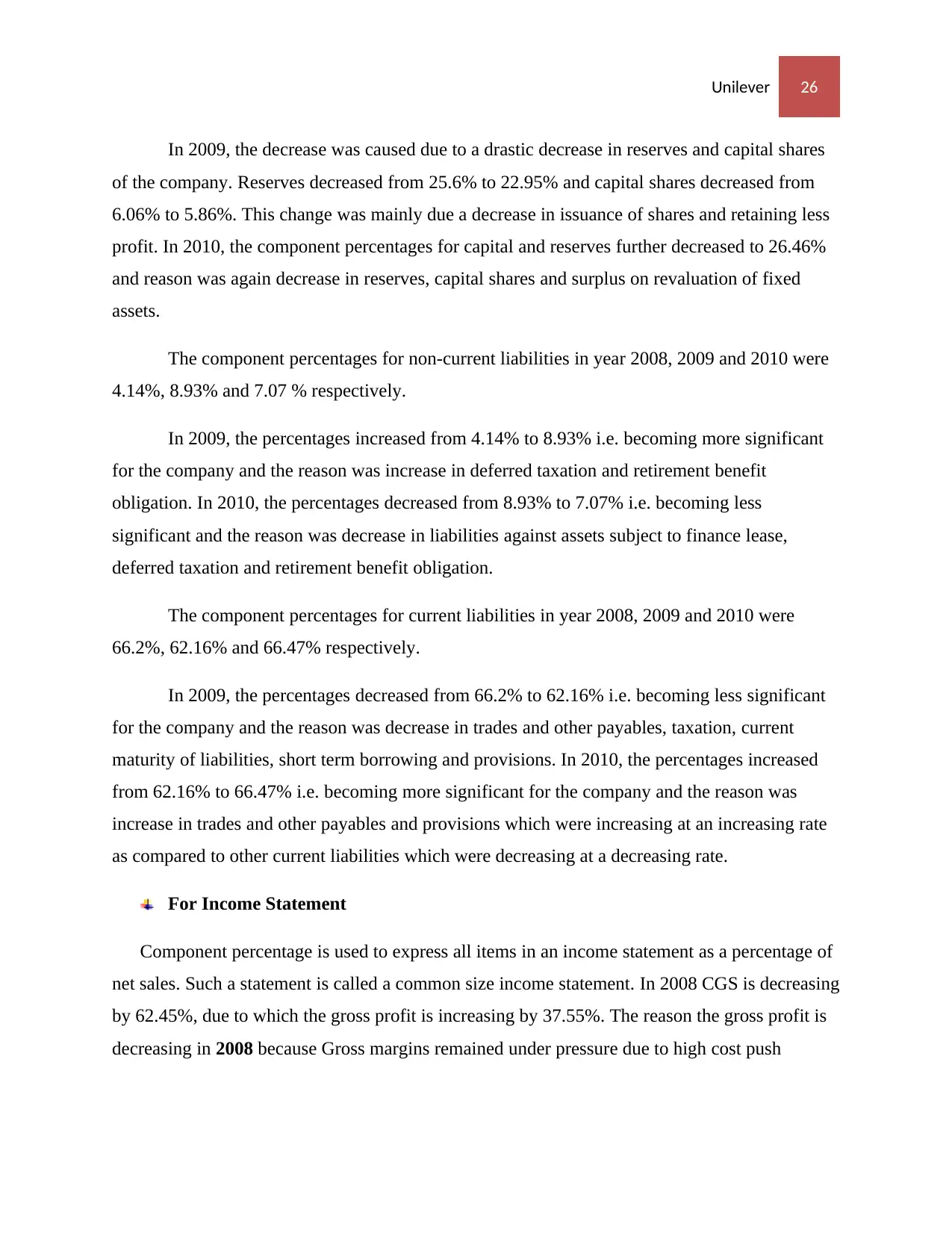
Unilever 26
In 2009, the decrease was caused due to a drastic decrease in reserves and capital shares
of the company. Reserves decreased from 25.6% to 22.95% and capital shares decreased from
6.06% to 5.86%. This change was mainly due a decrease in issuance of shares and retaining less
profit. In 2010, the component percentages for capital and reserves further decreased to 26.46%
and reason was again decrease in reserves, capital shares and surplus on revaluation of fixed
assets.
The component percentages for non-current liabilities in year 2008, 2009 and 2010 were
4.14%, 8.93% and 7.07 % respectively.
In 2009, the percentages increased from 4.14% to 8.93% i.e. becoming more significant
for the company and the reason was increase in deferred taxation and retirement benefit
obligation. In 2010, the percentages decreased from 8.93% to 7.07% i.e. becoming less
significant and the reason was decrease in liabilities against assets subject to finance lease,
deferred taxation and retirement benefit obligation.
The component percentages for current liabilities in year 2008, 2009 and 2010 were
66.2%, 62.16% and 66.47% respectively.
In 2009, the percentages decreased from 66.2% to 62.16% i.e. becoming less significant
for the company and the reason was decrease in trades and other payables, taxation, current
maturity of liabilities, short term borrowing and provisions. In 2010, the percentages increased
from 62.16% to 66.47% i.e. becoming more significant for the company and the reason was
increase in trades and other payables and provisions which were increasing at an increasing rate
as compared to other current liabilities which were decreasing at a decreasing rate.
For Income Statement
Component percentage is used to express all items in an income statement as a percentage of
net sales. Such a statement is called a common size income statement. In 2008 CGS is decreasing
by 62.45%, due to which the gross profit is increasing by 37.55%. The reason the gross profit is
decreasing in 2008 because Gross margins remained under pressure due to high cost push
In 2009, the decrease was caused due to a drastic decrease in reserves and capital shares
of the company. Reserves decreased from 25.6% to 22.95% and capital shares decreased from
6.06% to 5.86%. This change was mainly due a decrease in issuance of shares and retaining less
profit. In 2010, the component percentages for capital and reserves further decreased to 26.46%
and reason was again decrease in reserves, capital shares and surplus on revaluation of fixed
assets.
The component percentages for non-current liabilities in year 2008, 2009 and 2010 were
4.14%, 8.93% and 7.07 % respectively.
In 2009, the percentages increased from 4.14% to 8.93% i.e. becoming more significant
for the company and the reason was increase in deferred taxation and retirement benefit
obligation. In 2010, the percentages decreased from 8.93% to 7.07% i.e. becoming less
significant and the reason was decrease in liabilities against assets subject to finance lease,
deferred taxation and retirement benefit obligation.
The component percentages for current liabilities in year 2008, 2009 and 2010 were
66.2%, 62.16% and 66.47% respectively.
In 2009, the percentages decreased from 66.2% to 62.16% i.e. becoming less significant
for the company and the reason was decrease in trades and other payables, taxation, current
maturity of liabilities, short term borrowing and provisions. In 2010, the percentages increased
from 62.16% to 66.47% i.e. becoming more significant for the company and the reason was
increase in trades and other payables and provisions which were increasing at an increasing rate
as compared to other current liabilities which were decreasing at a decreasing rate.
For Income Statement
Component percentage is used to express all items in an income statement as a percentage of
net sales. Such a statement is called a common size income statement. In 2008 CGS is decreasing
by 62.45%, due to which the gross profit is increasing by 37.55%. The reason the gross profit is
decreasing in 2008 because Gross margins remained under pressure due to high cost push
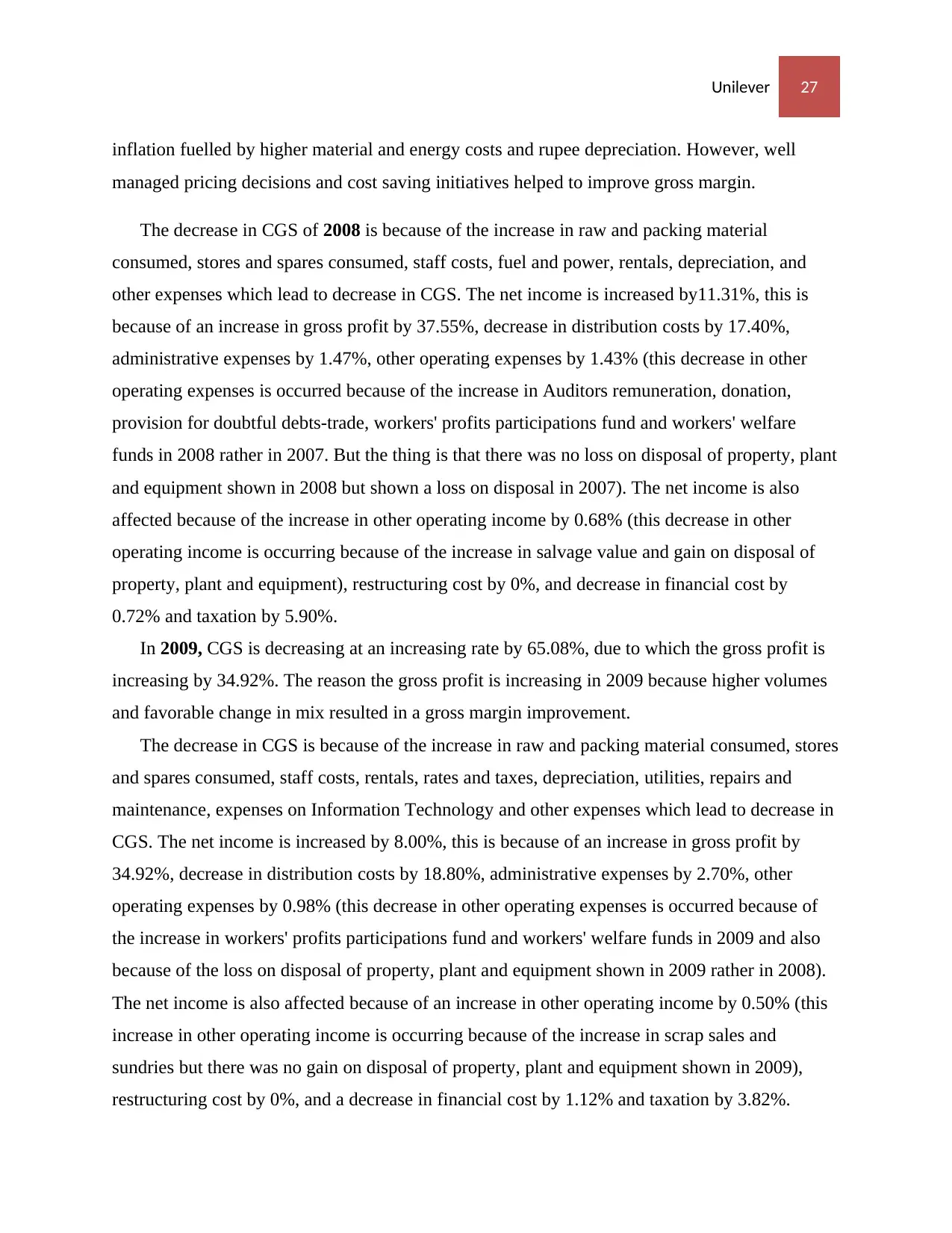
Unilever 27
inflation fuelled by higher material and energy costs and rupee depreciation. However, well
managed pricing decisions and cost saving initiatives helped to improve gross margin.
The decrease in CGS of 2008 is because of the increase in raw and packing material
consumed, stores and spares consumed, staff costs, fuel and power, rentals, depreciation, and
other expenses which lead to decrease in CGS. The net income is increased by11.31%, this is
because of an increase in gross profit by 37.55%, decrease in distribution costs by 17.40%,
administrative expenses by 1.47%, other operating expenses by 1.43% (this decrease in other
operating expenses is occurred because of the increase in Auditors remuneration, donation,
provision for doubtful debts-trade, workers' profits participations fund and workers' welfare
funds in 2008 rather in 2007. But the thing is that there was no loss on disposal of property, plant
and equipment shown in 2008 but shown a loss on disposal in 2007). The net income is also
affected because of the increase in other operating income by 0.68% (this decrease in other
operating income is occurring because of the increase in salvage value and gain on disposal of
property, plant and equipment), restructuring cost by 0%, and decrease in financial cost by
0.72% and taxation by 5.90%.
In 2009, CGS is decreasing at an increasing rate by 65.08%, due to which the gross profit is
increasing by 34.92%. The reason the gross profit is increasing in 2009 because higher volumes
and favorable change in mix resulted in a gross margin improvement.
The decrease in CGS is because of the increase in raw and packing material consumed, stores
and spares consumed, staff costs, rentals, rates and taxes, depreciation, utilities, repairs and
maintenance, expenses on Information Technology and other expenses which lead to decrease in
CGS. The net income is increased by 8.00%, this is because of an increase in gross profit by
34.92%, decrease in distribution costs by 18.80%, administrative expenses by 2.70%, other
operating expenses by 0.98% (this decrease in other operating expenses is occurred because of
the increase in workers' profits participations fund and workers' welfare funds in 2009 and also
because of the loss on disposal of property, plant and equipment shown in 2009 rather in 2008).
The net income is also affected because of an increase in other operating income by 0.50% (this
increase in other operating income is occurring because of the increase in scrap sales and
sundries but there was no gain on disposal of property, plant and equipment shown in 2009),
restructuring cost by 0%, and a decrease in financial cost by 1.12% and taxation by 3.82%.
inflation fuelled by higher material and energy costs and rupee depreciation. However, well
managed pricing decisions and cost saving initiatives helped to improve gross margin.
The decrease in CGS of 2008 is because of the increase in raw and packing material
consumed, stores and spares consumed, staff costs, fuel and power, rentals, depreciation, and
other expenses which lead to decrease in CGS. The net income is increased by11.31%, this is
because of an increase in gross profit by 37.55%, decrease in distribution costs by 17.40%,
administrative expenses by 1.47%, other operating expenses by 1.43% (this decrease in other
operating expenses is occurred because of the increase in Auditors remuneration, donation,
provision for doubtful debts-trade, workers' profits participations fund and workers' welfare
funds in 2008 rather in 2007. But the thing is that there was no loss on disposal of property, plant
and equipment shown in 2008 but shown a loss on disposal in 2007). The net income is also
affected because of the increase in other operating income by 0.68% (this decrease in other
operating income is occurring because of the increase in salvage value and gain on disposal of
property, plant and equipment), restructuring cost by 0%, and decrease in financial cost by
0.72% and taxation by 5.90%.
In 2009, CGS is decreasing at an increasing rate by 65.08%, due to which the gross profit is
increasing by 34.92%. The reason the gross profit is increasing in 2009 because higher volumes
and favorable change in mix resulted in a gross margin improvement.
The decrease in CGS is because of the increase in raw and packing material consumed, stores
and spares consumed, staff costs, rentals, rates and taxes, depreciation, utilities, repairs and
maintenance, expenses on Information Technology and other expenses which lead to decrease in
CGS. The net income is increased by 8.00%, this is because of an increase in gross profit by
34.92%, decrease in distribution costs by 18.80%, administrative expenses by 2.70%, other
operating expenses by 0.98% (this decrease in other operating expenses is occurred because of
the increase in workers' profits participations fund and workers' welfare funds in 2009 and also
because of the loss on disposal of property, plant and equipment shown in 2009 rather in 2008).
The net income is also affected because of an increase in other operating income by 0.50% (this
increase in other operating income is occurring because of the increase in scrap sales and
sundries but there was no gain on disposal of property, plant and equipment shown in 2009),
restructuring cost by 0%, and a decrease in financial cost by 1.12% and taxation by 3.82%.
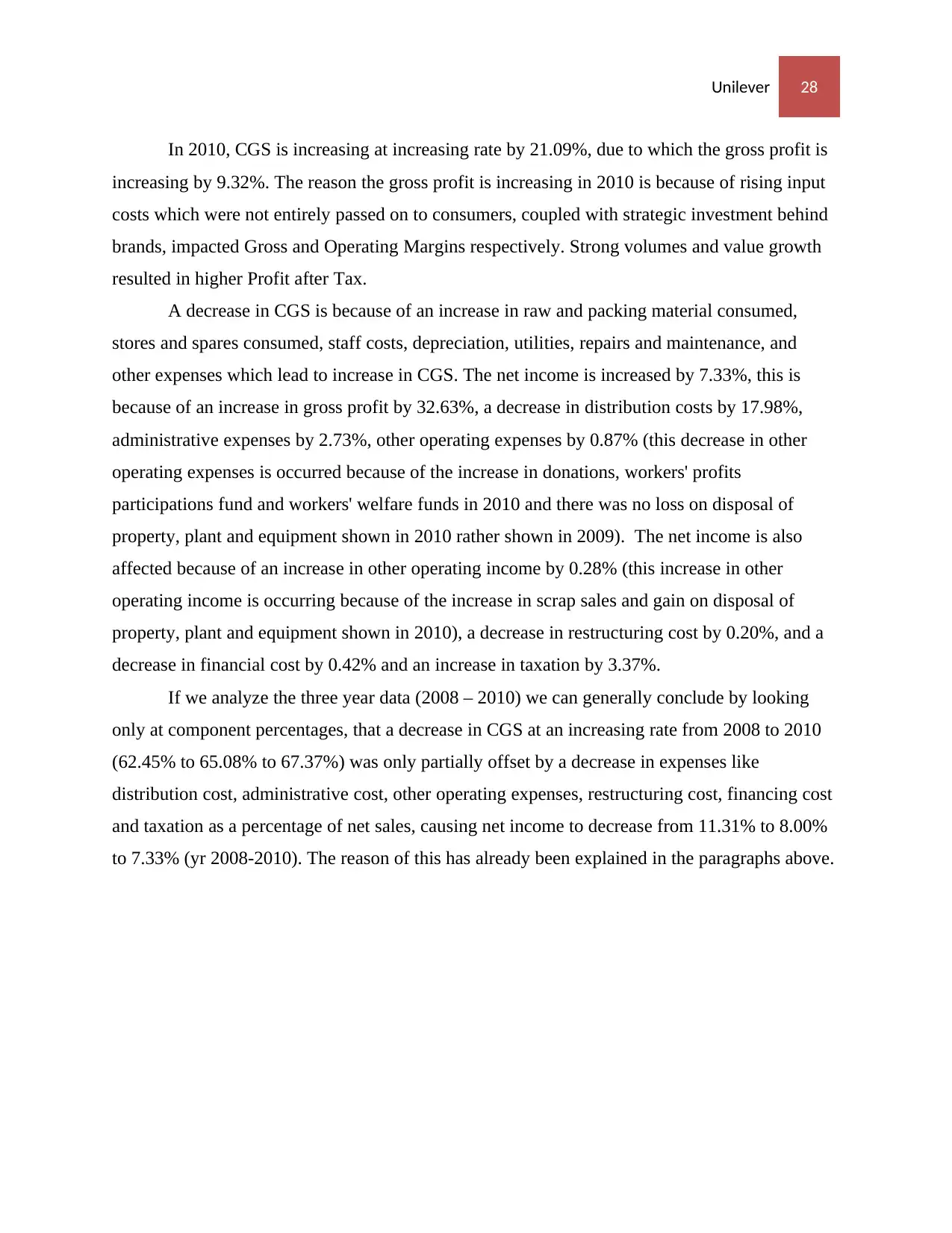
Unilever 28
In 2010, CGS is increasing at increasing rate by 21.09%, due to which the gross profit is
increasing by 9.32%. The reason the gross profit is increasing in 2010 is because of rising input
costs which were not entirely passed on to consumers, coupled with strategic investment behind
brands, impacted Gross and Operating Margins respectively. Strong volumes and value growth
resulted in higher Profit after Tax.
A decrease in CGS is because of an increase in raw and packing material consumed,
stores and spares consumed, staff costs, depreciation, utilities, repairs and maintenance, and
other expenses which lead to increase in CGS. The net income is increased by 7.33%, this is
because of an increase in gross profit by 32.63%, a decrease in distribution costs by 17.98%,
administrative expenses by 2.73%, other operating expenses by 0.87% (this decrease in other
operating expenses is occurred because of the increase in donations, workers' profits
participations fund and workers' welfare funds in 2010 and there was no loss on disposal of
property, plant and equipment shown in 2010 rather shown in 2009). The net income is also
affected because of an increase in other operating income by 0.28% (this increase in other
operating income is occurring because of the increase in scrap sales and gain on disposal of
property, plant and equipment shown in 2010), a decrease in restructuring cost by 0.20%, and a
decrease in financial cost by 0.42% and an increase in taxation by 3.37%.
If we analyze the three year data (2008 – 2010) we can generally conclude by looking
only at component percentages, that a decrease in CGS at an increasing rate from 2008 to 2010
(62.45% to 65.08% to 67.37%) was only partially offset by a decrease in expenses like
distribution cost, administrative cost, other operating expenses, restructuring cost, financing cost
and taxation as a percentage of net sales, causing net income to decrease from 11.31% to 8.00%
to 7.33% (yr 2008-2010). The reason of this has already been explained in the paragraphs above.
In 2010, CGS is increasing at increasing rate by 21.09%, due to which the gross profit is
increasing by 9.32%. The reason the gross profit is increasing in 2010 is because of rising input
costs which were not entirely passed on to consumers, coupled with strategic investment behind
brands, impacted Gross and Operating Margins respectively. Strong volumes and value growth
resulted in higher Profit after Tax.
A decrease in CGS is because of an increase in raw and packing material consumed,
stores and spares consumed, staff costs, depreciation, utilities, repairs and maintenance, and
other expenses which lead to increase in CGS. The net income is increased by 7.33%, this is
because of an increase in gross profit by 32.63%, a decrease in distribution costs by 17.98%,
administrative expenses by 2.73%, other operating expenses by 0.87% (this decrease in other
operating expenses is occurred because of the increase in donations, workers' profits
participations fund and workers' welfare funds in 2010 and there was no loss on disposal of
property, plant and equipment shown in 2010 rather shown in 2009). The net income is also
affected because of an increase in other operating income by 0.28% (this increase in other
operating income is occurring because of the increase in scrap sales and gain on disposal of
property, plant and equipment shown in 2010), a decrease in restructuring cost by 0.20%, and a
decrease in financial cost by 0.42% and an increase in taxation by 3.37%.
If we analyze the three year data (2008 – 2010) we can generally conclude by looking
only at component percentages, that a decrease in CGS at an increasing rate from 2008 to 2010
(62.45% to 65.08% to 67.37%) was only partially offset by a decrease in expenses like
distribution cost, administrative cost, other operating expenses, restructuring cost, financing cost
and taxation as a percentage of net sales, causing net income to decrease from 11.31% to 8.00%
to 7.33% (yr 2008-2010). The reason of this has already been explained in the paragraphs above.
Secure Best Marks with AI Grader
Need help grading? Try our AI Grader for instant feedback on your assignments.
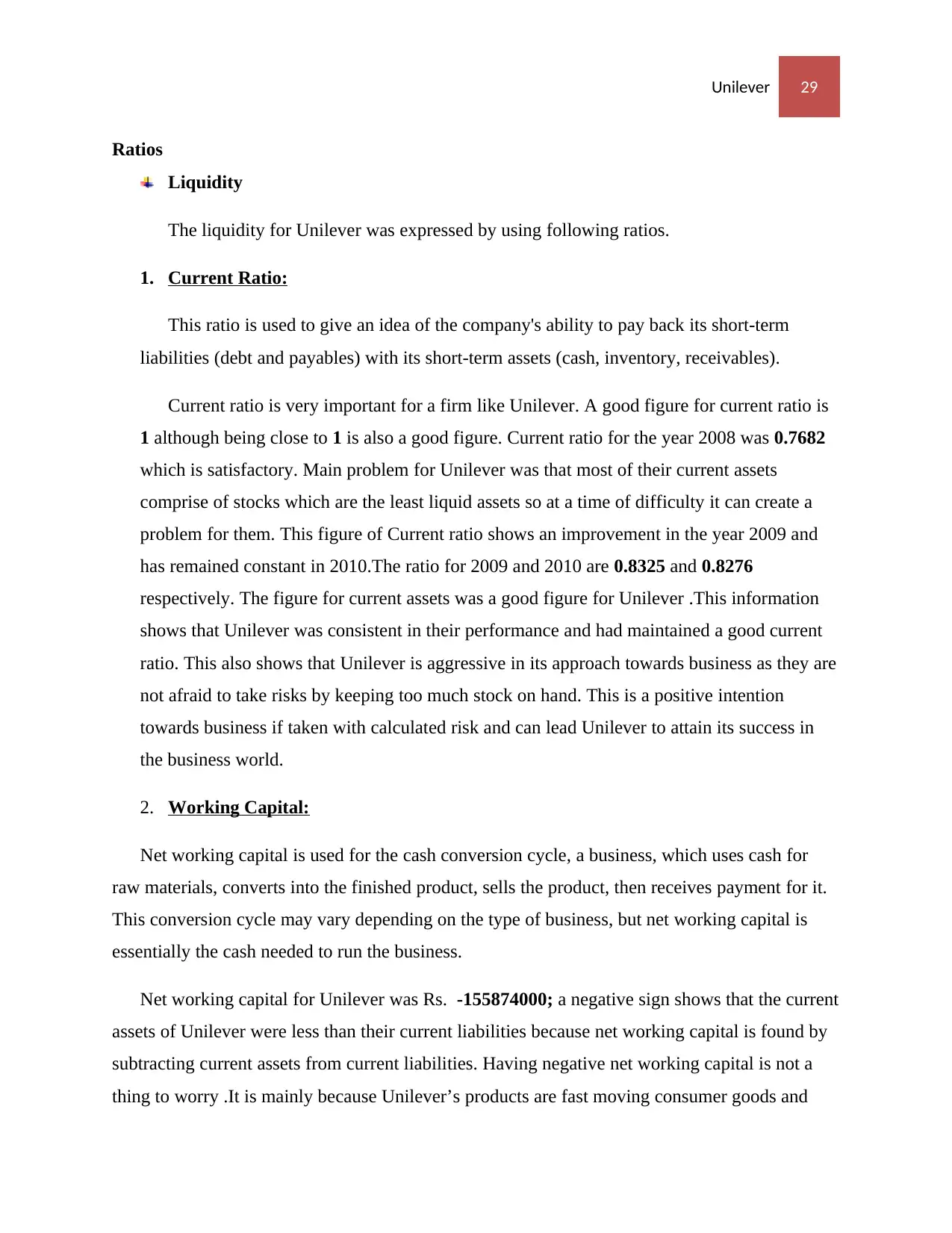
Unilever 29
Ratios
Liquidity
The liquidity for Unilever was expressed by using following ratios.
1. Current Ratio:
This ratio is used to give an idea of the company's ability to pay back its short-term
liabilities (debt and payables) with its short-term assets (cash, inventory, receivables).
Current ratio is very important for a firm like Unilever. A good figure for current ratio is
1 although being close to 1 is also a good figure. Current ratio for the year 2008 was 0.7682
which is satisfactory. Main problem for Unilever was that most of their current assets
comprise of stocks which are the least liquid assets so at a time of difficulty it can create a
problem for them. This figure of Current ratio shows an improvement in the year 2009 and
has remained constant in 2010.The ratio for 2009 and 2010 are 0.8325 and 0.8276
respectively. The figure for current assets was a good figure for Unilever .This information
shows that Unilever was consistent in their performance and had maintained a good current
ratio. This also shows that Unilever is aggressive in its approach towards business as they are
not afraid to take risks by keeping too much stock on hand. This is a positive intention
towards business if taken with calculated risk and can lead Unilever to attain its success in
the business world.
2. Working Capital:
Net working capital is used for the cash conversion cycle, a business, which uses cash for
raw materials, converts into the finished product, sells the product, then receives payment for it.
This conversion cycle may vary depending on the type of business, but net working capital is
essentially the cash needed to run the business.
Net working capital for Unilever was Rs. -155874000; a negative sign shows that the current
assets of Unilever were less than their current liabilities because net working capital is found by
subtracting current assets from current liabilities. Having negative net working capital is not a
thing to worry .It is mainly because Unilever’s products are fast moving consumer goods and
Ratios
Liquidity
The liquidity for Unilever was expressed by using following ratios.
1. Current Ratio:
This ratio is used to give an idea of the company's ability to pay back its short-term
liabilities (debt and payables) with its short-term assets (cash, inventory, receivables).
Current ratio is very important for a firm like Unilever. A good figure for current ratio is
1 although being close to 1 is also a good figure. Current ratio for the year 2008 was 0.7682
which is satisfactory. Main problem for Unilever was that most of their current assets
comprise of stocks which are the least liquid assets so at a time of difficulty it can create a
problem for them. This figure of Current ratio shows an improvement in the year 2009 and
has remained constant in 2010.The ratio for 2009 and 2010 are 0.8325 and 0.8276
respectively. The figure for current assets was a good figure for Unilever .This information
shows that Unilever was consistent in their performance and had maintained a good current
ratio. This also shows that Unilever is aggressive in its approach towards business as they are
not afraid to take risks by keeping too much stock on hand. This is a positive intention
towards business if taken with calculated risk and can lead Unilever to attain its success in
the business world.
2. Working Capital:
Net working capital is used for the cash conversion cycle, a business, which uses cash for
raw materials, converts into the finished product, sells the product, then receives payment for it.
This conversion cycle may vary depending on the type of business, but net working capital is
essentially the cash needed to run the business.
Net working capital for Unilever was Rs. -155874000; a negative sign shows that the current
assets of Unilever were less than their current liabilities because net working capital is found by
subtracting current assets from current liabilities. Having negative net working capital is not a
thing to worry .It is mainly because Unilever’s products are fast moving consumer goods and
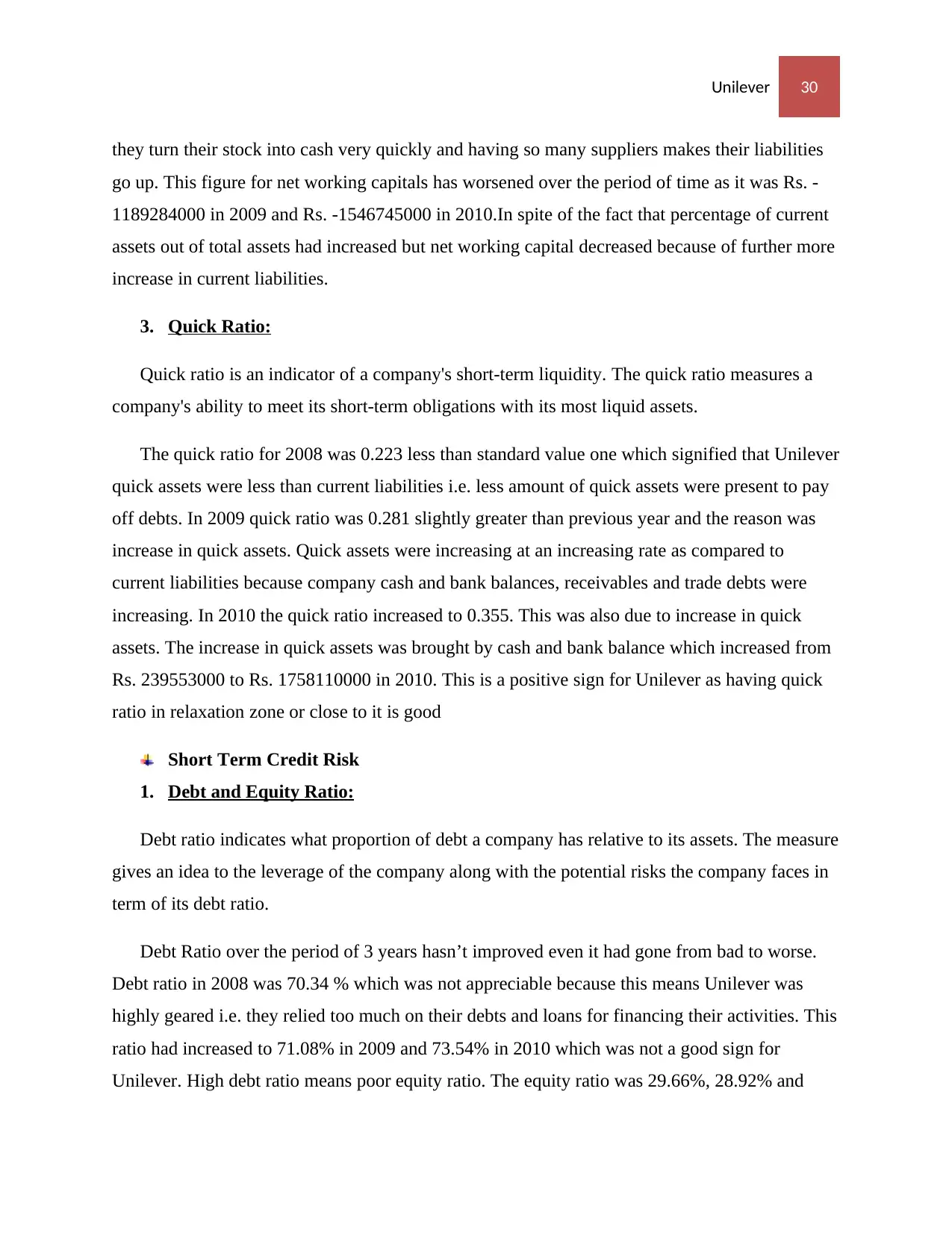
Unilever 30
they turn their stock into cash very quickly and having so many suppliers makes their liabilities
go up. This figure for net working capitals has worsened over the period of time as it was Rs. -
1189284000 in 2009 and Rs. -1546745000 in 2010.In spite of the fact that percentage of current
assets out of total assets had increased but net working capital decreased because of further more
increase in current liabilities.
3. Quick Ratio:
Quick ratio is an indicator of a company's short-term liquidity. The quick ratio measures a
company's ability to meet its short-term obligations with its most liquid assets.
The quick ratio for 2008 was 0.223 less than standard value one which signified that Unilever
quick assets were less than current liabilities i.e. less amount of quick assets were present to pay
off debts. In 2009 quick ratio was 0.281 slightly greater than previous year and the reason was
increase in quick assets. Quick assets were increasing at an increasing rate as compared to
current liabilities because company cash and bank balances, receivables and trade debts were
increasing. In 2010 the quick ratio increased to 0.355. This was also due to increase in quick
assets. The increase in quick assets was brought by cash and bank balance which increased from
Rs. 239553000 to Rs. 1758110000 in 2010. This is a positive sign for Unilever as having quick
ratio in relaxation zone or close to it is good
Short Term Credit Risk
1. Debt and Equity Ratio:
Debt ratio indicates what proportion of debt a company has relative to its assets. The measure
gives an idea to the leverage of the company along with the potential risks the company faces in
term of its debt ratio.
Debt Ratio over the period of 3 years hasn’t improved even it had gone from bad to worse.
Debt ratio in 2008 was 70.34 % which was not appreciable because this means Unilever was
highly geared i.e. they relied too much on their debts and loans for financing their activities. This
ratio had increased to 71.08% in 2009 and 73.54% in 2010 which was not a good sign for
Unilever. High debt ratio means poor equity ratio. The equity ratio was 29.66%, 28.92% and
they turn their stock into cash very quickly and having so many suppliers makes their liabilities
go up. This figure for net working capitals has worsened over the period of time as it was Rs. -
1189284000 in 2009 and Rs. -1546745000 in 2010.In spite of the fact that percentage of current
assets out of total assets had increased but net working capital decreased because of further more
increase in current liabilities.
3. Quick Ratio:
Quick ratio is an indicator of a company's short-term liquidity. The quick ratio measures a
company's ability to meet its short-term obligations with its most liquid assets.
The quick ratio for 2008 was 0.223 less than standard value one which signified that Unilever
quick assets were less than current liabilities i.e. less amount of quick assets were present to pay
off debts. In 2009 quick ratio was 0.281 slightly greater than previous year and the reason was
increase in quick assets. Quick assets were increasing at an increasing rate as compared to
current liabilities because company cash and bank balances, receivables and trade debts were
increasing. In 2010 the quick ratio increased to 0.355. This was also due to increase in quick
assets. The increase in quick assets was brought by cash and bank balance which increased from
Rs. 239553000 to Rs. 1758110000 in 2010. This is a positive sign for Unilever as having quick
ratio in relaxation zone or close to it is good
Short Term Credit Risk
1. Debt and Equity Ratio:
Debt ratio indicates what proportion of debt a company has relative to its assets. The measure
gives an idea to the leverage of the company along with the potential risks the company faces in
term of its debt ratio.
Debt Ratio over the period of 3 years hasn’t improved even it had gone from bad to worse.
Debt ratio in 2008 was 70.34 % which was not appreciable because this means Unilever was
highly geared i.e. they relied too much on their debts and loans for financing their activities. This
ratio had increased to 71.08% in 2009 and 73.54% in 2010 which was not a good sign for
Unilever. High debt ratio means poor equity ratio. The equity ratio was 29.66%, 28.92% and

Unilever 31
26.46% for three years. This could be because of Unilever relying too much on their investors
who can force them to liquidate their business at anytime if they are not able to pay off their
required payments and it’s not good for a business which is looking forward to work as a going
concern. Even though the total assets figure over the period of 3 years have increased but they
had not increased in proportion to total liabilities. Total liabilities figure in 2008 was Rs.
714390000 which increased to Rs. 8121630000 in 2009. This massive change was mainly
because of deferred taxation and retirement benefits obligation, trades and other payables figure
also increased a lot, the figure of total liabilities increased to Rs. 9928472000 which was another
big change in total liabilities whereas total assets figure in 2008 was Rs. 1015613000 which
increased to Rs. 11425715000. This figure was mainly changed because of increase in stocks of
trade and in 2010 it increased to $1350117 but still debt ratio increased.
Profitability
Measures of profitability are of interest to equity investors and management, and are
drawn primarily from the income statement. In deciding where to invest their money, equity
investors want to know how efficiently companies utilize resources. A common method of
evaluating the efficiency with which the financial resources are employed is to compute the rate
of return earned on these resources. This rate is called the return on investment, or ROI. The
annual return (or profit) generated by the investment is stated as a percentage of the average
amount invested throughout the year. ROI has two common applications: return on assets and
return on equity.
Assets, such as cash, equipment, and property, are owned by the company for one reason—to
increase the business’s profitability and future wealth. One way to look at the effectiveness of
assets is to evaluate how well they are generating profits by focusing on the Return on Assets
(ROA).
1. Return on assets (ROA)
ROA is a measure of the productivity of assets, regardless of how the assets are financed.
Net Income/Total Assets: indicates how effectively the company is deploying its assets. In
26.46% for three years. This could be because of Unilever relying too much on their investors
who can force them to liquidate their business at anytime if they are not able to pay off their
required payments and it’s not good for a business which is looking forward to work as a going
concern. Even though the total assets figure over the period of 3 years have increased but they
had not increased in proportion to total liabilities. Total liabilities figure in 2008 was Rs.
714390000 which increased to Rs. 8121630000 in 2009. This massive change was mainly
because of deferred taxation and retirement benefits obligation, trades and other payables figure
also increased a lot, the figure of total liabilities increased to Rs. 9928472000 which was another
big change in total liabilities whereas total assets figure in 2008 was Rs. 1015613000 which
increased to Rs. 11425715000. This figure was mainly changed because of increase in stocks of
trade and in 2010 it increased to $1350117 but still debt ratio increased.
Profitability
Measures of profitability are of interest to equity investors and management, and are
drawn primarily from the income statement. In deciding where to invest their money, equity
investors want to know how efficiently companies utilize resources. A common method of
evaluating the efficiency with which the financial resources are employed is to compute the rate
of return earned on these resources. This rate is called the return on investment, or ROI. The
annual return (or profit) generated by the investment is stated as a percentage of the average
amount invested throughout the year. ROI has two common applications: return on assets and
return on equity.
Assets, such as cash, equipment, and property, are owned by the company for one reason—to
increase the business’s profitability and future wealth. One way to look at the effectiveness of
assets is to evaluate how well they are generating profits by focusing on the Return on Assets
(ROA).
1. Return on assets (ROA)
ROA is a measure of the productivity of assets, regardless of how the assets are financed.
Net Income/Total Assets: indicates how effectively the company is deploying its assets. In
Paraphrase This Document
Need a fresh take? Get an instant paraphrase of this document with our AI Paraphraser

Unilever 32
computation the return usually is defined as operating income, since income taxes and interest
expense are determined by factors other than the manner in which the assets are used.
A very low return on assets (ROA) usually indicates inefficient management, whereas a high
ROA means efficient management. This ratio can be distorted, however, by depreciation or any
unusual expenses.
ROA= Operating Income/ Average Total Assets
In 2008 we see that the company has 12.14% returns on asset ratio; however the company
has seen to increase its asset ratio to 79.47% in 2009. We also see that the ratio reduces to
39.88% in 2010. This trend shows us that the company’s best year for return on asset ratio was
2009 but the future prospects of the company on return on assets are reducing. A decrease in
return on assets may mean that assets grow faster than sales. By calculating the increase we see
that the assets do grow faster than the sales by approximately 2%.It's not a good trend.
The increase in the ROA from 2008 to 2009 is because the total assets have increased
from 1015613 to 11425715. This has also increased the average rate of the total assets showing
us an increase of approximately 67.33% in the year 2009.
However the ratio now decreases in year 2010 to 39.88% from previously 79.47%.
Although we see an increase in the total assets to 13501107 in 2010 but this increase is smaller
as compared to our net operating income which has increased drastically from 552,544 to
4,943,313. Therefore the simulatenous increases cause a overall decrease in the return on assets
ratio.
Most successful businesses earn a return on average total assets of, perhaps, 15% or
more. At this writing businesses must pay interest rates of between 6% and 12% to borrow
money. If a business is well managed and has good future prospects, management should be able
to earn a return on assets that is higher than the company’s cost of borrowing.
computation the return usually is defined as operating income, since income taxes and interest
expense are determined by factors other than the manner in which the assets are used.
A very low return on assets (ROA) usually indicates inefficient management, whereas a high
ROA means efficient management. This ratio can be distorted, however, by depreciation or any
unusual expenses.
ROA= Operating Income/ Average Total Assets
In 2008 we see that the company has 12.14% returns on asset ratio; however the company
has seen to increase its asset ratio to 79.47% in 2009. We also see that the ratio reduces to
39.88% in 2010. This trend shows us that the company’s best year for return on asset ratio was
2009 but the future prospects of the company on return on assets are reducing. A decrease in
return on assets may mean that assets grow faster than sales. By calculating the increase we see
that the assets do grow faster than the sales by approximately 2%.It's not a good trend.
The increase in the ROA from 2008 to 2009 is because the total assets have increased
from 1015613 to 11425715. This has also increased the average rate of the total assets showing
us an increase of approximately 67.33% in the year 2009.
However the ratio now decreases in year 2010 to 39.88% from previously 79.47%.
Although we see an increase in the total assets to 13501107 in 2010 but this increase is smaller
as compared to our net operating income which has increased drastically from 552,544 to
4,943,313. Therefore the simulatenous increases cause a overall decrease in the return on assets
ratio.
Most successful businesses earn a return on average total assets of, perhaps, 15% or
more. At this writing businesses must pay interest rates of between 6% and 12% to borrow
money. If a business is well managed and has good future prospects, management should be able
to earn a return on assets that is higher than the company’s cost of borrowing.
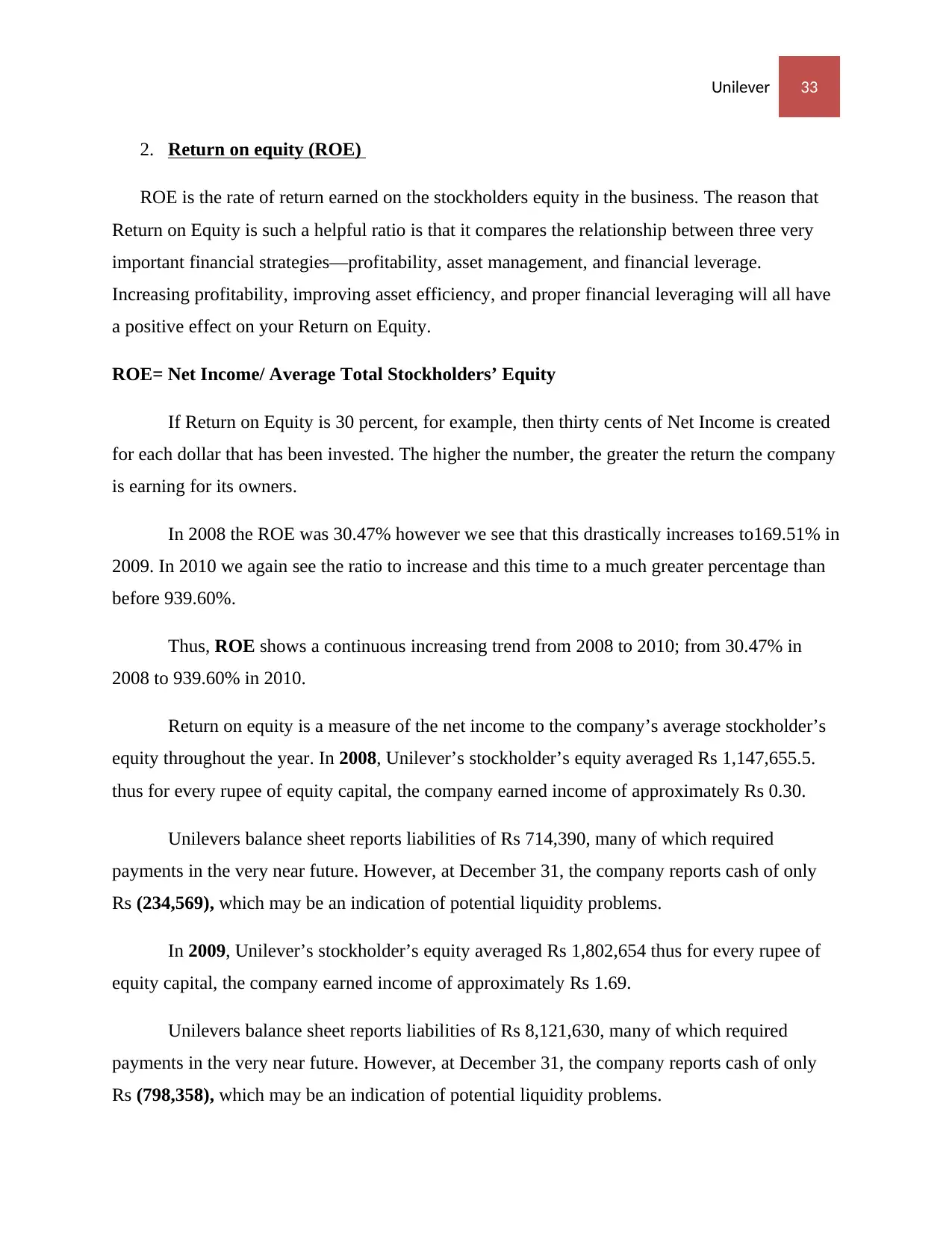
Unilever 33
2. Return on equity (ROE)
ROE is the rate of return earned on the stockholders equity in the business. The reason that
Return on Equity is such a helpful ratio is that it compares the relationship between three very
important financial strategies—profitability, asset management, and financial leverage.
Increasing profitability, improving asset efficiency, and proper financial leveraging will all have
a positive effect on your Return on Equity.
ROE= Net Income/ Average Total Stockholders’ Equity
If Return on Equity is 30 percent, for example, then thirty cents of Net Income is created
for each dollar that has been invested. The higher the number, the greater the return the company
is earning for its owners.
In 2008 the ROE was 30.47% however we see that this drastically increases to169.51% in
2009. In 2010 we again see the ratio to increase and this time to a much greater percentage than
before 939.60%.
Thus, ROE shows a continuous increasing trend from 2008 to 2010; from 30.47% in
2008 to 939.60% in 2010.
Return on equity is a measure of the net income to the company’s average stockholder’s
equity throughout the year. In 2008, Unilever’s stockholder’s equity averaged Rs 1,147,655.5.
thus for every rupee of equity capital, the company earned income of approximately Rs 0.30.
Unilevers balance sheet reports liabilities of Rs 714,390, many of which required
payments in the very near future. However, at December 31, the company reports cash of only
Rs (234,569), which may be an indication of potential liquidity problems.
In 2009, Unilever’s stockholder’s equity averaged Rs 1,802,654 thus for every rupee of
equity capital, the company earned income of approximately Rs 1.69.
Unilevers balance sheet reports liabilities of Rs 8,121,630, many of which required
payments in the very near future. However, at December 31, the company reports cash of only
Rs (798,358), which may be an indication of potential liquidity problems.
2. Return on equity (ROE)
ROE is the rate of return earned on the stockholders equity in the business. The reason that
Return on Equity is such a helpful ratio is that it compares the relationship between three very
important financial strategies—profitability, asset management, and financial leverage.
Increasing profitability, improving asset efficiency, and proper financial leveraging will all have
a positive effect on your Return on Equity.
ROE= Net Income/ Average Total Stockholders’ Equity
If Return on Equity is 30 percent, for example, then thirty cents of Net Income is created
for each dollar that has been invested. The higher the number, the greater the return the company
is earning for its owners.
In 2008 the ROE was 30.47% however we see that this drastically increases to169.51% in
2009. In 2010 we again see the ratio to increase and this time to a much greater percentage than
before 939.60%.
Thus, ROE shows a continuous increasing trend from 2008 to 2010; from 30.47% in
2008 to 939.60% in 2010.
Return on equity is a measure of the net income to the company’s average stockholder’s
equity throughout the year. In 2008, Unilever’s stockholder’s equity averaged Rs 1,147,655.5.
thus for every rupee of equity capital, the company earned income of approximately Rs 0.30.
Unilevers balance sheet reports liabilities of Rs 714,390, many of which required
payments in the very near future. However, at December 31, the company reports cash of only
Rs (234,569), which may be an indication of potential liquidity problems.
In 2009, Unilever’s stockholder’s equity averaged Rs 1,802,654 thus for every rupee of
equity capital, the company earned income of approximately Rs 1.69.
Unilevers balance sheet reports liabilities of Rs 8,121,630, many of which required
payments in the very near future. However, at December 31, the company reports cash of only
Rs (798,358), which may be an indication of potential liquidity problems.
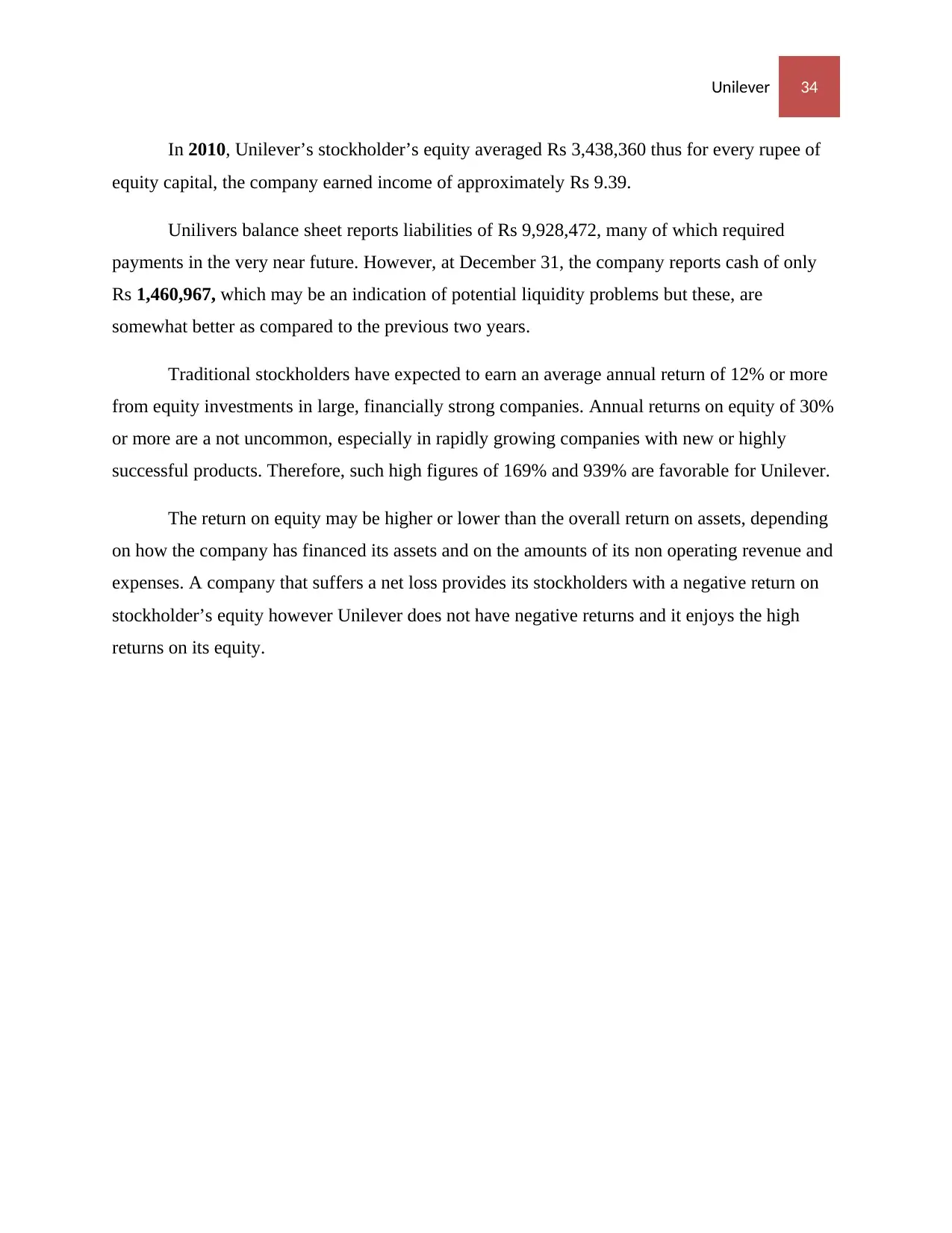
Unilever 34
In 2010, Unilever’s stockholder’s equity averaged Rs 3,438,360 thus for every rupee of
equity capital, the company earned income of approximately Rs 9.39.
Unilivers balance sheet reports liabilities of Rs 9,928,472, many of which required
payments in the very near future. However, at December 31, the company reports cash of only
Rs 1,460,967, which may be an indication of potential liquidity problems but these, are
somewhat better as compared to the previous two years.
Traditional stockholders have expected to earn an average annual return of 12% or more
from equity investments in large, financially strong companies. Annual returns on equity of 30%
or more are a not uncommon, especially in rapidly growing companies with new or highly
successful products. Therefore, such high figures of 169% and 939% are favorable for Unilever.
The return on equity may be higher or lower than the overall return on assets, depending
on how the company has financed its assets and on the amounts of its non operating revenue and
expenses. A company that suffers a net loss provides its stockholders with a negative return on
stockholder’s equity however Unilever does not have negative returns and it enjoys the high
returns on its equity.
In 2010, Unilever’s stockholder’s equity averaged Rs 3,438,360 thus for every rupee of
equity capital, the company earned income of approximately Rs 9.39.
Unilivers balance sheet reports liabilities of Rs 9,928,472, many of which required
payments in the very near future. However, at December 31, the company reports cash of only
Rs 1,460,967, which may be an indication of potential liquidity problems but these, are
somewhat better as compared to the previous two years.
Traditional stockholders have expected to earn an average annual return of 12% or more
from equity investments in large, financially strong companies. Annual returns on equity of 30%
or more are a not uncommon, especially in rapidly growing companies with new or highly
successful products. Therefore, such high figures of 169% and 939% are favorable for Unilever.
The return on equity may be higher or lower than the overall return on assets, depending
on how the company has financed its assets and on the amounts of its non operating revenue and
expenses. A company that suffers a net loss provides its stockholders with a negative return on
stockholder’s equity however Unilever does not have negative returns and it enjoys the high
returns on its equity.
Secure Best Marks with AI Grader
Need help grading? Try our AI Grader for instant feedback on your assignments.
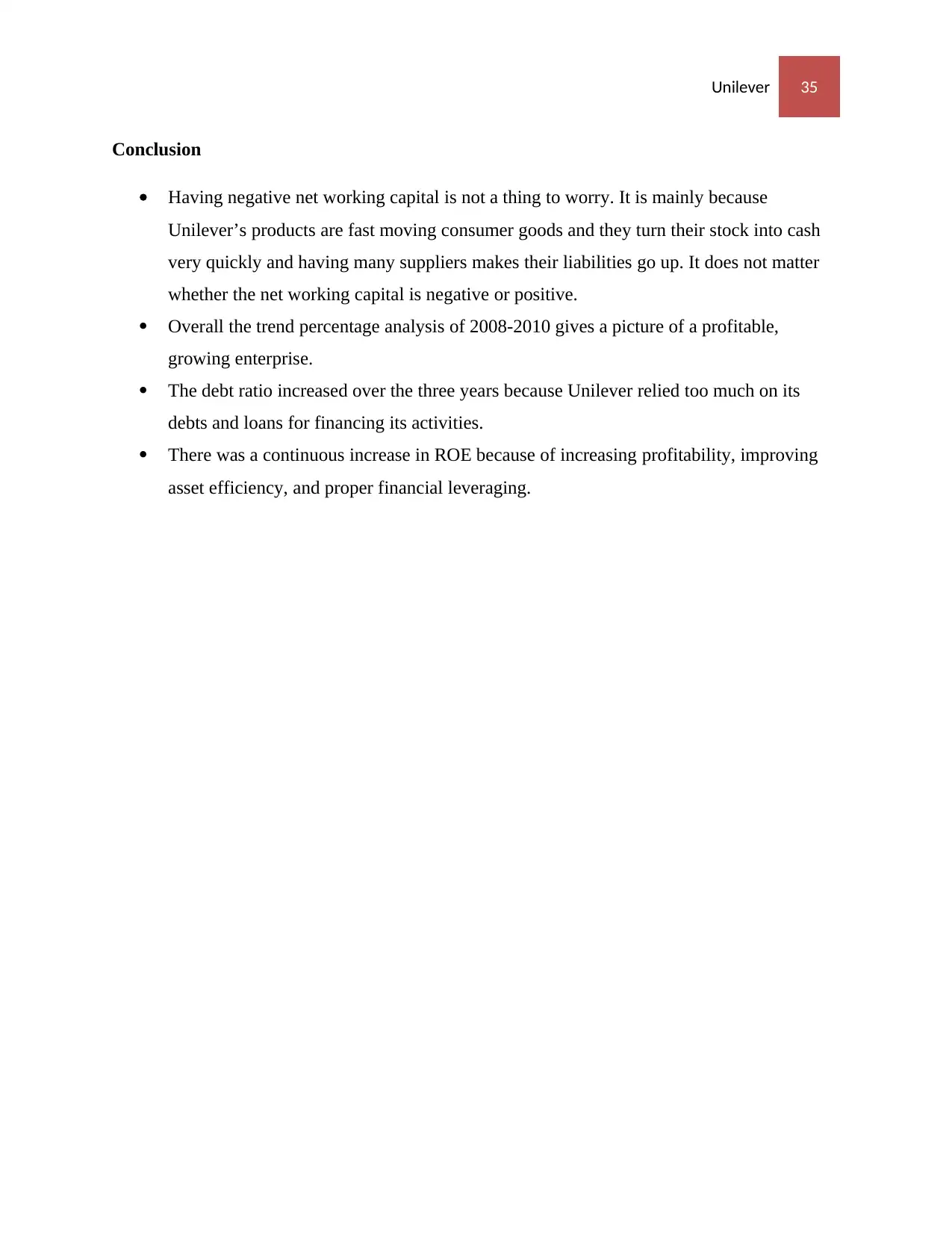
Unilever 35
Conclusion
Having negative net working capital is not a thing to worry. It is mainly because
Unilever’s products are fast moving consumer goods and they turn their stock into cash
very quickly and having many suppliers makes their liabilities go up. It does not matter
whether the net working capital is negative or positive.
Overall the trend percentage analysis of 2008-2010 gives a picture of a profitable,
growing enterprise.
The debt ratio increased over the three years because Unilever relied too much on its
debts and loans for financing its activities.
There was a continuous increase in ROE because of increasing profitability, improving
asset efficiency, and proper financial leveraging.
Conclusion
Having negative net working capital is not a thing to worry. It is mainly because
Unilever’s products are fast moving consumer goods and they turn their stock into cash
very quickly and having many suppliers makes their liabilities go up. It does not matter
whether the net working capital is negative or positive.
Overall the trend percentage analysis of 2008-2010 gives a picture of a profitable,
growing enterprise.
The debt ratio increased over the three years because Unilever relied too much on its
debts and loans for financing its activities.
There was a continuous increase in ROE because of increasing profitability, improving
asset efficiency, and proper financial leveraging.
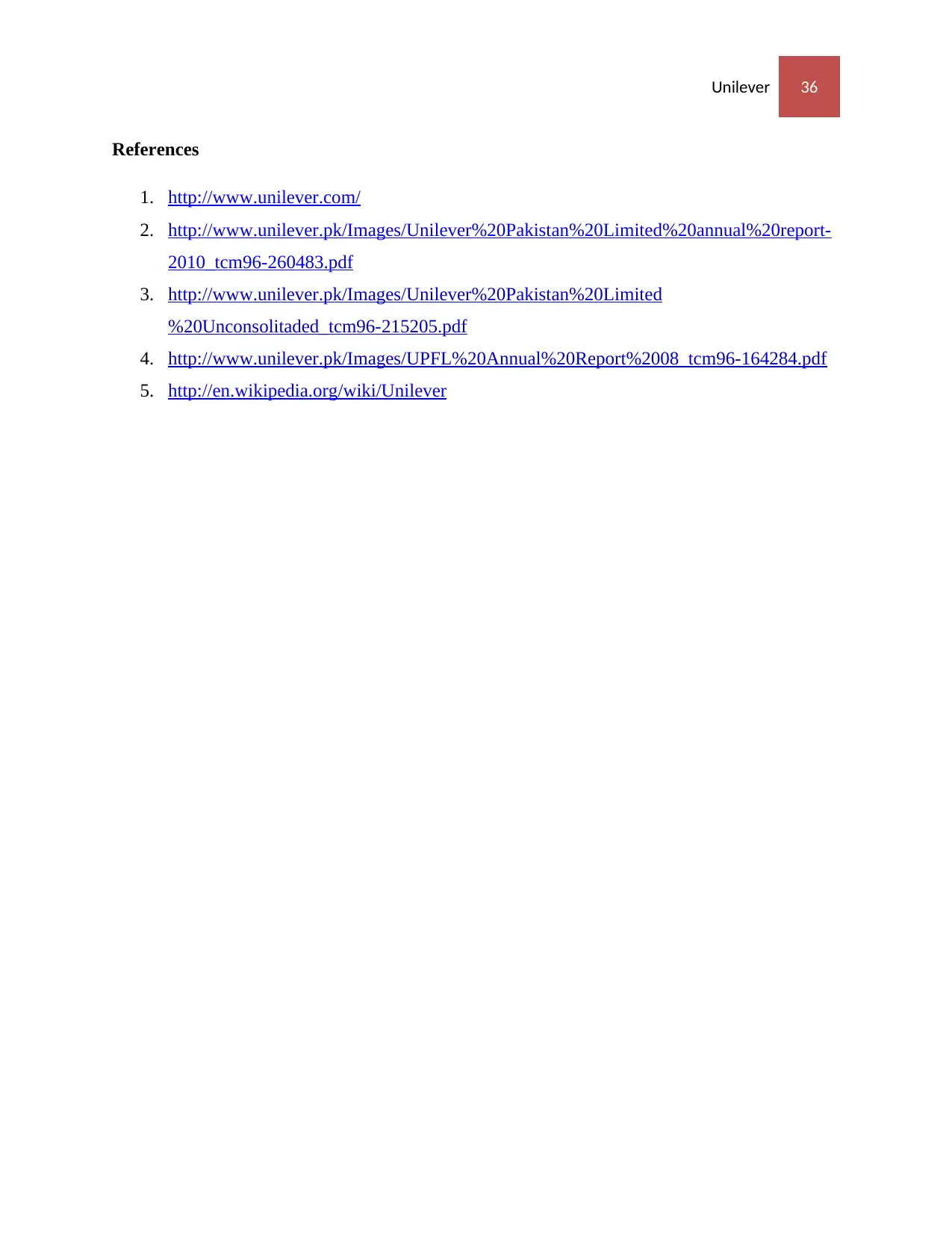
Unilever 36
References
1. http://www.unilever.com/
2. http://www.unilever.pk/Images/Unilever%20Pakistan%20Limited%20annual%20report-
2010_tcm96-260483.pdf
3. http://www.unilever.pk/Images/Unilever%20Pakistan%20Limited
%20Unconsolitaded_tcm96-215205.pdf
4. http://www.unilever.pk/Images/UPFL%20Annual%20Report%2008_tcm96-164284.pdf
5. http://en.wikipedia.org/wiki/Unilever
References
1. http://www.unilever.com/
2. http://www.unilever.pk/Images/Unilever%20Pakistan%20Limited%20annual%20report-
2010_tcm96-260483.pdf
3. http://www.unilever.pk/Images/Unilever%20Pakistan%20Limited
%20Unconsolitaded_tcm96-215205.pdf
4. http://www.unilever.pk/Images/UPFL%20Annual%20Report%2008_tcm96-164284.pdf
5. http://en.wikipedia.org/wiki/Unilever

Unilever 37
Appendix
Appendix
1 out of 37
Your All-in-One AI-Powered Toolkit for Academic Success.
+13062052269
info@desklib.com
Available 24*7 on WhatsApp / Email
![[object Object]](/_next/static/media/star-bottom.7253800d.svg)
Unlock your academic potential
© 2024 | Zucol Services PVT LTD | All rights reserved.

